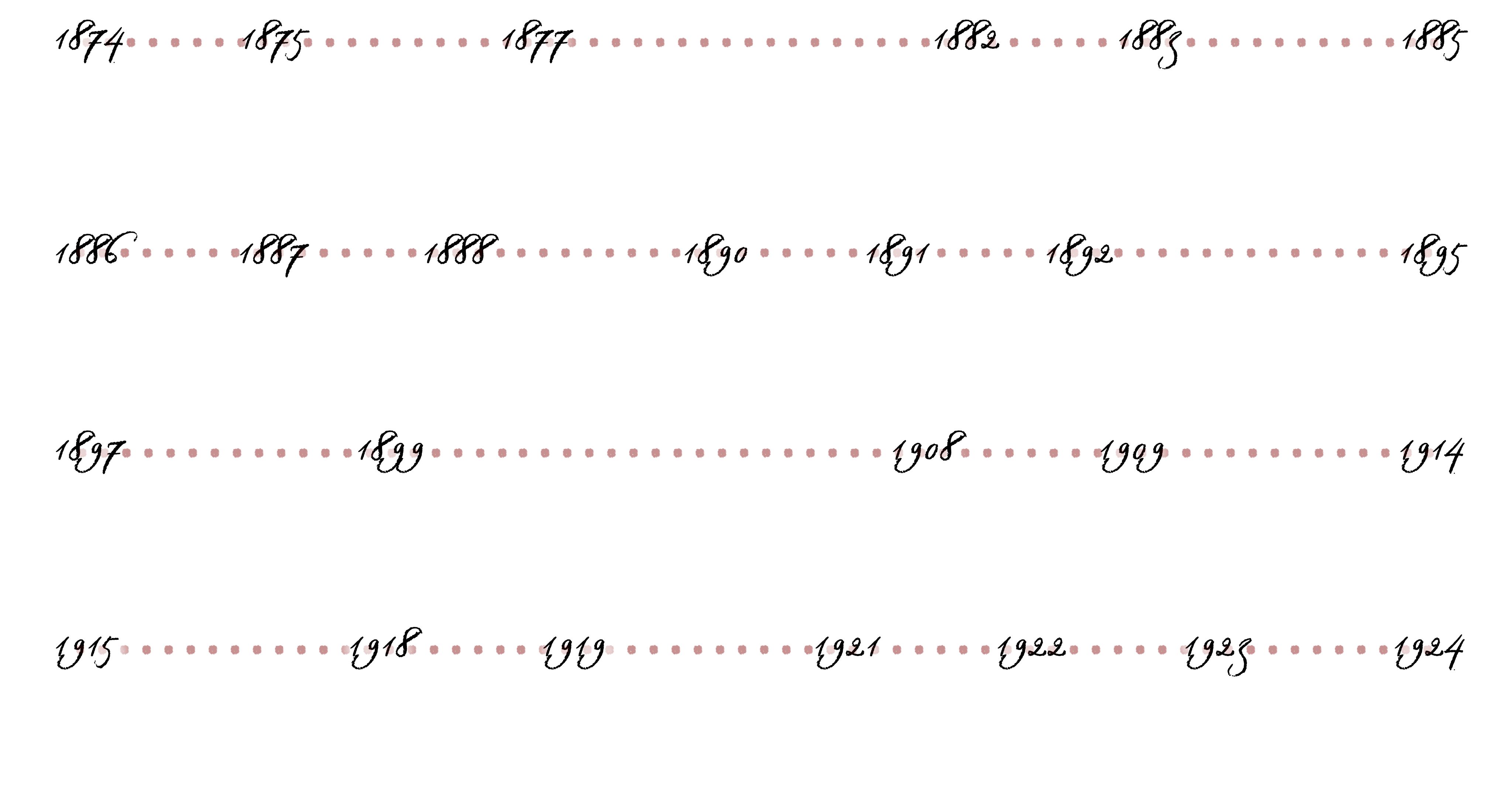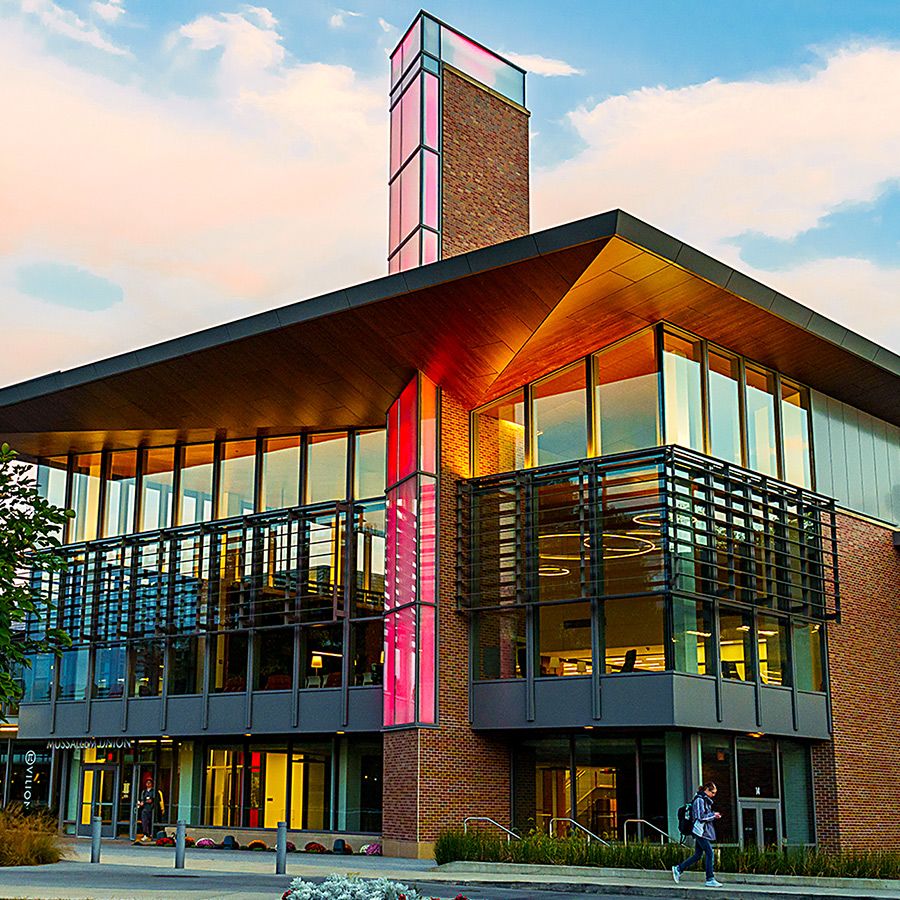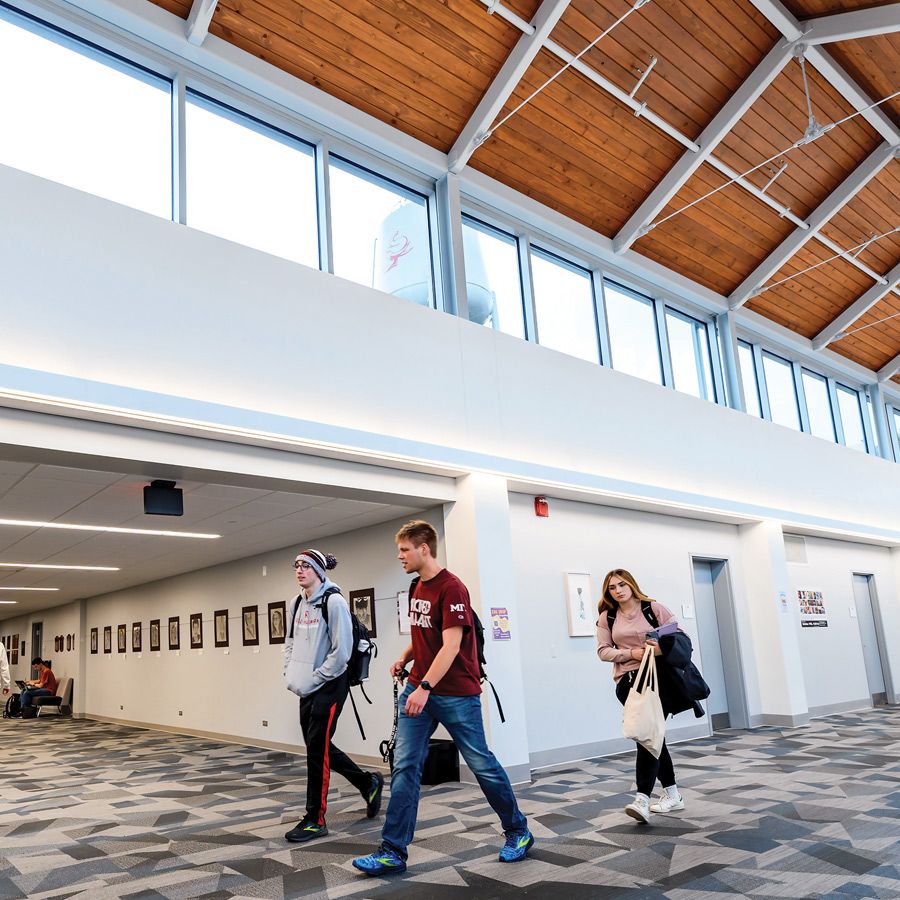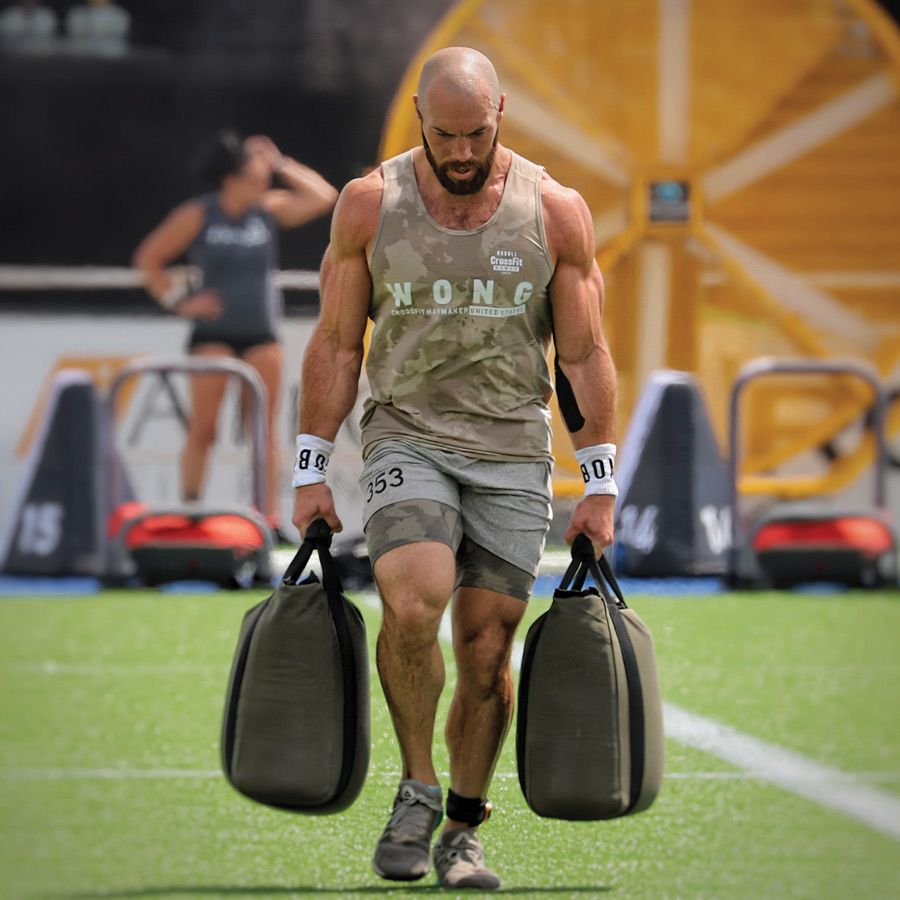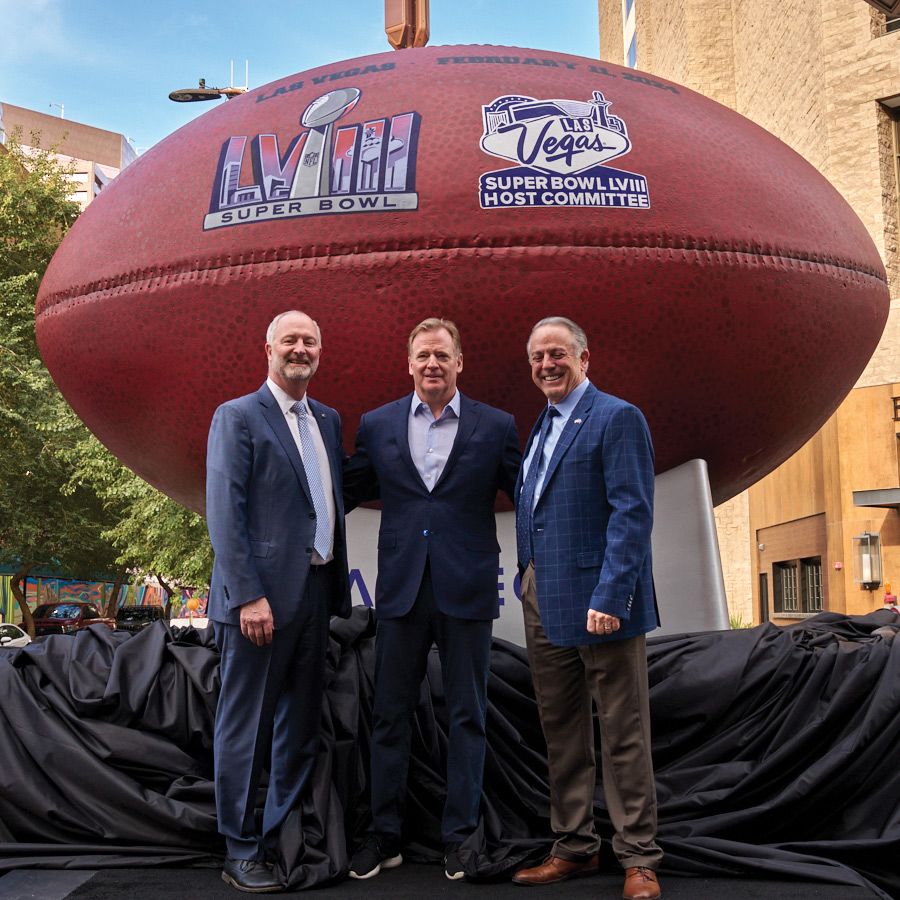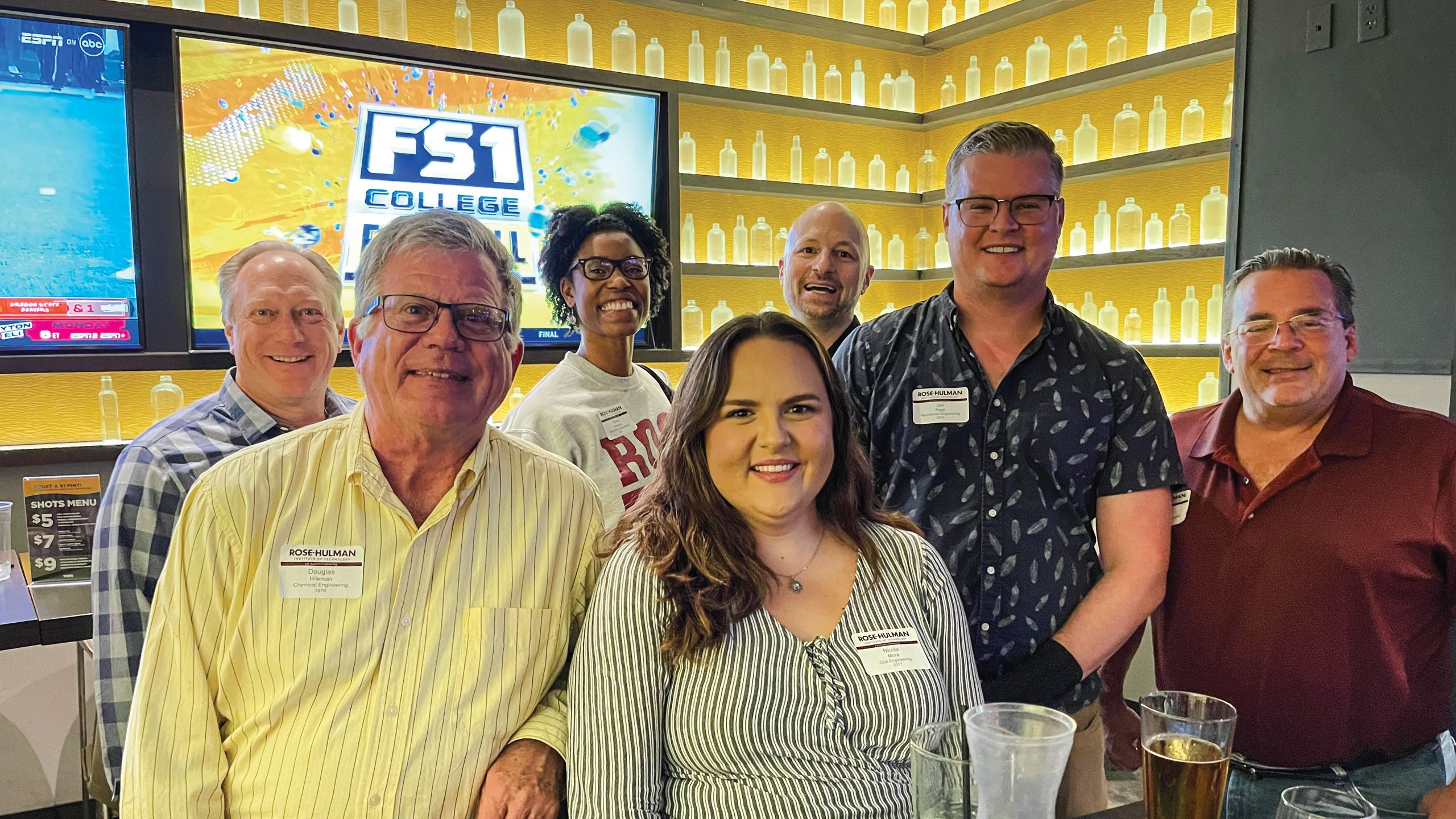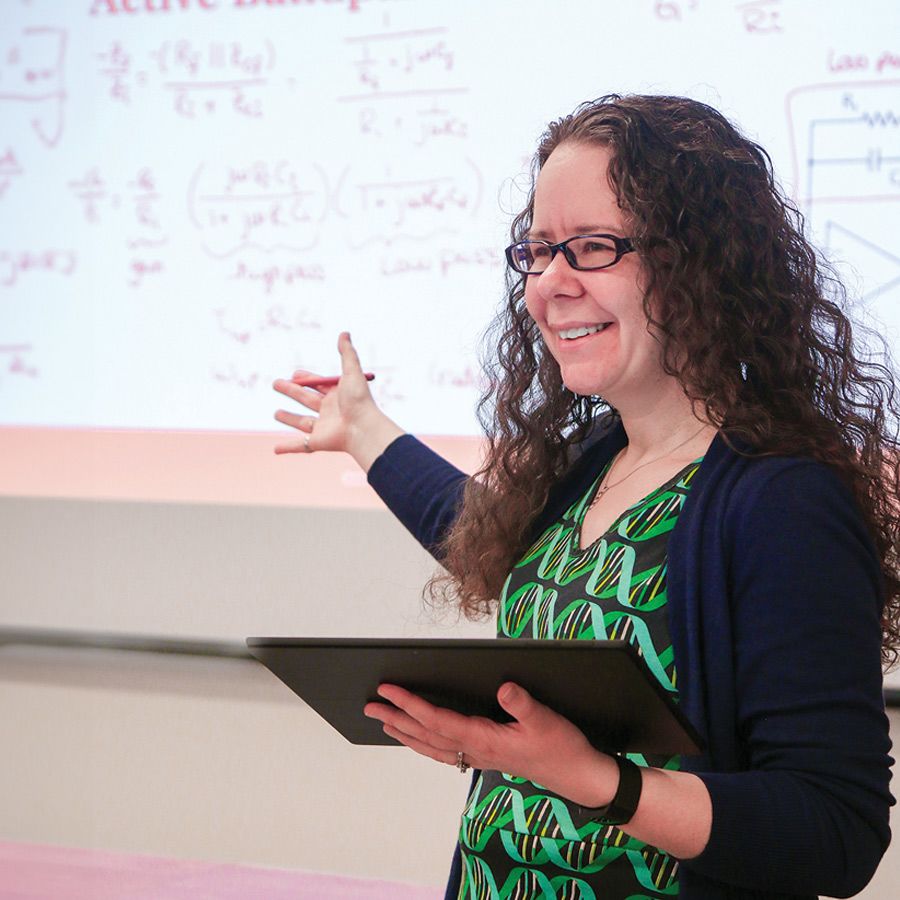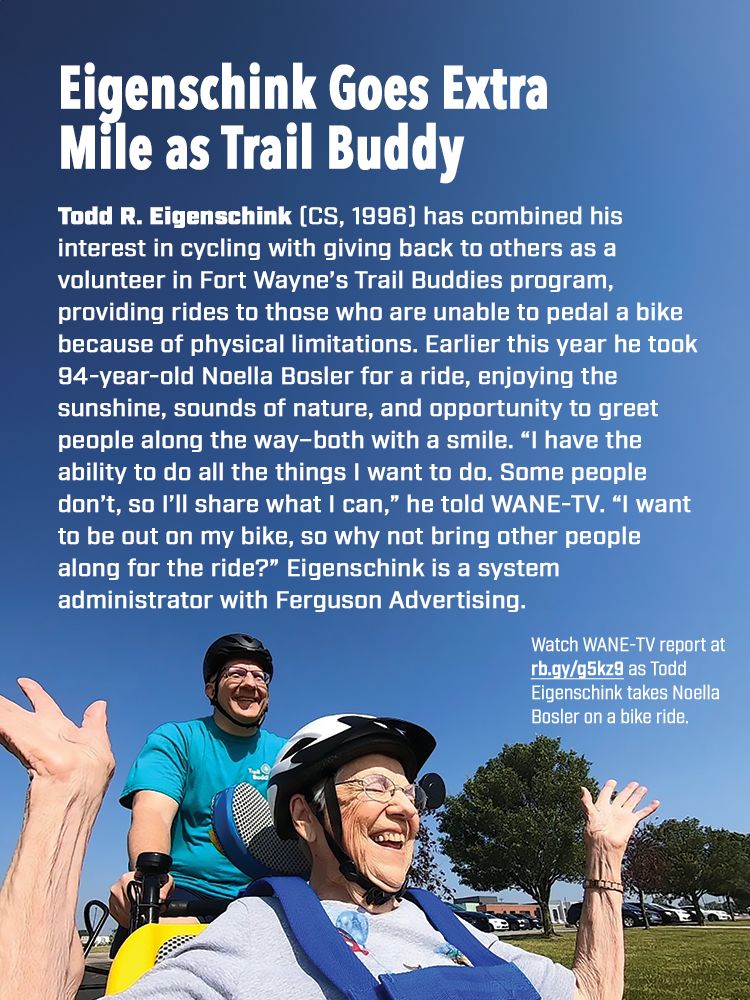
Contents
COVER STORY
Planting Seeds
LIGHTING UP THE SKIES AT HOMECOMING
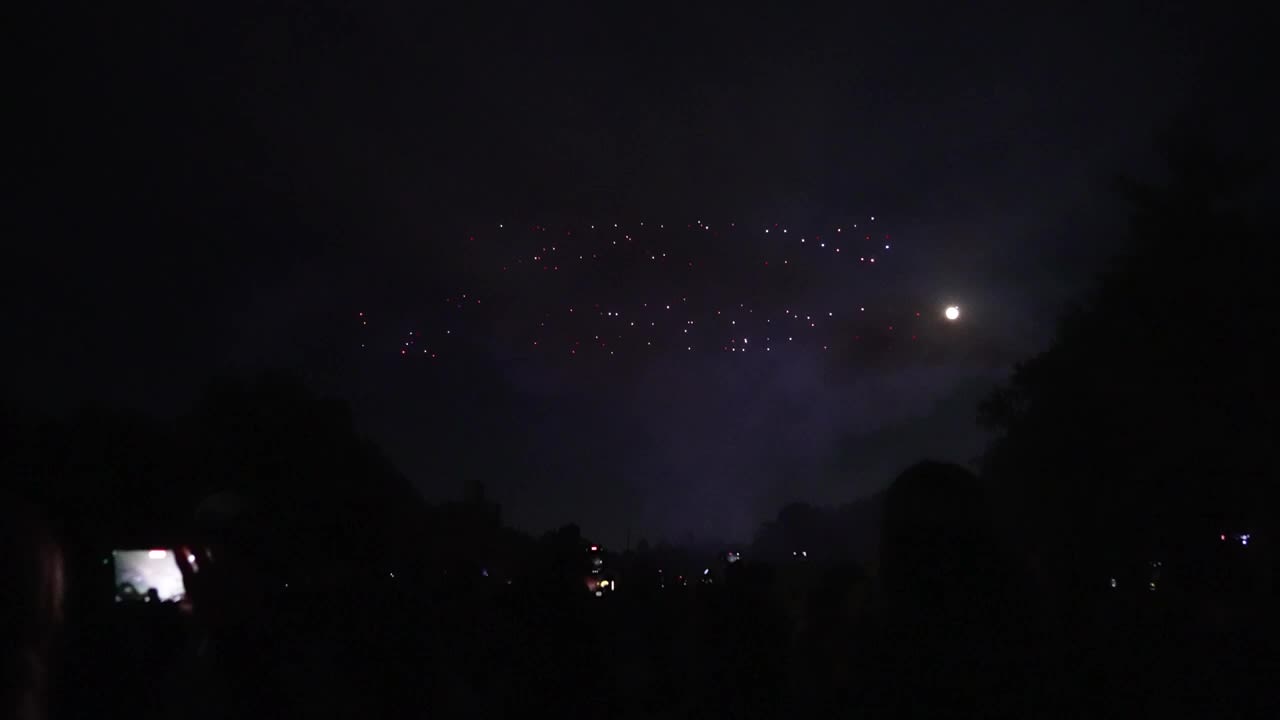
The 100th celebration of our Homecoming bonfire tradition surprised and dazzled alumni, family members, students, and other guests with a spectacular drone show that embodied the event’s special significance. Five hundred drones lit up the skies with images of Rose-Hulman’s familiar RH logo, Rosie mascot, a variety of STEM academic objects, an outhouse, and a cannon (whose blast ignited the bonfire and fireworks show). The show was designed by Texas-based Sky Elements, co-founded by alumnus Tyler Johnson (ME, 2016). “It was special to me that we designed something that people would appreciate and fondly remember,” he says. “I remember building the bonfire as a student and know how important Homecoming is to the Rose community. We wanted to plan a show that matched that significance."
Preliminary design discussions with Rose-Hulman officials started two months before the event and then turned toward developing 2D storyboard concepts for each object. Finally came the elaborate flight pattern layouts that brought each concept to life within the evening sky. “Everything is fully autonomous and takes a lot of coordination,” Johnson states.
Watch this year’s Homecoming bonfire drone show:


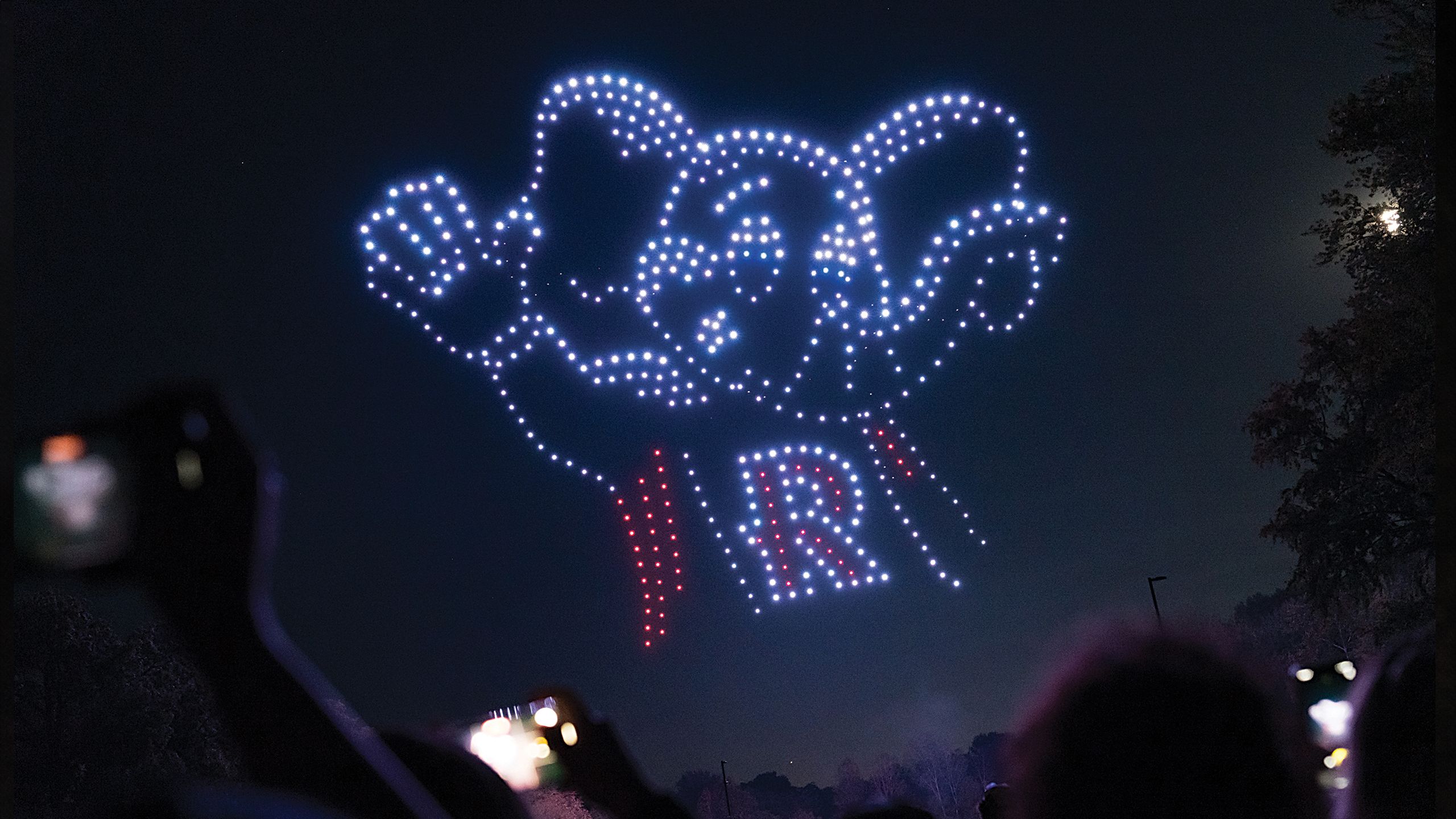
Career pathways created by Rose-Hulman’s educational environment infused with
innovation, intellectual rigor, and individual attention
were cited this fall with a No. 17 overall raking in the Wall Street Journal’s 2024 Best Colleges in America guide, listed alongside Princeton, Massachusetts Institute of Technology, Yale, Stanford, Columbia, and Harvard.
This was the first year the Institute had made the magazine’s list, based on student survey results. You will find Rose-Hulman in the following Best Colleges categories:
Students specifically cited interactions with faculty,
collaboration with other students,
available campus workspaces,
and satisfaction with physical classroom/teaching spaces.
25 Years Remaining #1 in U.S. News’ Engineering Ranking
A significant milestone was achieved with the Institute’s No. 1 ranking in U.S. News & World Report’s Best Colleges Guide for the 25th consecutive year! The ranking was based on an annual survey of U.S. college engineering deans and senior faculty in assessing colleges specializing in bachelor’s- and master’s-level engineering programs. Three academic department categories were ranked No. 1 this year: Civil engineering, electrical engineering, and mechanical engineering. The computer engineering program ranked No. 3. Meanwhile, computer science ranked 56th out of all colleges having such programs nationally, higher than last year.
Featured Again in Princeton Review’s Best 389 Colleges Guide
Rose-Hulman was ranked No. 1 for internships among private America’s private colleges and universities, and made the top-10 for career placement and career services in the 2024 edition of the Princeton Review’s Best 389 Colleges guide. The Institute also was listed among the publication’s Best Value Colleges, Best Midwest Colleges, and Best Green Colleges.
Keep track of our latest rankings
From the President
It is hard to believe that the holiday season is already upon us. Since our last issue of Echoes, the first quarter of the academic year has flown by, and there has been much to celebrate. As the New Year arrives bringing with it Rose-Hulman’s 150-year sesquicentennial anniversary, many more exciting things are ahead.
As we look back, in August we welcomed more than 575 new students from 40 states and 19 countries. They came to campus with a record of academic excellence paired with varied backgrounds and experiences. We’re now at nearly 2,250 students, almost an all-time record for total enrollment at Rose.
Shortly after classes began, Rose-Hulman once again earned the distinction from U.S. News and World Report as the No. 1 undergraduate engineering college in the U.S.–for the 25th consecutive year. A significant change for us this year, though, was that Rose-Hulman also made the Wall Street Journal’s “Best Colleges in America List” for the first time! The Institute is truly in notable company, as we ranked an impressive No. 17 in our debut. To give you an idea, others in the publication’s top 20 include Princeton, Massachusetts Institute of Technology, Yale, Stanford, Columbia, and Harvard. Rose also ranked No. 1 in learning outcomes and facilities, No. 2 in the likelihood of students/alumni recommending Rose-Hulman to others, and No. 4 in career preparation. We’re tremendously proud of these accomplishments and recognition!
We had a record turnout at Homecoming this fall, with more than 2,000 alumni, students, faculty, staff, and friends of the Institute attending the festivities, which included a spectacular RHIT-themed drone show.
If you were among the attendees, hopefully you were able to see some familiar sights on campus, as well as some new spaces–or a bit of both as in the case of historic Moench Hall, which just underwent a significant renovation. That project included a new student café, expanded study spaces, improved accessibility, updates to classrooms, labs, and office spaces, new heating and cooling systems, and an updated top-floor roof and skylight.
During Homecoming weekend, we also broke ground on a new $30 million residence hall for first-year students, which is set to open in Fall 2025. This four-floor structure will house 160 students, addressing a growing need and demand for campus housing.
Rose-Hulman was also the recipient of a $2.2 million grant from the U.S. Department of Commerce’s Economic Development Administration (EDA) to support our plans for the Innovation Grove initiative. This is a significant step forward in Rose-Hulman Ventures becoming the cornerstone of the developing Innovation Grove project on the Hulman Farm Property directly south of campus. There are a number of exciting opportunities being discussed for this space and I look forward to sharing more as they develop.
Also, this fall our Board of Trustees–under new leadership with the transition of Carl Cook to Board Chair and Linda White to Board Vice-Chair and Niles Noblitt having notably completed five years of service as Board Chair–approved our new long-term strategic plan. “Advancing by Design” will help guide our direction into the next decade and position Rose-Hulman for continued long-term success.
Of course, none of these accomplishments and celebrations could be achievable without the continued support and dedication from our alumni and friends. Thanks to each of you for all you do for Rose-Hulman.
I hope you enjoy this issue, as we begin our commemoration of Rose-Hulman’s 150 years of excellence and reflect on where we have been, where we are, and where we are going.

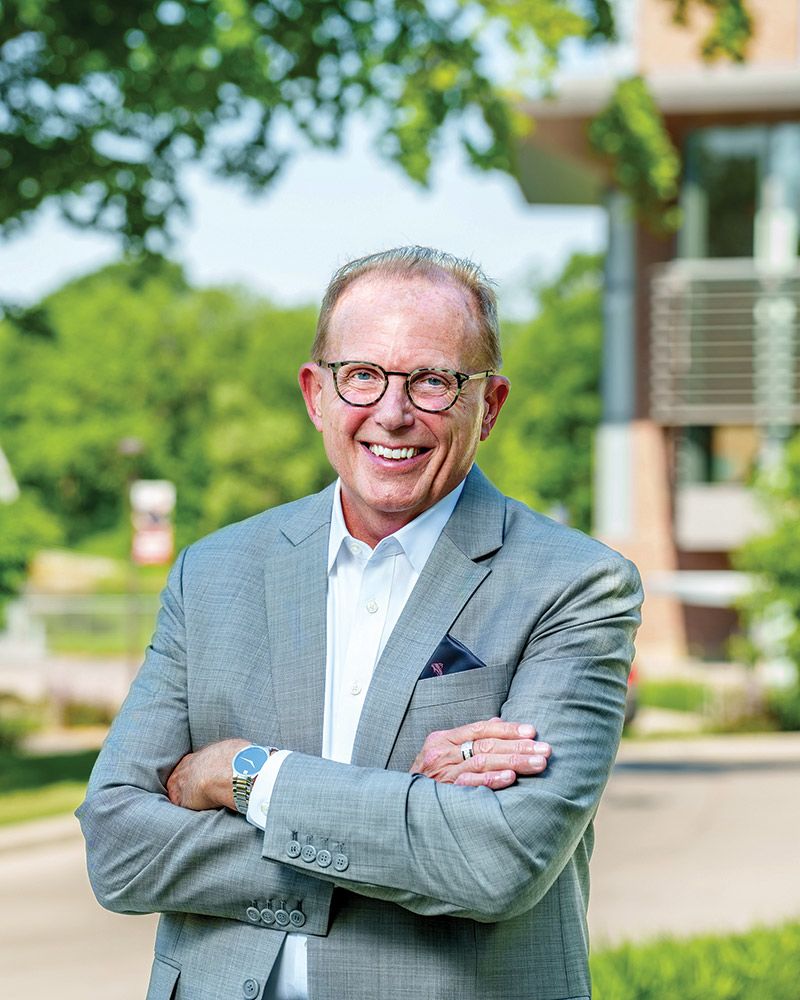
With goals to be bold, be visionary, and build upon its excellence in STEM education, in 2024 Rose-Hulman will launch its next long-term strategic plan “Advancing by Design.”
The results of this robust, stakeholder-focused, two-year planning process have been built into this comprehensive set of overarching themes and goals that will set a framework for the direction for the Institute over the next decade.
With this plan, we are charting the course for how Rose-Hulman can best meet the evolving demands of the shifting landscape in higher education.
With this strategic plan, we are reaffirming our dedication to producing forward-thinking, well-rounded graduates who will shape the future of the STEM fields.
The key Themes of the plan are to:
- Infuse sustainability into the Rose-Hulman Education and Culture
- Instill a Mindset of Innovation, Discovery, and Entrepreneurship
- Prepare Students to be Leaders in a Global and Diverse Society
- Increase the Affordability and Value of a Rose-Hulman Education
The Themes and associated Goals were developed to be the long-term focus of the plan. However, we will periodically review those to ensure that they still align with the needs of the Institute. The Strategic Actions for each Theme were created with the intention of reviewing and updating them on approximately a three-year cycle.
This plan is unique and was specifically developed in this way to balance the need to take a long-term perspective while also allowing flexibility to be responsive and adapt to changing circumstances over that 10-year period.
Many individual stakeholders were involved in the planning process, including faculty, staff, students, alumni, members of the Board of Trustees, corporate partners, and external consultants. Their significant efforts have enabled us to chart the future of Rose-Hulman. This plan serves as a roadmap, guiding us through the opportunities and challenges that lie ahead.
Your engagement, feedback, and dedication will be vital as we embark on this transformative journey together. The next decade holds incredible promise. Together, we can advance the future of Rose-Hulman and inspire generations to come.
View the full plan

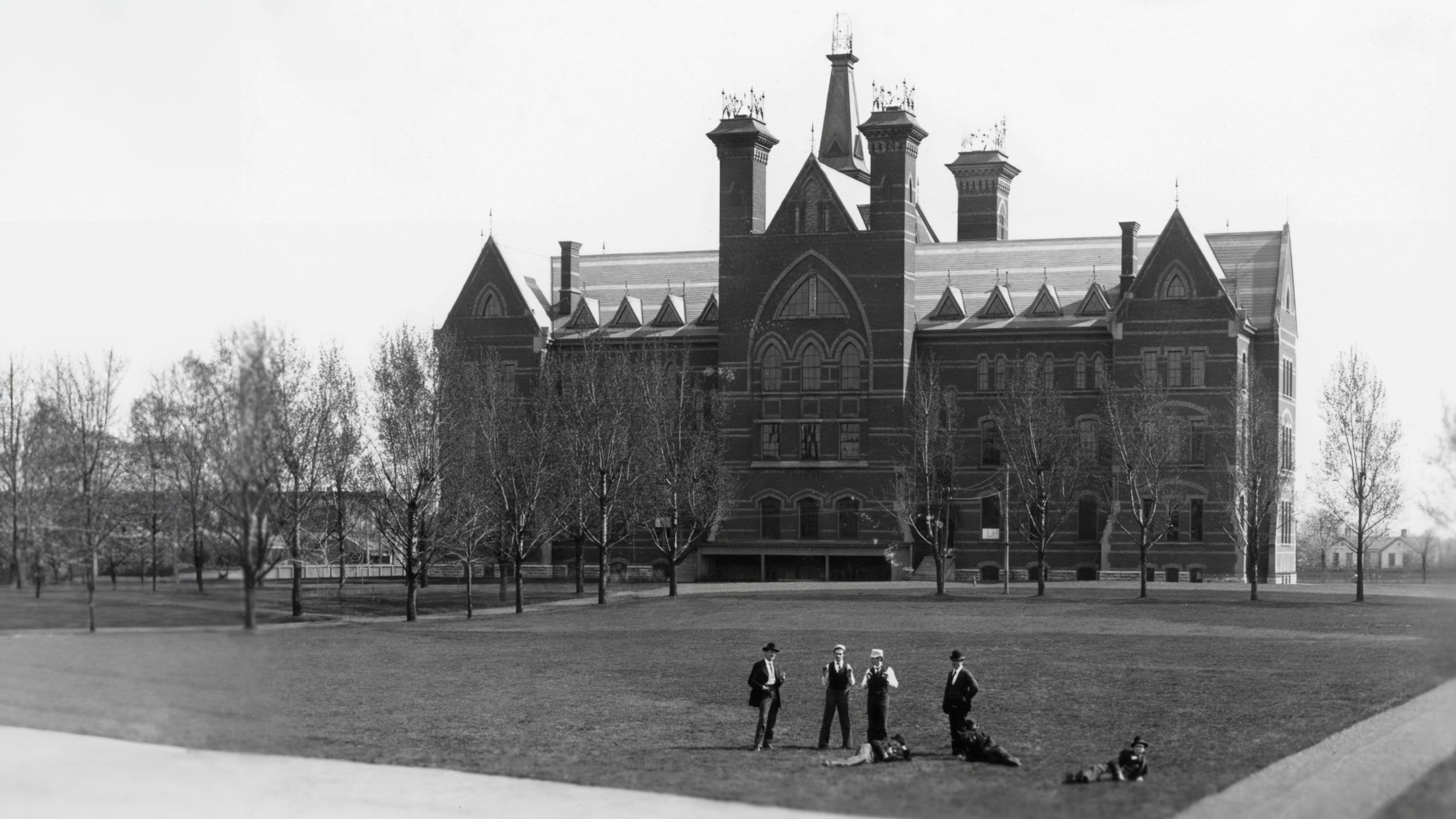
FIRST 50 YEARS
LAID FOUNDATION FOR INSTITUTE
TO BECOME ELITE STEM COLLEGE
SETTING THE SCENE for celebrating the 150th anniversary of Rose-Hulman’s founding in 1874, Echoes will provide retrospectives about the Institute in three 50-year special sections. This first segment examines the time between the college’s founding in 1874 in Terre Haute and when it began settling into its present campus location. The Summer 2024 issue will examine the 1925-1974 time period and Winter 2024 will feature the exciting events that happened from 1975 to present time. Each era was significant in establishing the college a national leader in undergraduate science, technology, engineering, and mathematics (STEM) education.
Like the beautiful flower that’s emblematic of its name, Rose-Hulman’s roots were delicately planted in 1874, when entrepreneur and philanthropist Chauncey Rose and a group of nine local business colleagues established the Terre Haute School of Industrial Science that soon was renamed Rose Polytechnic Institute (over Chauncey Rose’s strong objections).
Rose, a Connecticut native with Scottish heritage who had settled in western Indiana, made his fortune in railroads, real estate, banking, and other ventures. Having encountered difficulties finding qualified local engineers for his railroad projects, he aimed to create an institution that would provide technical training to meet the needs of Indiana’s industrial growth.
In its first 50 years, Rose Poly laid the foundations to become an elite technological university.
Rigorous academics, a close-knit community, dedicated faculty, practical training, and relationships between industry, community, and campus characterized the early Rose experience. These core tenets established in the pioneering days continue to guide the Institute as it celebrates its 150th anniversary in 2024.
Following construction and hiring of faculty and staff for the original campus location at the corner of 13th and Locust Streets in Terre Haute, on March 7, 1883, Rose Poly began classes with an inaugural class of 25 students. All were male, mostly local, and all majored in mechanical engineering. Admission standards were strict from the outset and all prospective students were required to show a proficiency of math, science, and the humanities.
The first president, Charles O. Thompson, PhD, modeled Rose Poly’s curriculum after Worcester Polytechnic Institute and European colleges. The education balanced theoretical coursework in math and science with practical training in engineering techniques. Required classes included physics, chemistry, calculus, technical drawing, shop practice, and foreign languages like German, French, and Spanish. Students also had to complete senior theses based on original research.
In the early years, money was a perpetual concern. Faculty often took pay cuts to remain at the fledgling institute. But the school steadily grew, reaching an enrollment of over 200 students by 1903. Campus life revolved around academic clubs, music ensembles, student publications, and athletics like football and baseball. Greek social fraternities provided the bonds of brotherhood, with chapters of Alpha Tau Omega, Sigma Nu, Lambda Chi Alpha, Theta Xi, and others following.
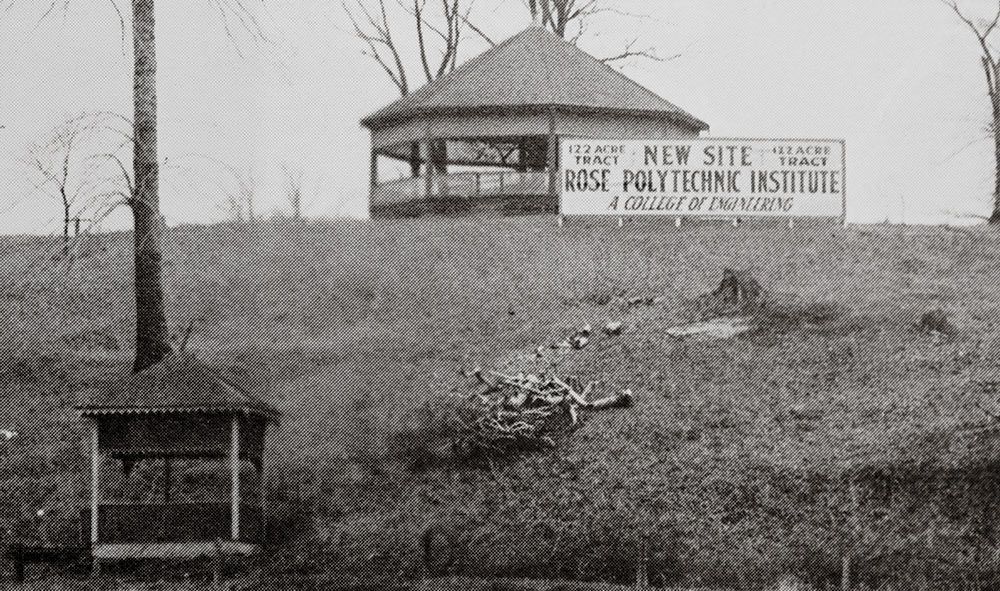
As the Institute’s enrollment and programs grew, so did the need for more space; Herman and Anton Hulman donated 123 acres on the east of Terre Haute for a new campus.
As the Institute’s enrollment and programs grew, so did the need for more space; Herman and Anton Hulman donated 123 acres on the east of Terre Haute for a new campus.
By 1917, something had to change. The original buildings could no longer contain the student body and programs and there was no room for sustained growth for academic and student life programs. Local philanthropists Herman and Anton Hulman stepped forward, donating 123 acres of family farmland east of Terre Haute along U.S. 40. This spacious new property allowed the institute to expand its vision.

A model of the Main Building (now known as Moench Hall)
A model of the Main Building (now known as Moench Hall)
Construction began in 1922 on the first two buildings of the new campus. The 80,600 square foot Main Building (now known as Moench Hall) originally contained classrooms, laboratories, a library, administrative offices, and other facilities. Deming Hall provided the first on-campus housing for students, allowing more to immerse themselves in the Rose Poly experience.

Opened in 1922, Rose Poly’s new Main Building had classrooms and labs, administrative offices, a library, and other facilities. But the campus didn’t have a residence hall.
Opened in 1922, Rose Poly’s new Main Building had classrooms and labs, administrative offices, a library, and other facilities. But the campus didn’t have a residence hall.
In a letter to the Rose faculty in 1919, esteemed President Carl Leo Mees, PhD, stated, “Rose is not a one-man institution but has been built upon the foundation of united work, enthusiastic endeavor, the submergence of purely individual interest, and self-sacrificing effort to its best development and work of its faculty...I believe the time has come when with a little more patience and forbearance and united effort bright things are in store for you all and the Institute in the near future.”
ACADEMIC ENVIRONMENT
ALWAYS BEEN CHALLENGING
Blazing trails with a rigorous academic environment has always been at the core of the institute. Founder Chauncey Rose commissioned two of his closest business associates to make a thorough inspection of all of America’s polytechnic colleges. This lengthy report along with insight from visits to European technological institutions by Thompson would become the basis of the new college’s curriculum.
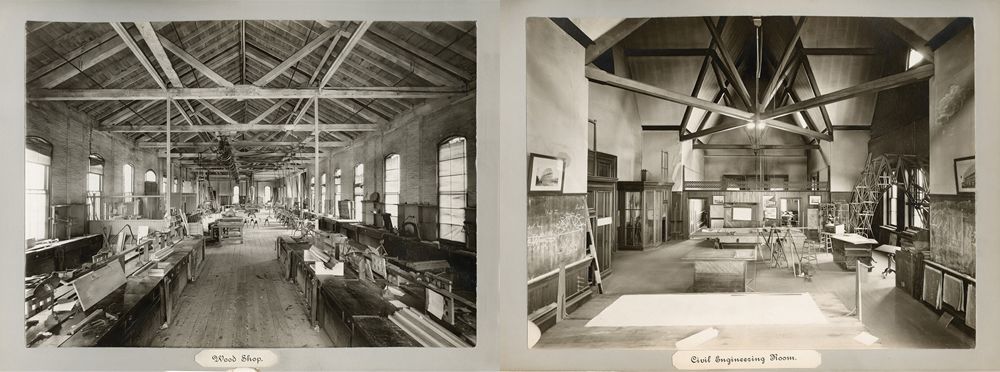
The Wood Shop and Civil Engineering Room were within the original Rose Poly campus’ academic buildings.
The Wood Shop and Civil Engineering Room were within the original Rose Poly campus’ academic buildings.
Thompson emphasized that teaching was the “destined end and way” for any educational institution. In his inaugural address, he explained that the college should offer four years of study, with the first year including a significant amount of “practice work” or shop work, that would emphasize more studies of the humanities than usual engineering programs. He also believed in a sensible balance between theory and practice, with a narrow focus on producing engineers
who would be an asset to their professions.
The first president stated, “the engineer is distinct from the artisan or craftsman by exactly the amount of his knowledge of the scientific principles which underlie the practice of his profession and his resulting ability to apply those principles to the ready and complete solution of real problems as they arise.
Rose-Hulman students continue to benefit from this original insight.
After its founding, the institute’s engineering curriculum expanded from mechanical engineering to include civil and electrical engineering, along with chemistry and architecture. Rose Poly was the first college west of the Allegheny Mountains to offer
a degree in chemical engineering in 1889. The first master’s degree was awarded in 1892 to Toro Tsuiji, a son of a member of Japan ruling legislature.
STUDENT DINNERS HAVE
LONG BEEN A STUDENT LIFE FIXTURE
Since Rose Poly’s original campus had no residence halls until Deming Hall was opened in 1926, students took advantage of dining together in groups at restaurants or eating clubs throughout Terre Haute.
That practice is now known as Floor Dinners, with residence hall members sharing nightly meals together at a table in the student union.
Meanwhile, extracurricular activities were an important part of the earlier years of the institute. Some of the first organized clubs were the Telegraph Association, Orchestral Club, Modulus yearbook, Young Men’s Christian Association (YMCA), Scientific Society, Rose Technic magazine, and Student Council.
Athletics were integrated into campus life soon after the college’s founding, even though there was no gymnasium in the original campus buildings. In 1891, Rose Poly won the Indiana Intercollegiate Athletic Association’s baseball championship, topping DePauw University (second), Purdue University (third), and Indiana University (fourth). Cycling was one of the biggest athletic endeavors, with groups of cyclists making occasional journeys from Terre Haute to West Terre Haute and Marshall, Illinois. Soon thereafter, students proposed raising money for the construction of a gym and supporting athletics.
In 1899, the Student Council elected to assess a $10 fee from each student—called The Student Fund—that was divided in the following proportions to support student organizations: Athletic Association, 40%; Rose Technic, 15%; YMCA, 12%; Scientific Society, 3%; Telegraph Association, 2½%; and Camera Club, 2½%. The remaining 25% supported other groups and student activities through a General Fund.
HISTORICALLY SPEAKING
Strong Job Placement …
for the Class of 1910
President Carl Leo Mees reported that nearly all of Rose Poly’s Class of 1910 had been placed in excellent positions and that the demand for graduates was much greater than the college could supply.
Hulman Farm Wasn’t First Choice
for New Campus
Rose Poly’s governing Board of Managers considered two locations for moving the college from its original downtown Terre Haute location. The first, known as the Orm Property, was purchased, but later abandoned when additional land couldn’t be obtained. Then, a 40-acre tract of land near Fort Harrison Road was purchased. However, the City of Terre Haute desired this site for a new park. Soon thereafter, a decision was made to begin planning for six buildings on the 123-acre Hulman property on the east side of the city. Architectural drawings were completed for an administration building, library, gymnasium, residence hall, power house, and a shop building. Later, it was decided to only construct three buildings, estimated at approximately $250,000.
Doing Its Share to Help
America’s War Effort
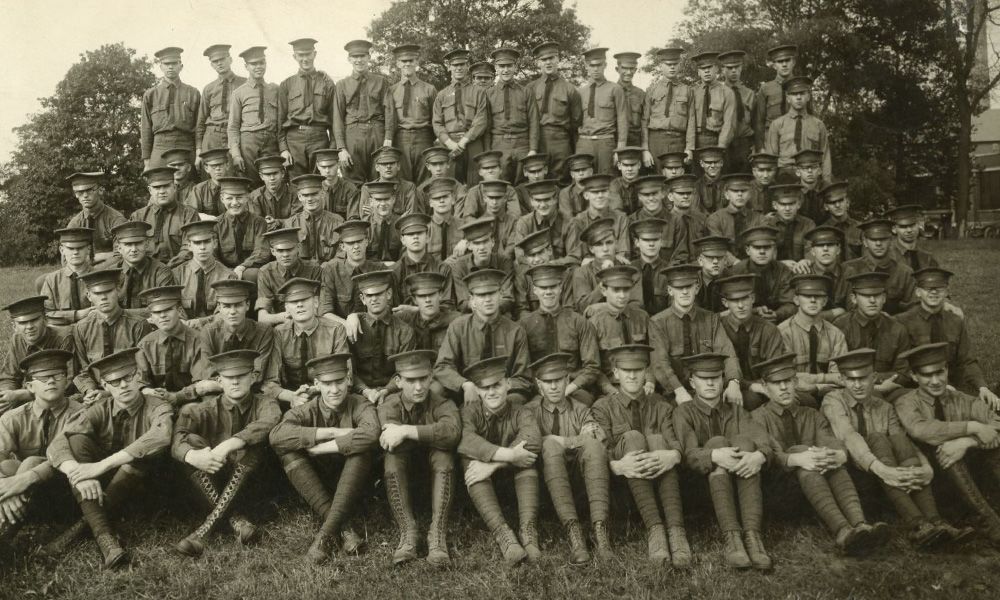
The Institute’s association with helping train America’s military began in 1918 when the War Department’s Committee on Education and Special Training asked Rose Poly officials to provide special intensive auto mechanics training to detachments of Army soldiers from Indiana, Kentucky, Ohio, and Michigan preparing for World War I battle. Rose Poly graduates also did their part to help America and its allies win the war. Records reveal that 245 of the college’s 850 alumni had entered military service. After the training exercises were completed, the faculty decided to continue regular military training on campus and the college applied to participate in the Reserve Officer Training Corps (ROTC) program.
Rose Almost Became an
All-Women’s College
When contemplating starting a college in Terre Haute, Chauncey Rose seriously contemplated building and founding a college for the education of young women. Reports in Blackford Condit’s “History of Terre Haute” stated “[Rose] gave the matter much thought as to its internal workings; also as to the plans and specifications of the buildings. He went so far as to make ample provisions for the same, in his will. But afterwards, he changed his mind, as every thinking man has a right to do, and instead, substituted for it, the Rose Polytechnic Institute, a school of technology for young men.”
Quite a Deal for Vigo
County Students
At the time of Rose Poly’s opening, certified Vigo County high school graduates could attend the college free, if they met stringent admission requirements. The tuition charge for all other students was $75 per year. All students, including those from Vigo County, also had to pay an annual $25 technology fee. All charges were due the first day of each school year.
WHAT'S IN A NAME
You may be familiar with the institution and buildings bearing their names, but do you really know who these influential people were
in Rose-Hulman history?
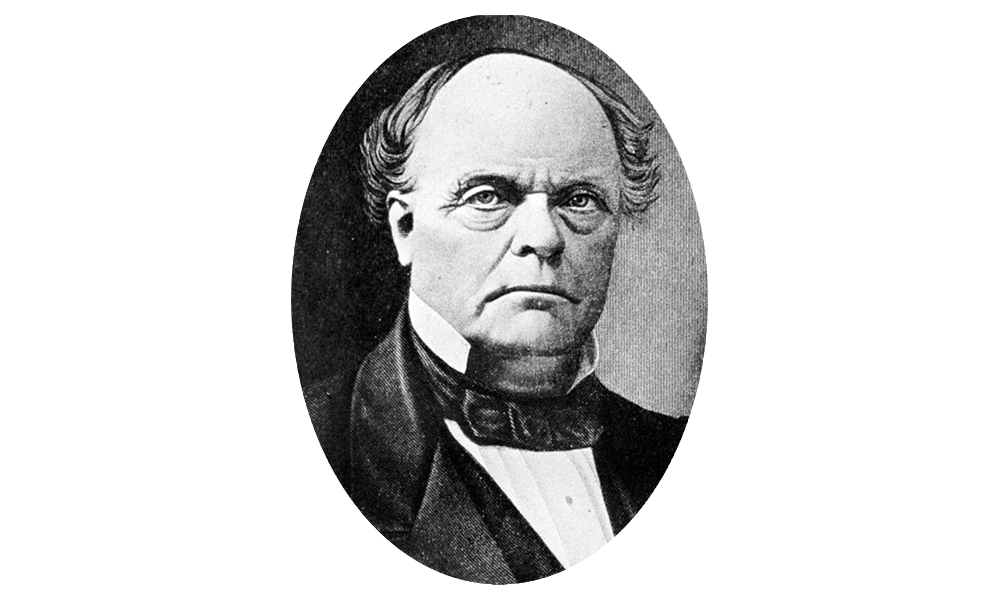
Chauncey Rose
Chauncey Rose moved to the Wabash Valley at 23 years old in search of making his fortune in the West. Profits from operating a mill, distillery, general store, and hotel helped establish his wealth, but it was his association with the railroad industry that brought him the most personal satisfaction and prominence within the community. He and his business associates had difficulty in finding men with technical training to work in the railroad industry and help with its growth throughout the region. Rose decided there should be opportunities for young men, especially from Terre Haute, to study engineering. So, he became a pioneer in engineering education and business. He died in 1877, six years before Rose Poly would have its first classes.
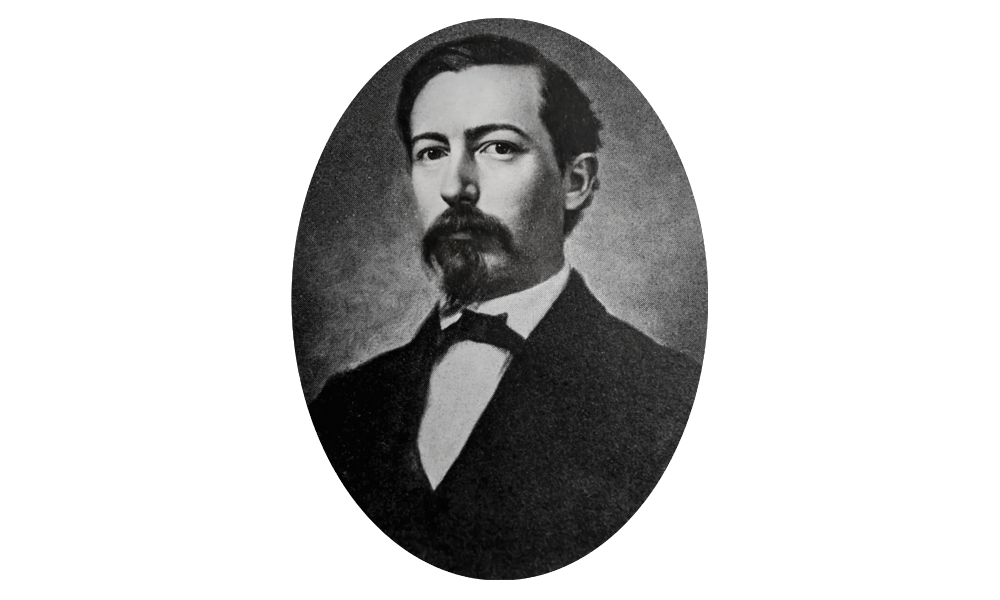
Demas Deming
A president of Terre Haute’s First National Bank, Demas Deming was one of original nine members of Rose Polytechnic Institute’s governing Board of Managers (now known as Board of Trustees) and a trusted friend of Chauncey Rose. The institute reaped benefits from the sale of Deming family property to establish a park for the city. Proceeds established plans to build the college’s first residence hall, later named Deming Hall (opened in 1926).

Carl Leo Mees, PhD
A caring teacher and distinguished scholar, Carl Leo Mees, PhD, served two different periods as acting president before being appointed president on a full-time basis in September 1895. He successfully navigated Rose Poly through several financial hardships. The Rose Technic described Mees: “His influence over the students was truly remarkable. He knew boys and he had a rare faculty of bringing out the best that was in them.” He led Ohio State University’s Department of Physical Science before coming to Terre Haute.
SESQUICENTENNIAL CELEBRATION WILL COVER THE NATION
Alumni from throughout the country will be able to join in the Sesquicentennial Celebration by participating in a kickoff event, Happy Hours, a close-out event, and other events in between that are being organized by the Office of Alumni Relations. Sesquicentennial Happy Hours are currently being planned in the following cities:
Atlanta
Austin, Texas
Naperville, Illinois
Chicago
Cincinnati
Dallas
Denver
Detroit
Houston
Indianapolis
Louisville
Los Angeles
Minneapolis/St. Paul
Philadelphia
Phoenix
Salt Lake City
Seattle
St. Louis
Washington, D.C.
Other cities could be added to the list. Alumni interested in hosting a Rose-Hulman 150th Celebration in your city should reach out to alumnirelations@rose-hulman.edu.
A special sesquicentennial event is being planned during the 2024 Homecoming Weekend along with a Virtual Toast event, featuring small alumni groups online toasting the 150th anniversary. An alumni trip to Scotland also is being planned August 3-12. Look for more details to be coming soon.
Alumni also can make contributions to Rose-Hulman’s Annual Fund during Rose Giving Day on March 14, 2024.
Sesquicentennial Celebration events can be found here
HISTORICAL TIMELINE
1874-1924
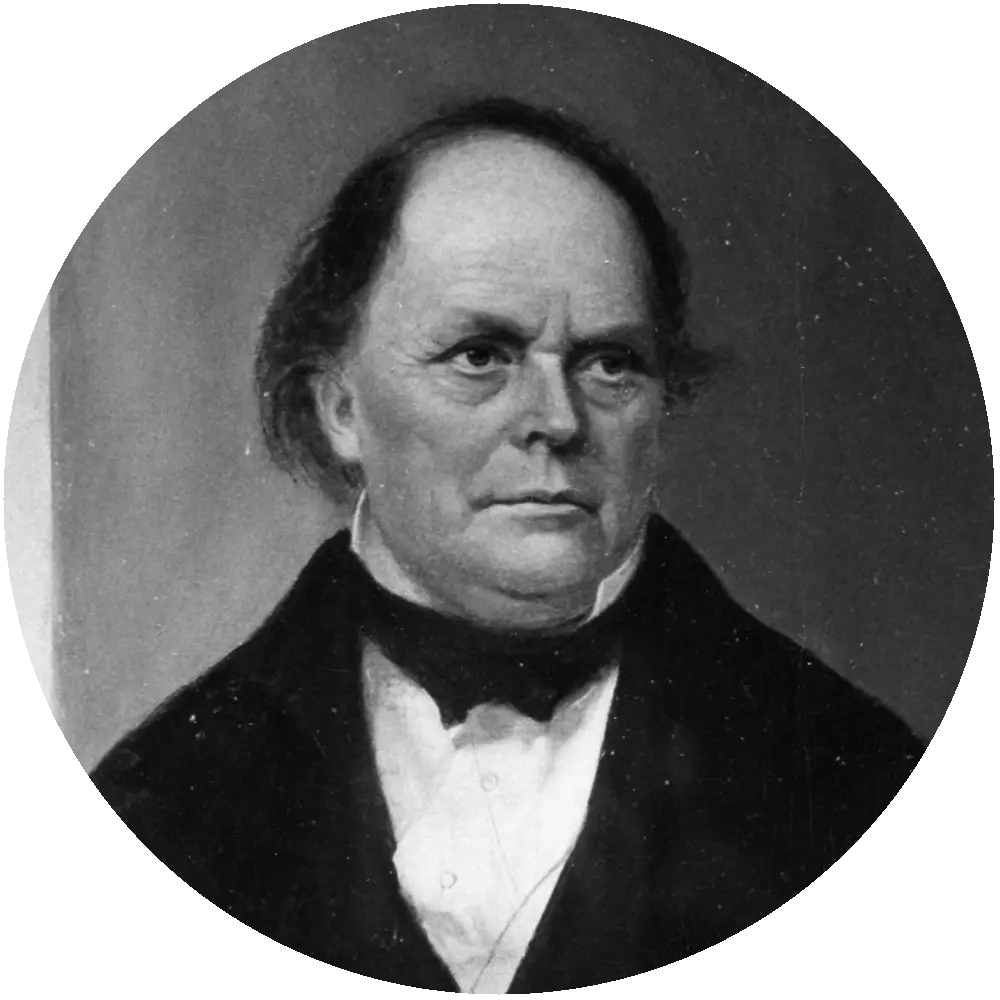
SEPTEMBER 10, 1874
Chauncey Rose and nine of his friends established the Terre Haute School of Industrial Science “for the intellectual and practical education of young men.”
OCTOBER 10, 1874
A nine-member governing Board of Managers was formed with Chauncey Rose being named its first board president; Soon thereafter Rose made his first donation, deeding 10 acres of land at the corner of 13th and Locust streets in Terre Haute, and later gave an $86,000 gift in Evansville, Terre Haute and Chicago Railroad Company bonds to help fund the college’s formation.
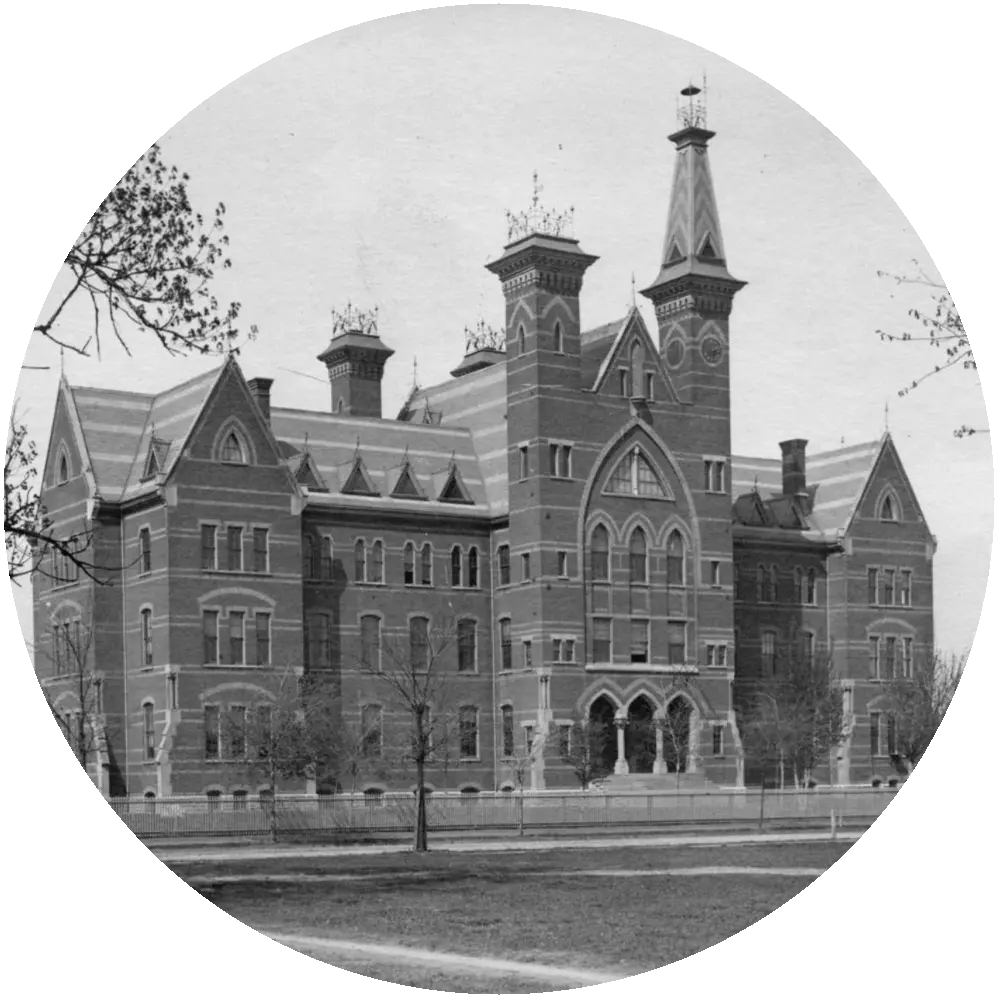
MAY 8, 1875
A contract was awarded to construct the school’s academic building, a four-floor structure with 46 rooms, costing $81,000; a heating system was added in 1876; a machine shop was constructed on the grounds in 1877.
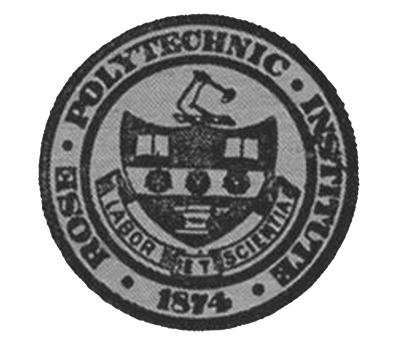
SEPTEMBER 11, 1875
The cornerstone of the academic building was laid, and the school’s name was changed to Rose Polytechnic Institute.
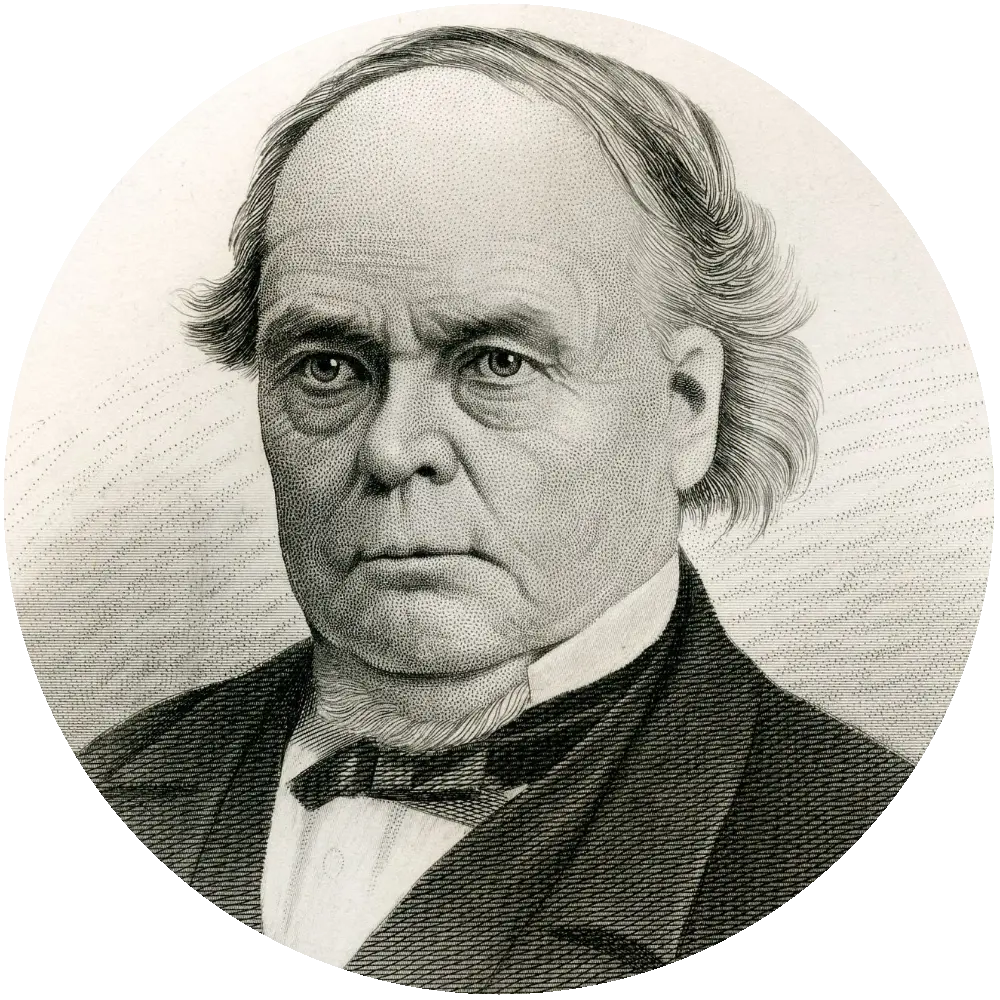
AUGUST 13, 1877
Chauncey Rose died in Terre Haute at age 88; his will provided for a bequest of more than $100,000, bringing value of his total donations to more than $500,000.
AUGUST, 1882
The first invitations for admission were circulated to find prospective students; candidates had to be at least 16 years old and completed two years of high school; by 1886, three years of high school would be required for attendance.
MARCH 5, 1883
The first faculty meeting was conducted and first entrance exams (covering math, U.S. history, geography, and English) were given the next day to prospective students; plane geometry and advanced algebra were later added to the exam.

MARCH 7, 1883
Charles O. Thompson, PhD, was named the school’s first president, after leading the Worcester Free Institute of Industrial Science (now Worcester Polytechnic Institute). He was given a year to visit and study technological schools throughout Europe.
SEPTEMBER, 1883
Classes began with 16 freshmen, 26 sophomores, and 3 juniors (following Thompson from Worcester); all were mechanical engineering majors.
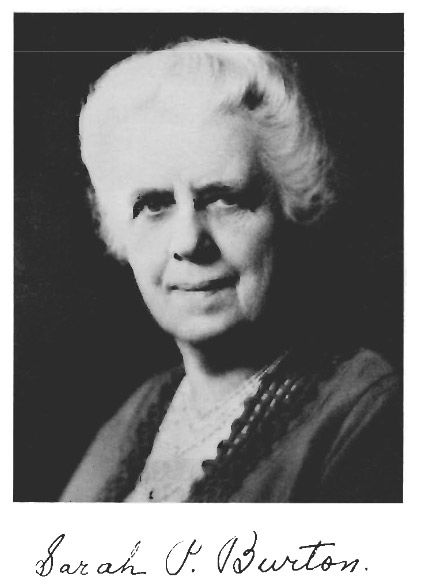
Sarah P. Burton was the first Registrar and registered the first class of students.
Sarah P. Burton was the first Registrar and registered the first class of students.
JUNE 25, 1885
Three graduates earned the college’s first diplomas; the Commencement also served as a memorial service for President Thompson, who had died on March 17, 1885, from a sudden illness.
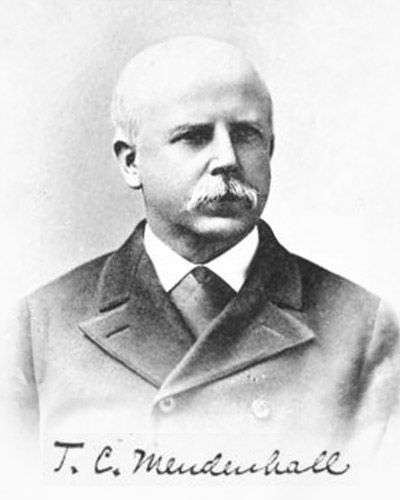
OCTOBER, 1886
Thomas C. Mendenhall, PhD, became president after a distinguished career as a physics professor at Ohio State University.
JUNE 23, 1887
An Alumni Association was formed to include alumni, the graduating class, and Board of Managers.
FEBRUARY, 1888
The basement of the main campus building became a gymnasium and bathroom for student use; four bath tickets could be purchased for 25 cents.
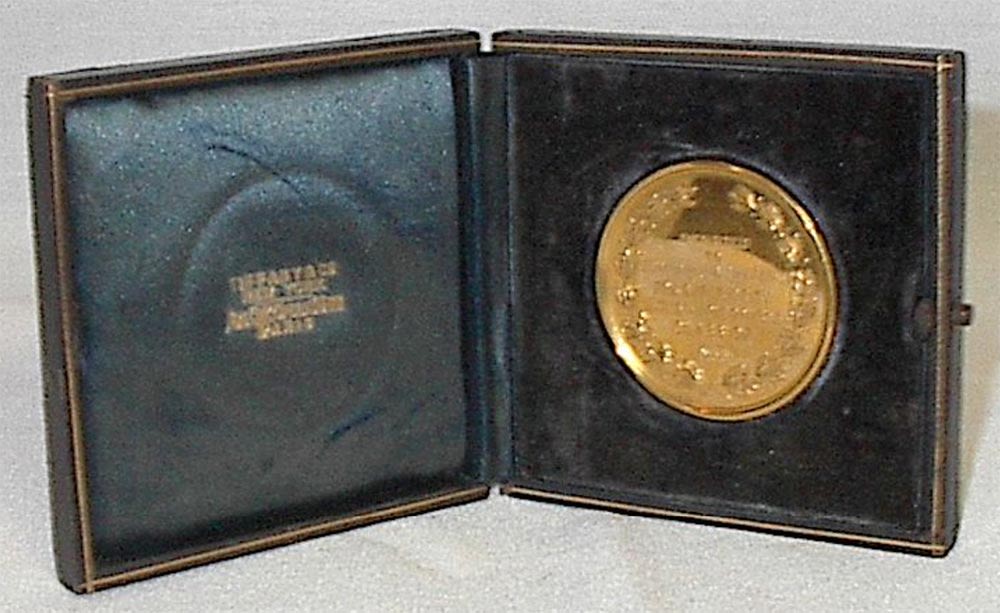
SPRING, 1888
The first gold Heminway Medal was presented at Commencement; Sarah Heminway donated $1,000 to endow the annual award, along with a bronze medal to other top scholars.
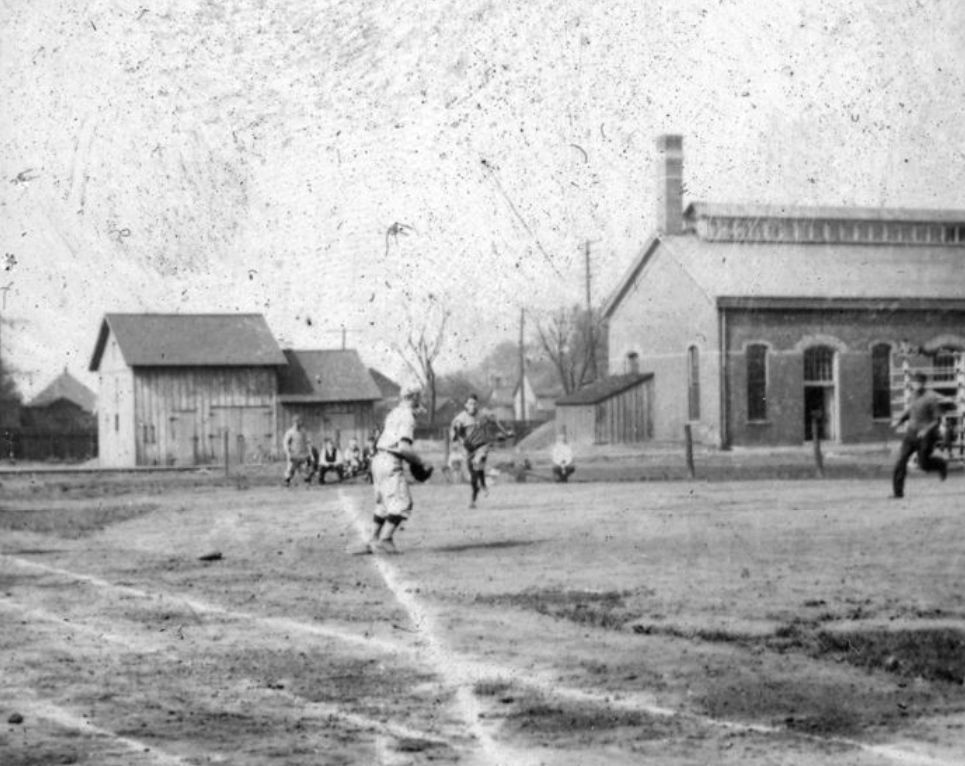
FALL, 1888
The Rose Athletic Association was formulated and athletic teams began; the next spring, a series of baseball games were arranged with students from nearby DePauw University.
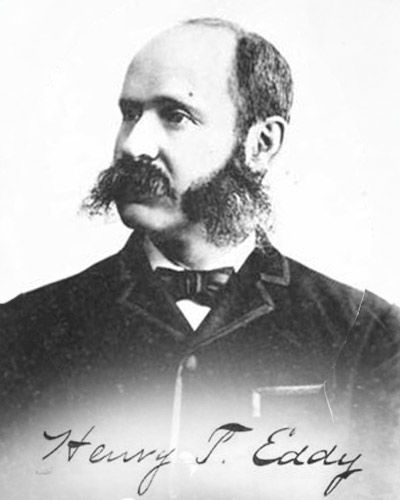
JANUARY, 1890
Henry T. Eddy, PhD, became president after Mendenhall resigned to become superintendent of the U.S. Coast and Geodetic Survey and later president of Worcester Polytechnic Institute (continuing a relationship between the two colleges).
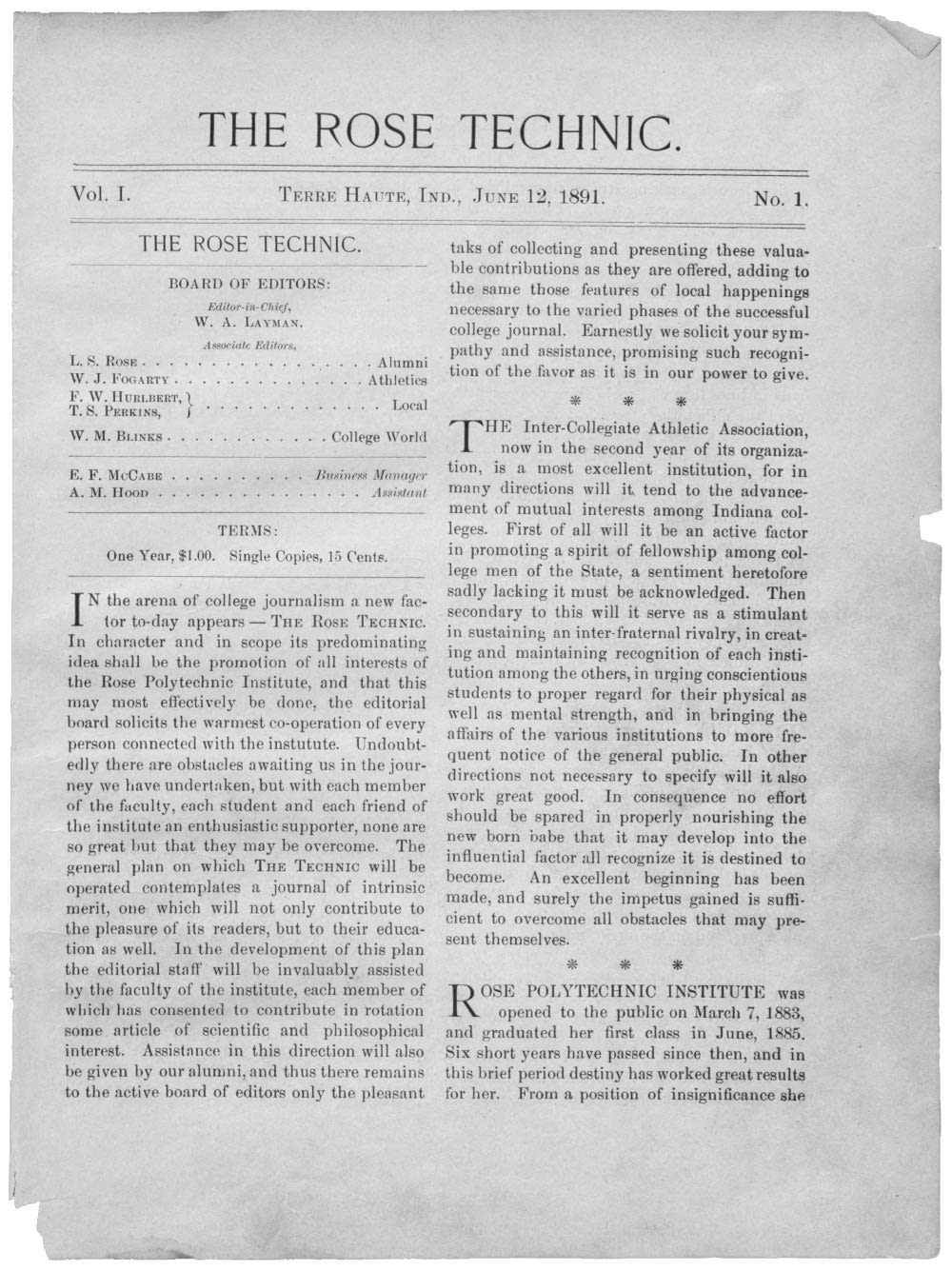
JUNE 12, 1891
The first issue of the Rose Technic student-produced magazine was published, followed by monthly editions that highlighted school activities and the school’s advantages.
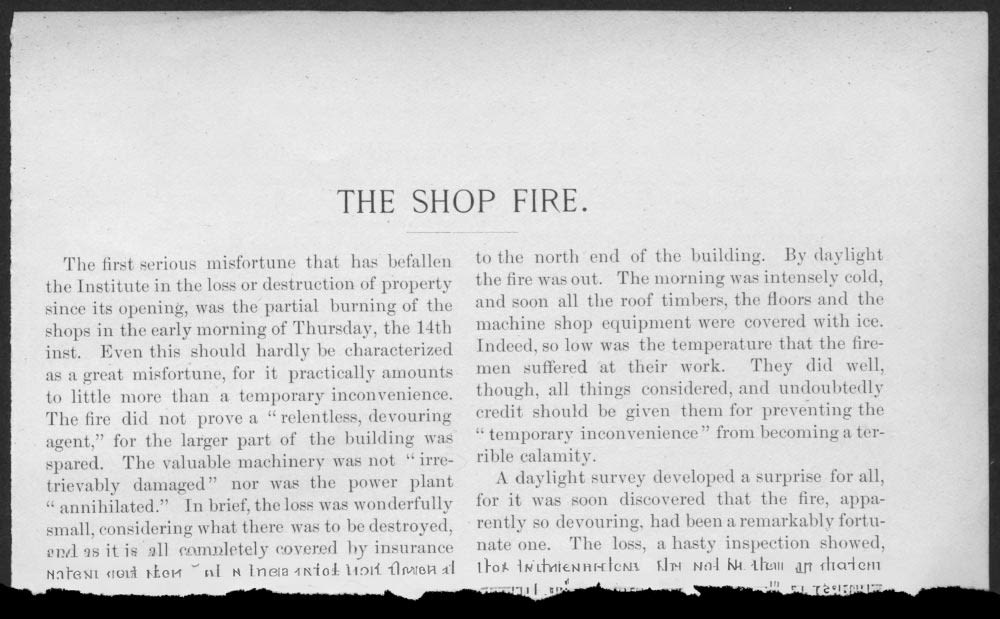
JANUARY 14, 1892
A fire damaged a portion of the second floor and north end of the machine shop building, requiring $5,430 in repairs; the electrical department suffered the greatest loss and inconvenience.
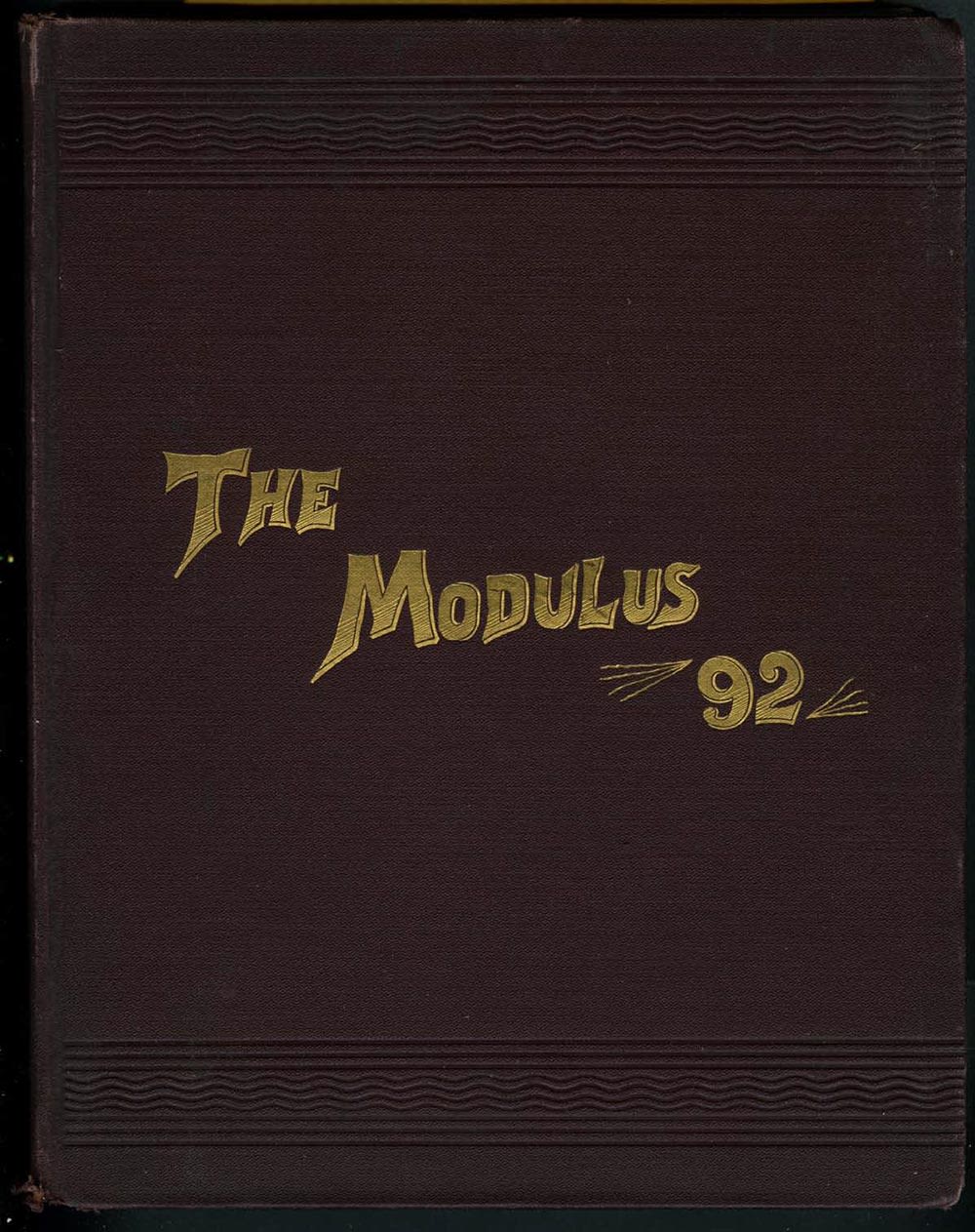
SPRING, 1892
The college’s first master’s degree was awarded to Toro Tsuji, a native of Tokyo; The first issue of the Modulus school yearbook was published.

FALL, 1892
Several students proposed erecting a gymnasium on campus, paid for through student funds; the building was completed in 1897.
OCTOBER 1, 1892
The first varsity football game was played, a 12-0 loss to Wabash College.
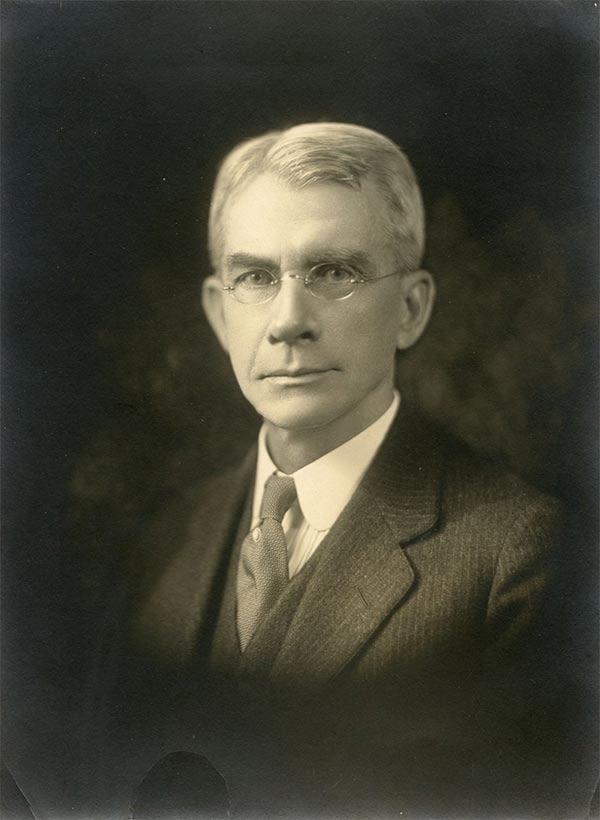
FEBRUARY 15, 1895
Carl Leo Mees, PhD, began a 24-year presidential tenure (until 1919), after twice serving in interim roles; he presided over an era when the college started adding
Rose Tech alumni clubs throughout the country.
SPRING, 1895
The first honorary degree was conferred upon former president Thomas Mendenhall.
DECEMBER 19, 1897
The second varsity basketball game brought a 38-11 victory against Indiana State Normal School.
WINTER, 1899
A Student Council was founded, composed of class presidents and the leading officer of each recognized student organization to consider issues related to the school’s welfare.
SPRING, 1908
Rose Polytechnic earned Carnegie Foundation accreditation for being of “College Rank”; Serious discussions began on moving the college to provide space for growth, with new buildings; site possibilities were explored throughout the city.

FALL, 1909
Hezlep (Heze) Clark was hired as the first full-time athletic coach and athletic director.
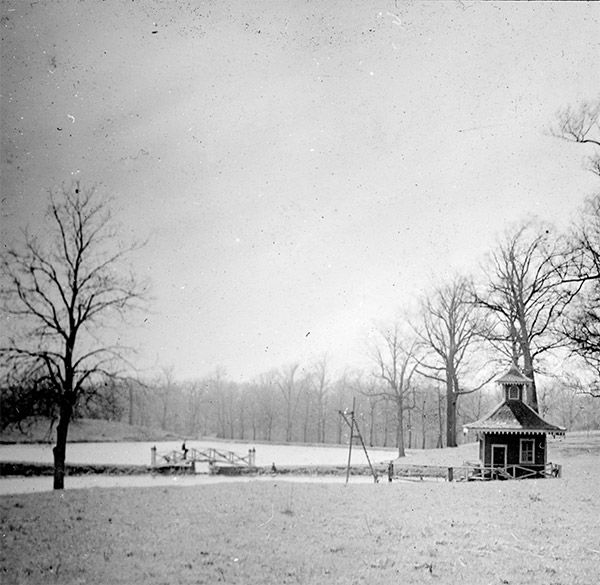
JUNE, 1914
The Board of Managers, faculty, and alumni club representatives visited the Hulman Farm, a 123-acre tract that was five miles east of downtown; three buildings were proposed, costing approximately $250,000; the land was purchased from Herman and Anton Hulman Sr.
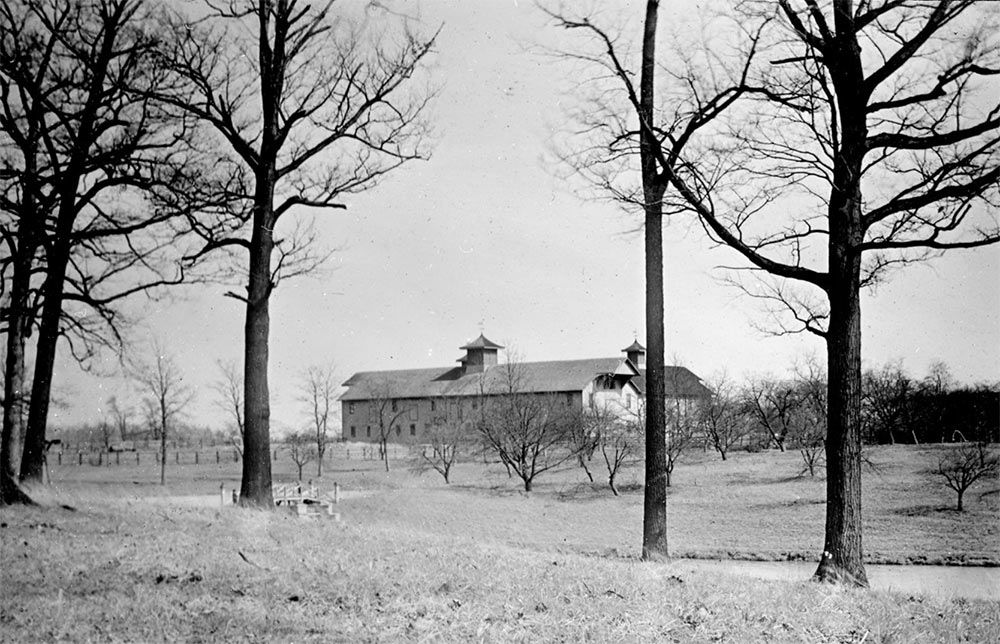
FALL, 1915
The first fundraising campaign commenced with a $500,000 goal to provide the first $300,000 for buildings (to be raised within three years) and $200,000 for an endowment fund (within five years).
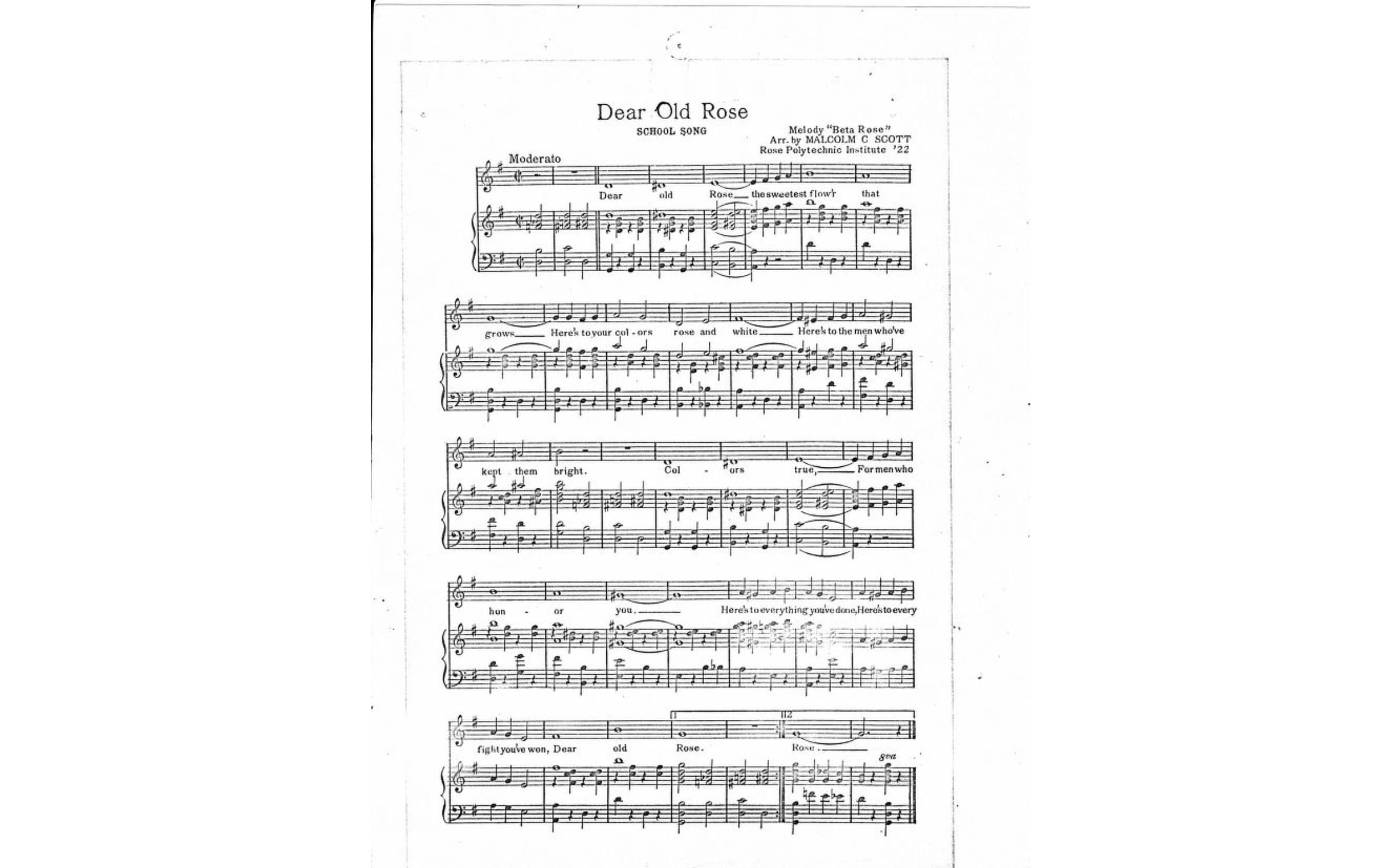
JUNE, 1918
“Dear Old Rose” becomes the official school song, arranged by alumnus Malcolm C. Scott.
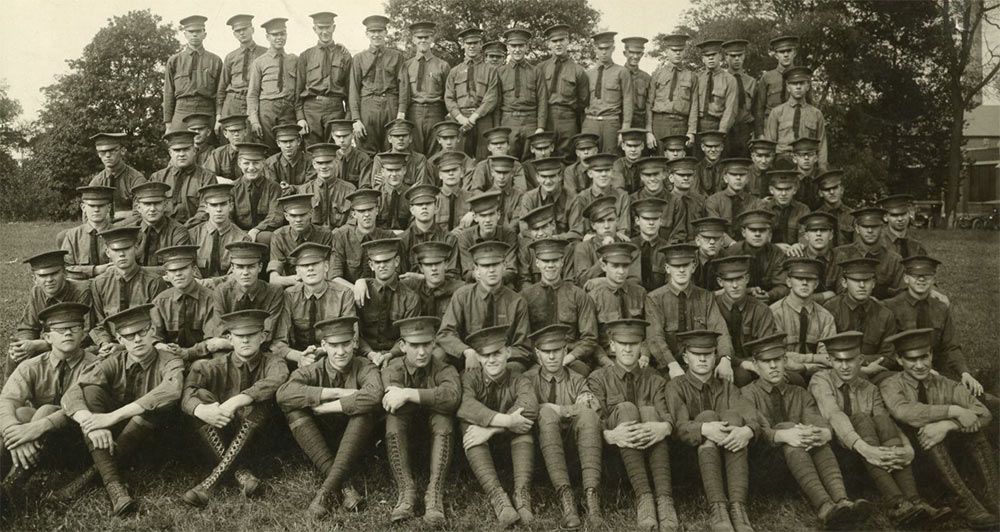
FEBRUARY, 1919
The Army’s Reserved Officer Training Corps was organized with 111 cadets in the first battalion class.
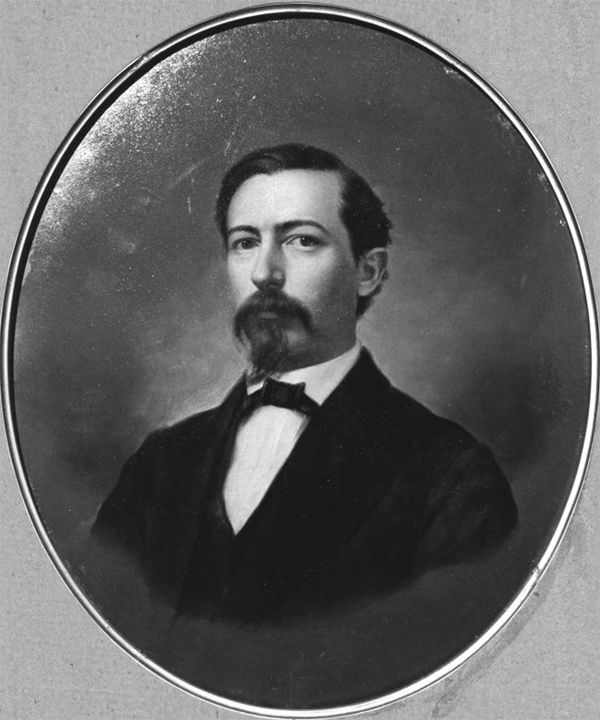
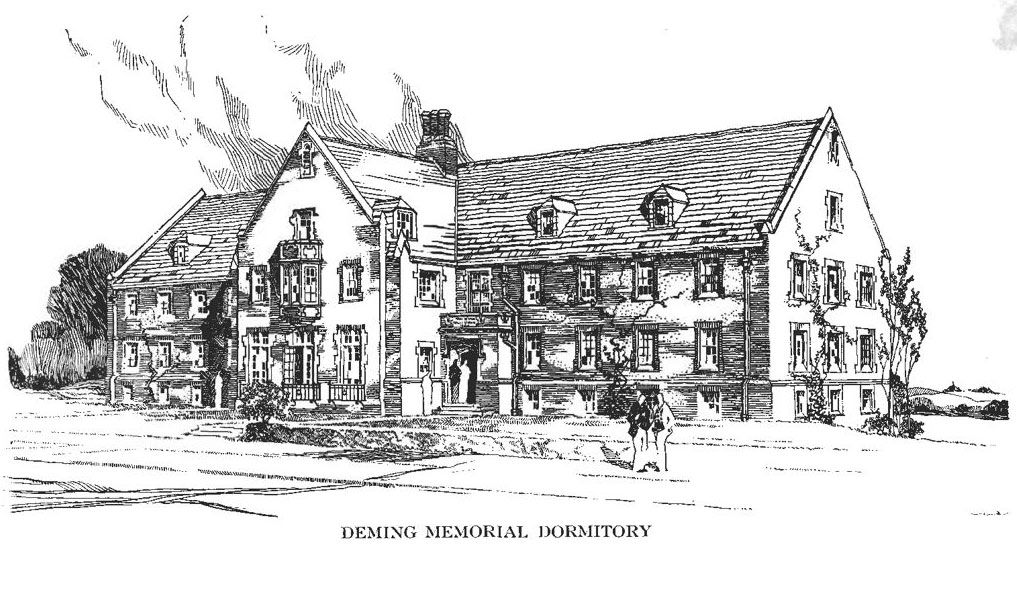
MARCH 1, 1921
A $100,000 gift from Demas Deming was used to plan for the construction of the college’s first residence hall on the new Rose campus; the building was opened in 1926.
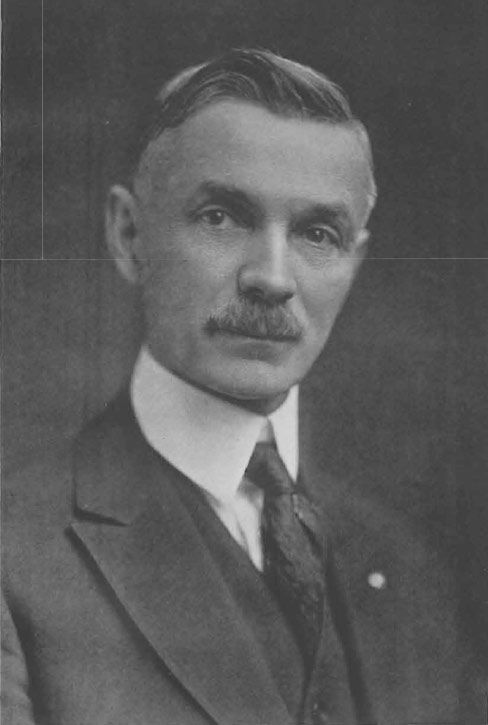
MAY, 1921
Philip B. Woodworth, PhD, is appointed president.
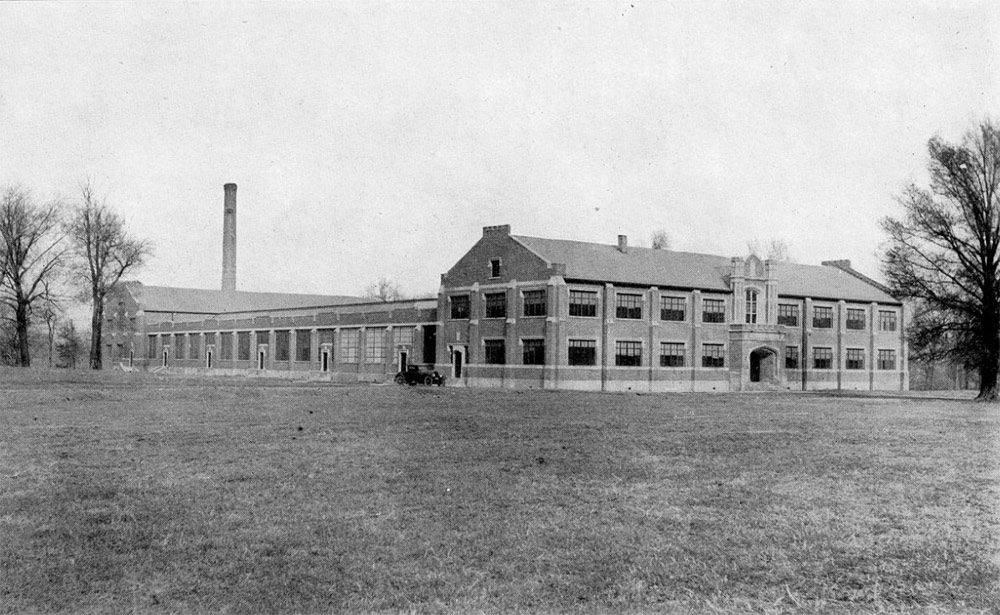
SEPTEMBER 13, 1922
The new campus opens with the laying of the cornerstone for the Main Academic Building.
JANUARY, 1923
All work on the original main building was completed.
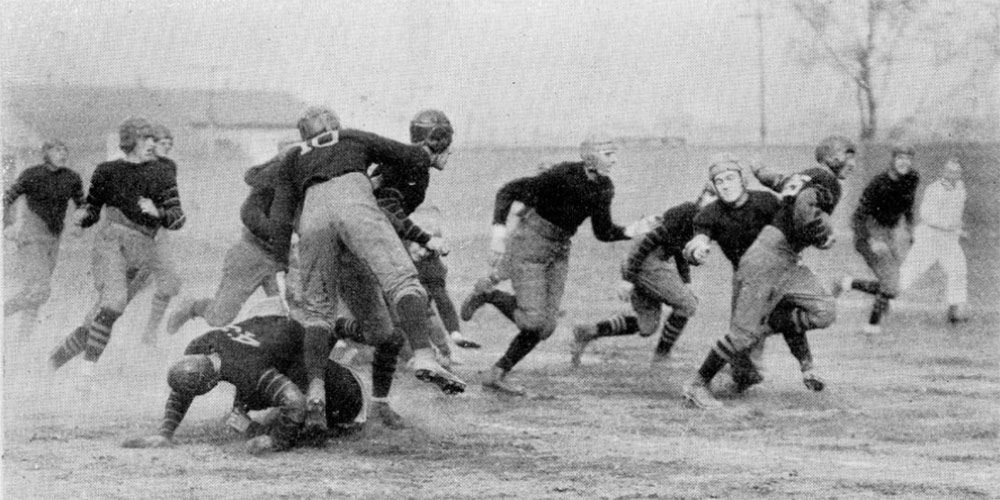
SUMMER, 1923
Athletic Director Heze Clark worked on installing a running track and football field on a field that was across Lost Creek, that meandered through campus; A bridge was built so people could easily access the new athletic facilities; there had previously only been a foot bridge across the creek.
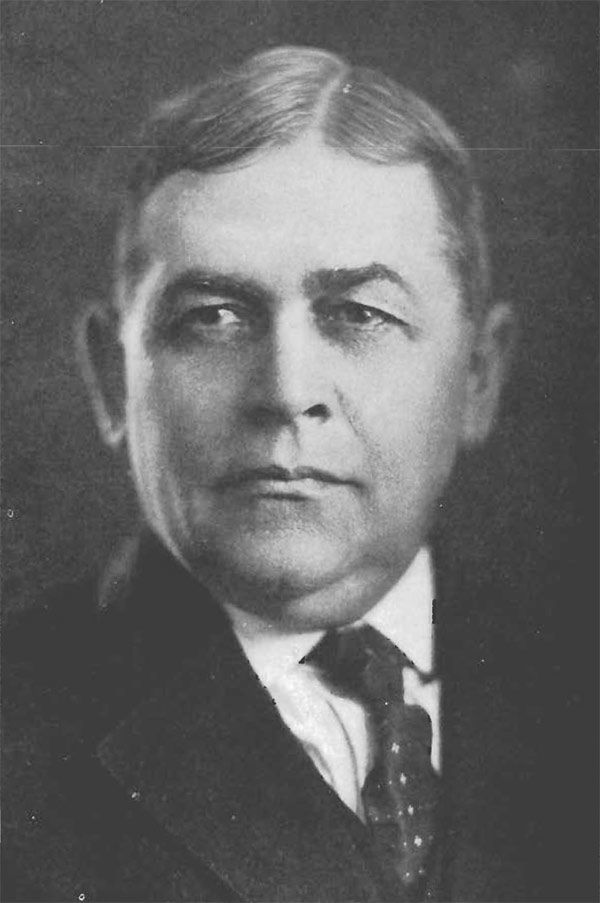
FALL, 1923
Longtime mechanical engineering professor Frank C. Wagner was named president.
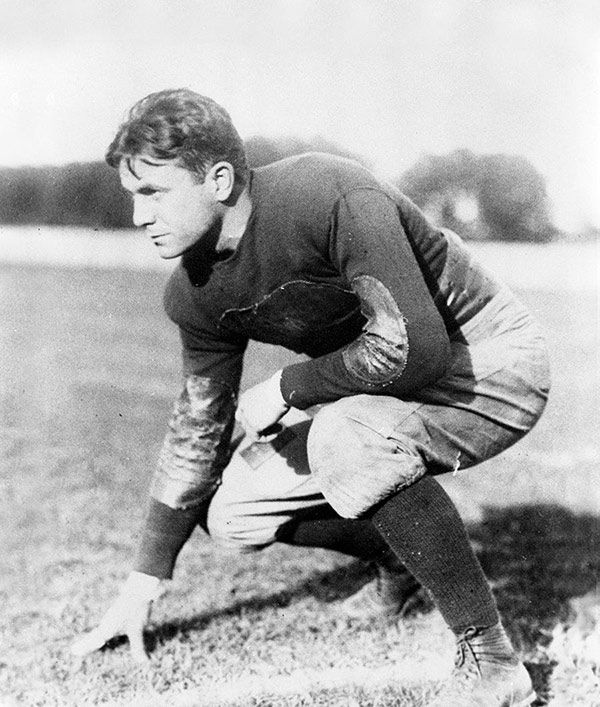
FALL, 1924
Anton (Tony) Hulman Jr. became a coach for the freshman football team after being a standout athlete at Yale University. This started his long and generous contribution to the college.
Homecoming Offers a 'Return to Normal' with record Crowds
Homecoming Continues Building Special Bonds for Alumni & Students
Homecoming didn’t have a particular theme this fall, but if it did, it might have been “A Return to Normal.”
A sense of nostalgia, speckled with traditions, new activities, and lots of good times brought a record number of visitors to campus during the last week of September. The Office of Alumni Relations reported more than 2,050 alumni, faculty, staff, and friends attended events, topping last year’s previous record of 1,910 visitors.
“Homecoming is always a special time on campus, but there was a heightened sense of community spirit among alumni and their families throughout the weekend. You could tell that Rose-Hulman is a place that’s so special to them,” said Vice President for Institutional Advancement Steve Brady. “Current students were making their own memories and other visitors enjoyed everything that Homecoming had to offer this year.”
Homecoming week started with recruiters, many of them alumni, from 267 companies attending the Fall Career Fair. Amended class schedules brought 1,679 students to the Sports and Recreation Center’s fieldhouse seeking full time, internship, and co-op
work opportunities.
Tradition-rich events included students building the Homecoming bonfire—for the 100th year—that was set ablaze following a spectacular drone show; class reunions; a golf outing supporting the Varsity R Club; Founder’s Luncheon; and Golden Rose Reception, when members of the Class of 1973 were recognized as 50-year graduates.
Visitors also enjoyed the opportunity to explore the New Academic Building, Branam and Kremer Innovation Centers, meet professors and staff members during academic department open houses, and a gathering of cybersecurity alumni. New construction is on the horizon with the groundbreaking of a new residence hall for future first-year students.
And the Fightin’ Engineers defeated Anderson University on the gridiron by a 64-3 score.
Check out the highlights below:
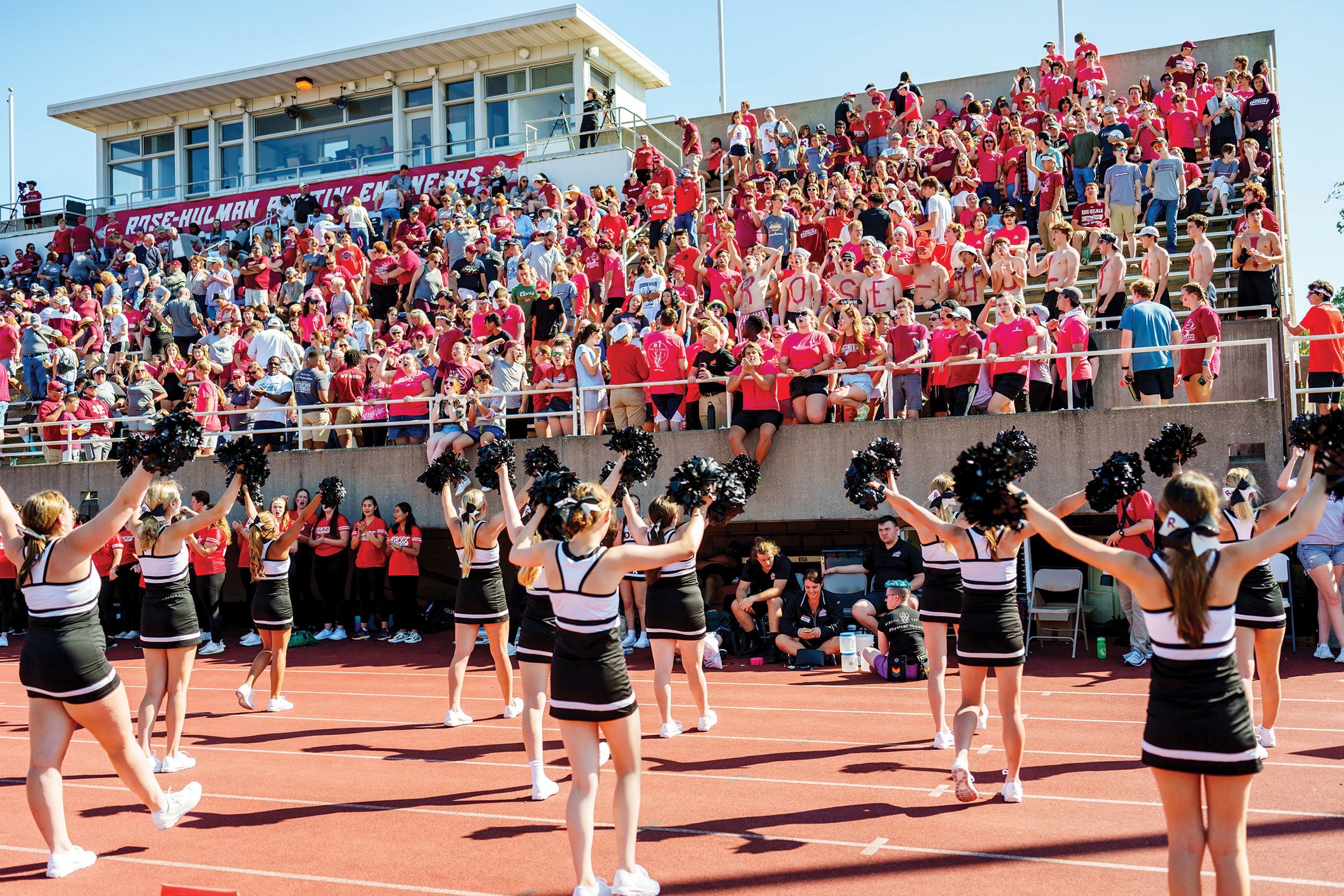

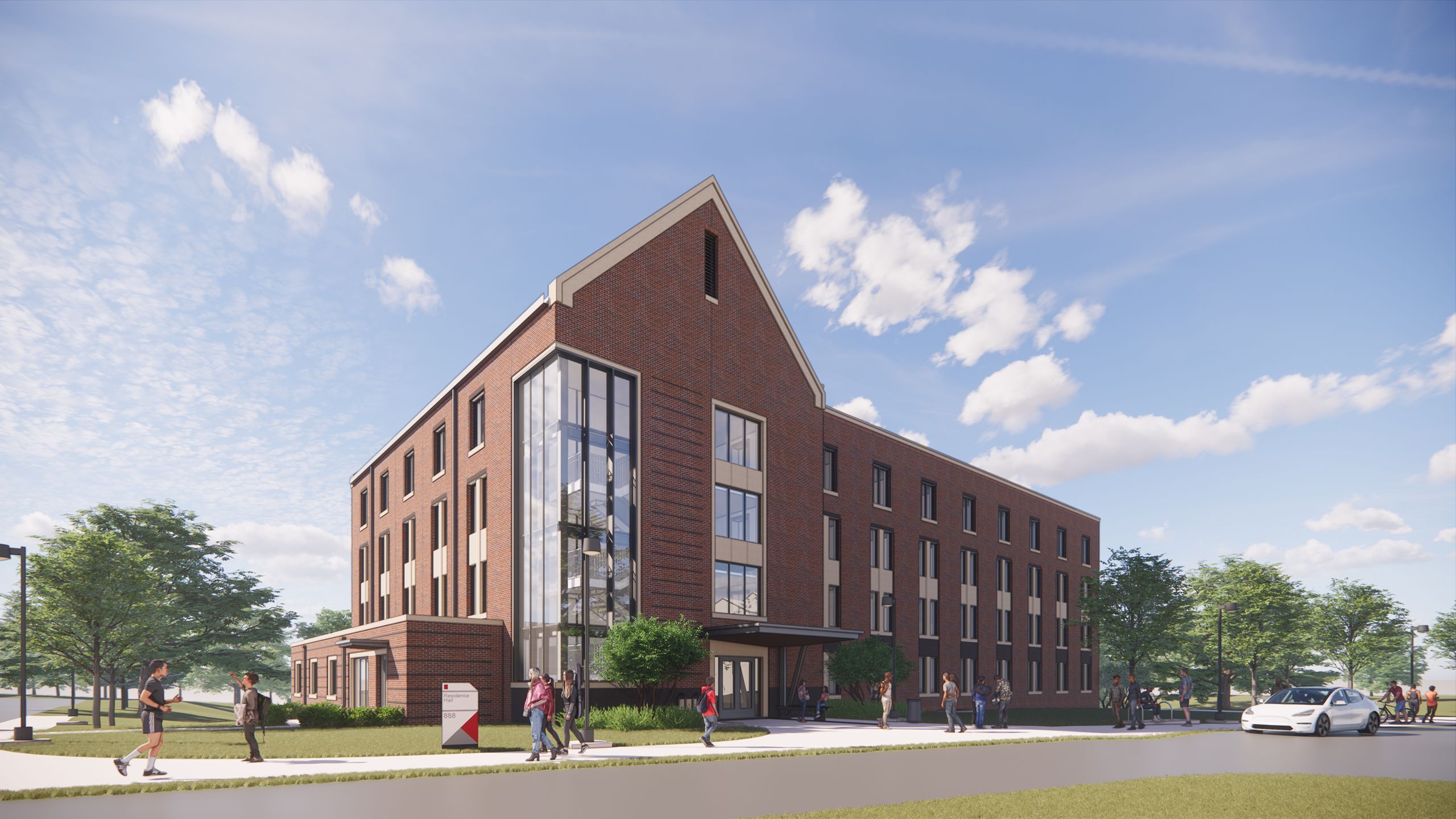
New Residence Hall to Enhance
First-Year Student Experience
$30M Building Will Address Increased Campus Housing Need
The on-campus experience for first-year students is going to be further enhanced through a new residence hall being constructed on campus, with future plans to also upgrade one of the existing student housing facilities. The new building also will address the college’s increased need for campus housing, with enrollment at near-record numbers.
Officials broke ground this fall on the new $30 million, four-floor residence hall that will provide housing for approximately 160 students once it is opened by Fall 2025. It will have student lounges, kitchenettes, and study spaces on each floor. The building will be located southwest of Speed Residence Hall and within proximity to Baur-Sames-Bogart (BSB) and Percopo Halls, which also house first-year students.
The project, being managed by Garmong Construction, will include moving 10,000 cubic yards of soil (for excavation of the building’s basement), use of post-tensioned concrete (containing over eight million pounds of concrete) designed for efficiency, the installation of seven miles of data cabling, and an exterior façade featuring glass and masonry (with more than 80,000 bricks being hand laid).
“This building represents more than just bricks and mortar; it symbolizes growth, progress, and the pursuit of knowledge that have become hallmarks of a Rose-Hulman education,” said President Robert A. Coons. “When I meet alumni and ask about their Rose-Hulman experience they always talk about our rigorous academics, but they will also mention the life-changing experience that they had on campus—an experience that happens in our residence halls.”
He adds, “We have chosen a design for this space with the Rose experience in mind. The number of beds on a floor, the amenities, the sightlines, and walking paths were all intentional to benefit our students and to complement their Rose experience.”
“The freshman experience in our residence halls is unlike anywhere else in the country. That time spent together forges the bonds that make the college experience here so uniquely Rose.”

The four-floor residence hall will have student lounges, kitchenettes, and study spaces on each floor. The building will be located southwest of Speed Hall and within proximity of other first-year halls on campus.

The new residence hall’s opening by Fall 2025 will allow the college to make substantive renovations to Speed Hall as a part of Phase II of this project, during the 2025-26 school year.
Vice President for Student Affairs and Dean of Students Erik Hayes (BSME, 1997/MSME, 2001) pointed out that Rose-Hulman has expanded its residence life services in recent years to meet student needs. Student feedback was an important element in the new building’s planning process, with care to make sure it was close to other first-year residence halls, met accessibility needs, and was designed to encourage student interaction through common spaces and study areas on each floor.
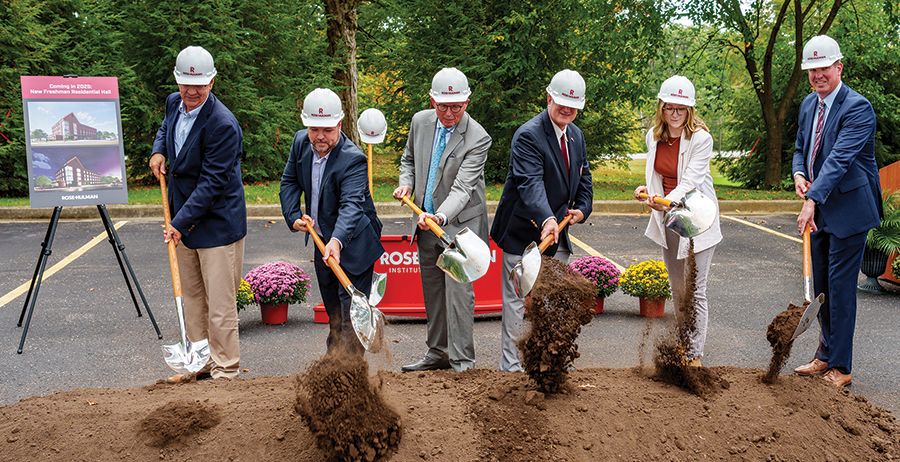
Helping break ground to start construction on the new residence hall this fall were (from left) Terre Haute Mayor Duke Bennett, Vice President for Student Affairs and Dean of Students Erik Hayes (BSME, 1997/MSME, 2001), Rose-Hulman President Robert A. Coons, Board of Trustees Chair Carl Cook (HDENG, 2015), Student Government Association President Courtney Valmore, and Garmong Construction Chief Operating Officer Lance Gassert (CE, 2005).
Helping break ground to start construction on the new residence hall this fall were (from left) Terre Haute Mayor Duke Bennett, Vice President for Student Affairs and Dean of Students Erik Hayes (BSME, 1997/MSME, 2001), Rose-Hulman President Robert A. Coons, Board of Trustees Chair Carl Cook (HDENG, 2015), Student Government Association President Courtney Valmore, and Garmong Construction Chief Operating Officer Lance Gassert (CE, 2005).
“Our campus culture is the heart and soul of Rose-Hulman. It’s what binds us together as a community, and it’s what sets us apart,” Hayes says. “The freshman experience in our residence halls is unlike anywhere else in the country. That time spent together forges the bonds that make the college experience here so uniquely Rose.”
First-year students are required to live on campus, and an increasing number of upper-class students have sought housing in residence halls or on-campus fraternity and sorority housing in recent years.
CAMPUS NEWS
Carl Cook Begins Board of Trustees Chair Term
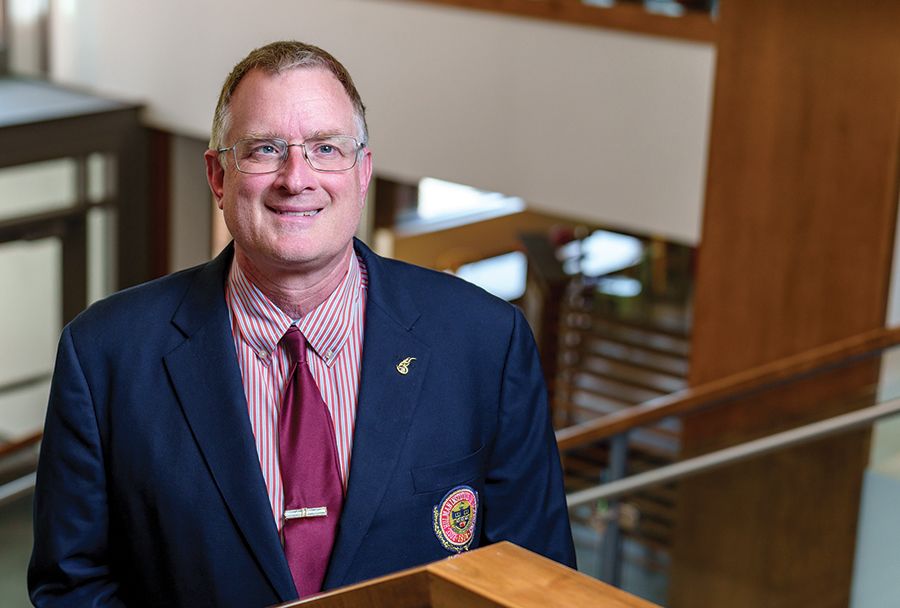
Indiana corporate and community leader Carl Cook (HDENG, 2015) was appointed Chair of Rose-Hulman’s Board of Trustees at the group’s annual meeting this fall, replacing Niles Noblitt (BSBIOE, 1973/HDENG, 1996), who completed his commendable term.
Cook, a trustee since 2009, is chief executive officer of Cook Group Inc., a Bloomington, Indiana-based company recognized worldwide for its development of minimally invasive medical device technology that has improved lives—a mission started by his late father, William Cook.
Cook has been involved in a variety of projects to improve the educational opportunities for Rose-Hulman students, faculty, and staff. Those areas included the establishment of the William Alfred Cook Laboratory for Bioscience Research, a 1,350-square foot facility dedicated on campus in 2012.
Linda White (HDENG, 2023) of Evansville, Indiana, has replaced Cook as the trustees’ Vice Chair. Other officers are Thomas Dinkel (BSME, 1972/HDENG, 2015), Treasurer, and Greg Gibson (BSCE, 1984/HDENG, 2017), Secretary.
Cybersecurity Minor Available
for All Students
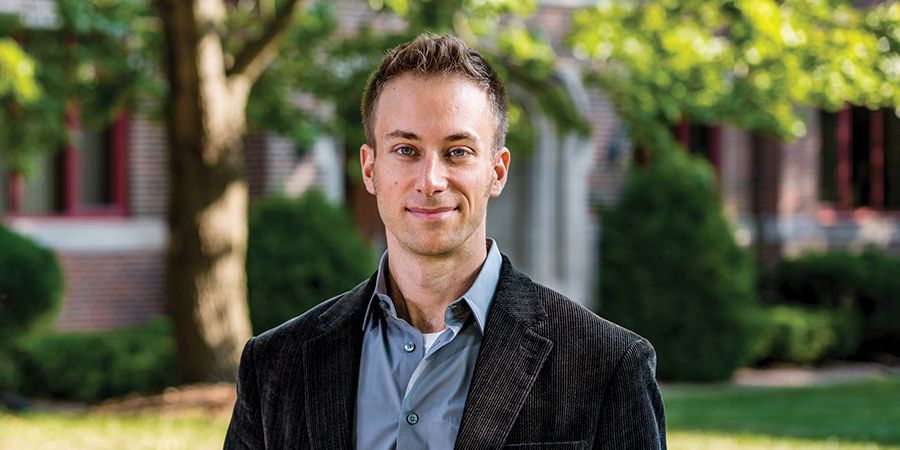
Students of all academic majors now can add a minor in cybersecurity that provides a strong foundation to meet future high-tech challenges and follow a growing number of alumni who are already impacting the cybersecurity industry.
A special emphasis of the new minor course of study is providing cybersecurity skills outside of the normal computer science and software engineering program, whose students already become familiar with some cybersecurity issues through regular coursework.
The program is being led by Sid Stamm (CS, 2003), PhD, associate professor of computer science and software engineering. He has organized a Cybersecurity Seminar Series that has featured several alumni and mentors a Cybersecurity Club that has students participating in hackathon events throughout the Midwest.
Rose-Hulman’s nationally ranked computer science and software engineering major is already designed to give students a solid foundation in computer science, with the ability to customize their coursework to create a cybersecurity emphasis. The department’s collaborative learning culture allows students to tackle challenges in a teamwork environment, which makes them well-suited to hit the ground running in the cybersecurity industry.
Several alumni have put their cybersecurity knowledge to work at well-known companies such as Microsoft, Meta, Google, Airbnb, Groupon, and Salesforce. They also work for government contractors like Northrup Grumman, and government agencies that work directly with the defense industry and companies that provide contracted cybersecurity support. Many of these alumni have gathered for special campus receptions during the past two Homecomings.
STUDENT HONORS
Senior Honored for Innovative Auto Lighting Techniques
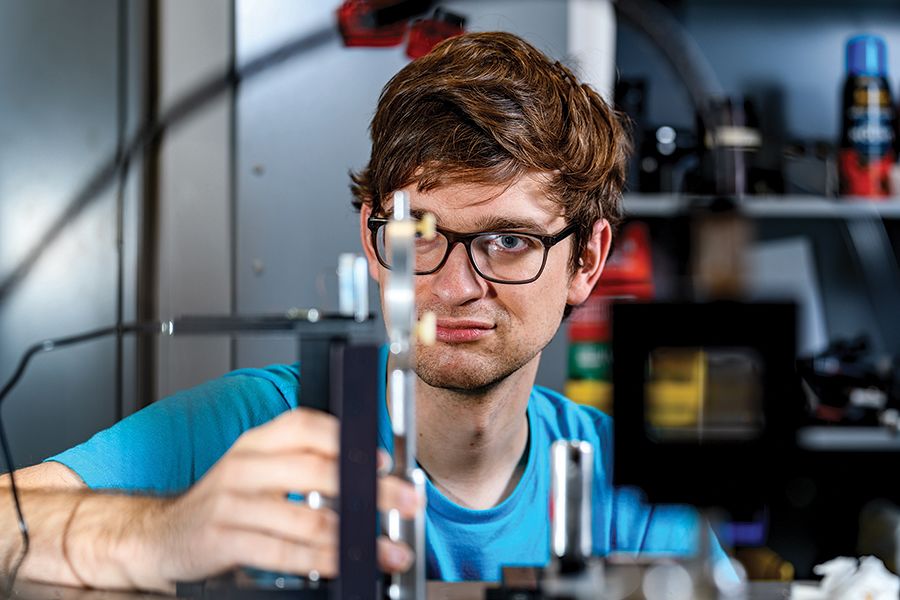
Optical engineering senior Alfred Moore has earned honors in the prestigious 2023 Robert S. Hilbert Memorial Optical Competition, had a publication in an international optics journal, and a possible patent protection filing for developing a bright idea for innovative automotive lighting technology from a classroom project.
Moore designed a low-beam headlamp with a light-emitting diode and fold mirror to create a folded light source that meets performance and automotive industry standards. This technique could allow optical engineers to design more compact and energy-efficient products for automotive headlamps and general lighting applications.
This is the third time that a Rose-Hulman student has been recognized by Synopsys for projects developed in a course taught by Associate Professor of Physics and Optical Engineering Hossein Alisafaee, PhD, that introduces students to automotive lighting technology. Past award winners were alumni Cody Brelage (OE, 2023) and Audrey Brand (OE, 2020).
OTHER NATIONAL STUDENT HONORS INCLUDE:
A research team made up of Emily Bartling (ME, 2023), Ruth Hammond (ME, 2023), Deven Cobb (BE, 2023), and Jerritt Gutierrez (ME, 2023) earned second-place honors in the National Science Foundation’s Undergraduate Design Project Competition for their design of an affordable and wearable haptic emergency alert system for the auditorily impaired. This is the second straight year that a Rose-Hulman team has earned honors in this competition.
Students Begin DOE/Stellantis’ Battery Design Challenge
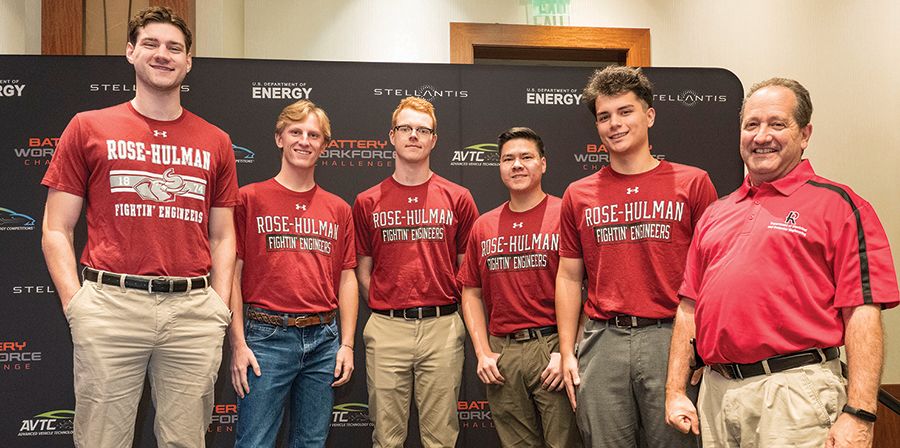
The future is now for students and faculty on campus developing innovative battery technology for the electric vehicle industry through the Battery Workforce Challenge, a competition sponsored by the U.S. Department of Energy (DOE), Stellantis, and other government and industry partners. Rose-Hulman is one of 12 select North American colleges and universities to work the next three years with vocational training programs and youth STEM education initiatives.
“This Challenge provides an opportunity for our students to explore and create new advances in technology that could drive the future of the automotive industry,” says Provost and Vice President for Academic Affairs Rick Stamper (ME, 1985), PhD.
Enhancing the team’s efforts will be a partnership with Ivy Tech Community College in Terre Haute, encouraged by its Dean of Advanced Manufacturing, Engineering & Applied Sciences David Will (ME, 1992).
Rose-Hulman and Ivy Tech students will design, build, test, and integrate an advanced electric vehicle battery pack into a Stellantis vehicle. The first two years of the competition will involve development of a functioning battery pack after following real-world industry milestones focused on battery design, simulation, controls development, testing, and vehicle integration and demonstration. The battery system will then be implemented into the vehicle during the third and final year of the competition, which will conclude with a performance review organized by a panel of industry professionals.
The effort is being led by Marc Herniter, PhD, professor of electrical and computer engineering, and Zac Chambers (ME, 1994), PhD, professor of mechanical engineering, and will involve current and future students from a variety of academic degree areas.
Follow Rose-Hulman’s BWC project at www.rose-hulman.edu/BWC.

Class of 2027 Helps Push Enrollment Growth
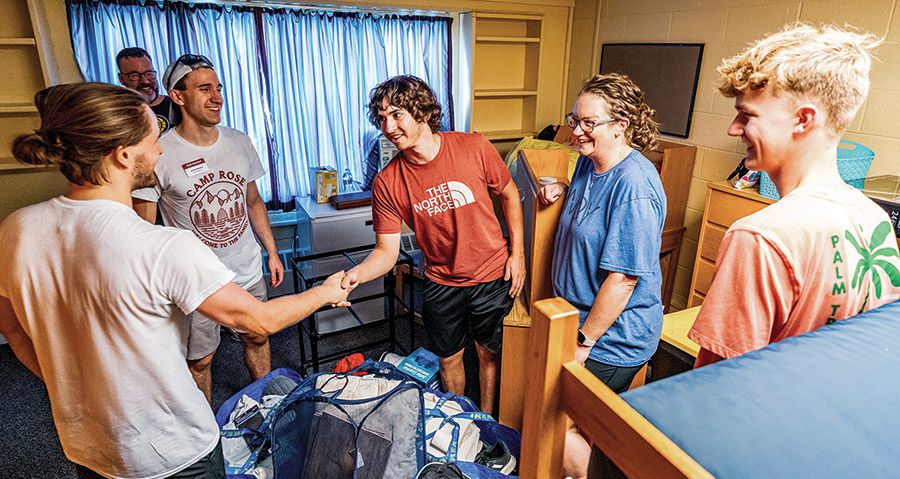
Growing national and international interests, continued focus on student success, and an outstanding incoming Class of 2027 have contributed to enrollment growth for the 2023-24 school year to nearly 2,250 total students—nearly 3 percent higher than Fall 2022. This is a testament to Rose-Hulman’s enduring strength as an institution of academic excellence.
More than 575 first-year and transfer students arrived on campus this fall with a record of academic excellence, with nearly a quarter of students ranking among the top three in their class within schools that recognize rankings. Notably, one in every 14 students holds a perfect Math SAT score, while the median SAT score in Evidence-based Reading and Writing surpasses last year’s record. This class goes beyond academics, encompassing diversity in geography, race, and gender. The key attributes of the class encompass:
• Students hailing from 40 states and 19 countries
• 22% are either first-generation attendees and/or Pell Grant recipients
• 29% are from demographic groups historically underrepresented in the STEM disciplines
A record number of applications were received from prospective students, alongside historic levels of interest in campus visits and summer program participation by high school students.
Coons Joins Alumni in Being Named Among Indiana’s Most Influential Leaders
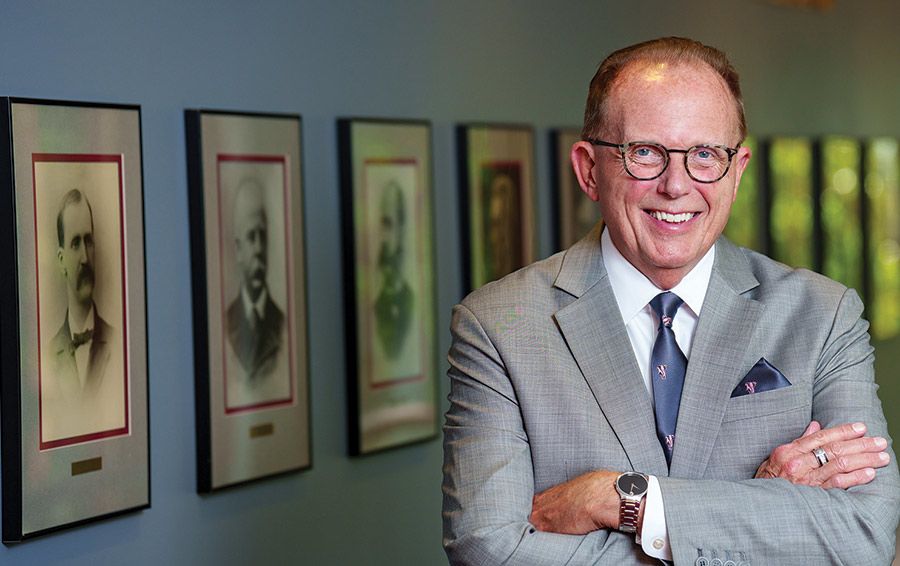
President Robert A. Coons is among 250 of Indiana’s most influential and impactful leaders across business, education, government, philanthropy, the arts, and not-for-profit organizations for making a difference within the state, as selected by Indianapolis Business Journal Media leaders for the 2023 Indiana 250 list.
As the Institute’s 16th President, Coons’ experience and leadership skills have helped guide the college to national prominence. He has played a key role in formulating the goals and objectives of the institute’s past two strategic plans, successful fundraising campaigns, and an enrollment that’s become more diverse and inclusive of top scholars from throughout the country and world. He is helping Rose-Hulman prepare to celebrate its 150th anniversary in 2024.
Coons joins a list of 2023 Indiana 250 honorees with Rose-Hulman ties, including trustees Greg Gibson (BSCE, 1984/HDENG, 2017), president of ReTec Corporation in Terre Haute, and Jeff Harrison (EE, 1989), president and chief executive officer of Citizens Energy Group in Indianapolis. Fred Cartwright (ME, 1980), president and CEO of Conexus Indiana, is also recognized on the distinguished list.
Moench Hall Renovations Complete

What’s old is now new again for historic Moench Hall, which had several elements added during a $25 million renovation project that has helped prepare the Institute to meet current and future student needs. Major aspects of the renovations include: Commons Café, with a new coffee shop, seating areas and a living wall; updated faculty office areas, labs, and classrooms, and several new department office spaces; improved accessibility ramps and a redesigned hallway between Moench Hall and Crapo Hall; additional student study spaces; and improved energy efficiencies with a new top floor skylight, roof replacement, and completely new heating, ventilation, and air conditioning systems.
Trustees Add More Expertise with Carla McFarland, Dan Price
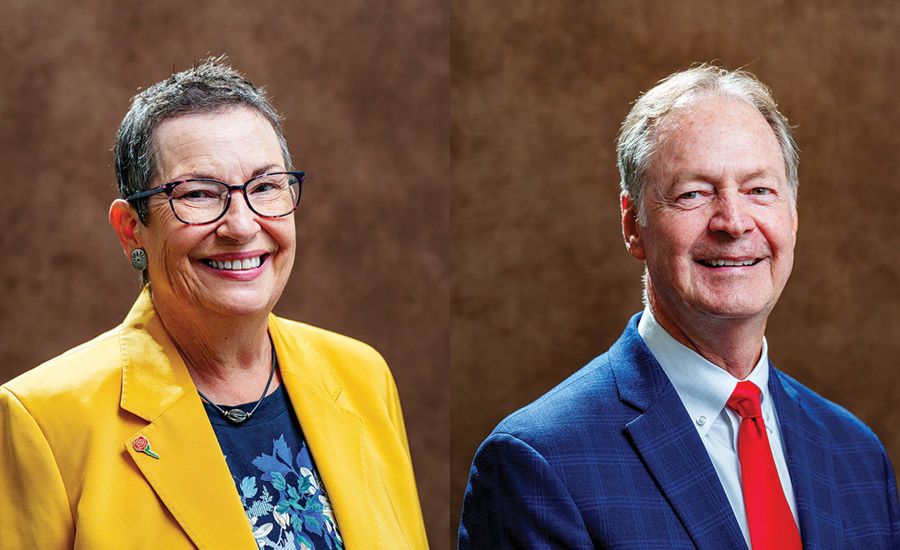
The Board of Trustees added successful serial hospitality entrepreneur Carla McFarland and devoted alumnus Dan Price (CE, 1975), who started a three-year term as an alumni representative trustee.
McFarland, from Alpine, Texas, is a principal consultant with Alrac LLC, an entrepreneurial enterprise established in 2007. She has consulted extensively in the bar, restaurant, and hotel business sector, and established the first AirBnB management company in Texas’ Big Bend Trans-Pecos region. McFarland proudly earned the distinction as a Yellow Rose of Texas, an honorary title conferred by the governor of Texas to women for their exceptional community service and business leadership.
McFarland’s association with Rose-Hulman comes from her membership in the Sawmill Angels, a group of alumni and entrepreneurs that’s supporting alumni-led startups, especially among younger alumni. She also has provided philanthropic support to Rose-Hulman’s diversity efforts, student counseling services operations, and student competition teams.
Price retired after a 33-year career in a variety of leadership roles with Procter & Gamble, including being director of the company’s global quality assurance operations for multiple product lines. His commitment to Rose-Hulman has included service on the Alumni Advisory Board, as president and executive committee member; a Class of 1975 agent and reunion chair; and master of ceremony for the Alumni Awards program. He earned Rose-Hulman’s Career Achievement Award in 1993.
Dan and his wife, Elise, established an endowed scholarship fund to provide financial support for students from Clay, Parke, Vermillion, or Putnam counties to attend Rose-Hulman. He also served on committees helping establish alumni support for Rose-Hulman’s Vision to be the Best and Mission Driven fundraising campaigns.
Engineering Design Program Attains ABET Accreditation
The Engineering Design program has taken a significant step forward in its development by achieving accreditation status for meeting quality standards from ABET’s Engineering Accreditation Commission. Started in 2018, the program’s six different design studios, including third-year professional work experiences, provide students with the skills to understand the depth and breadth of the design process while mastering the technical tools and professional skills to improve the world.
“Engineering Design is a major for today’s global and diverse economy,” states Engineering Design Director Patsy Brackin, PhD. “The program is for creative thinkers who want to get busy learning by doing in a hands-on, immersive educational experience–from a student’s first day on campus.”
Program graduates have gone on to work in industry, start their own entrepreneurial enterprises, and attend graduate schools throughout the country.
Learn more about the program at
www.rose-hulman.edu/engineeringdesign.
NSF Supports Rose’s Role in Leading STEM Academic Change
A $550,000 collaborative research grant awarded from the National Science Foundation is supporting Rose-Hulman’s leadership efforts to develop and provide a changemaker toolkit for higher education educators to initiate, implement and sustain academic change on their campuses.
The effort supports NSF’s Revolutionizing Engineering Departments (RED) initiative. Rose-Hulman was the lead in collaboration with University of Washington’s Center for Evaluation & Research for STEM Equity on the grant, titled, “Academic Change and the RED Community of Practice: Sustaining a Revolution Through Change Leadership and Research.” Rose-Hulman will receive $255,655 over the next three years in an effort being led by Eva Andrijcic, PhD, associate professor of engineering management, and Sriram Mohan, PhD, head and professor of the Department of Computer Science and Software Engineering.
Richard House Becomes Associate Dean; Corey Taylor is HSSA Head
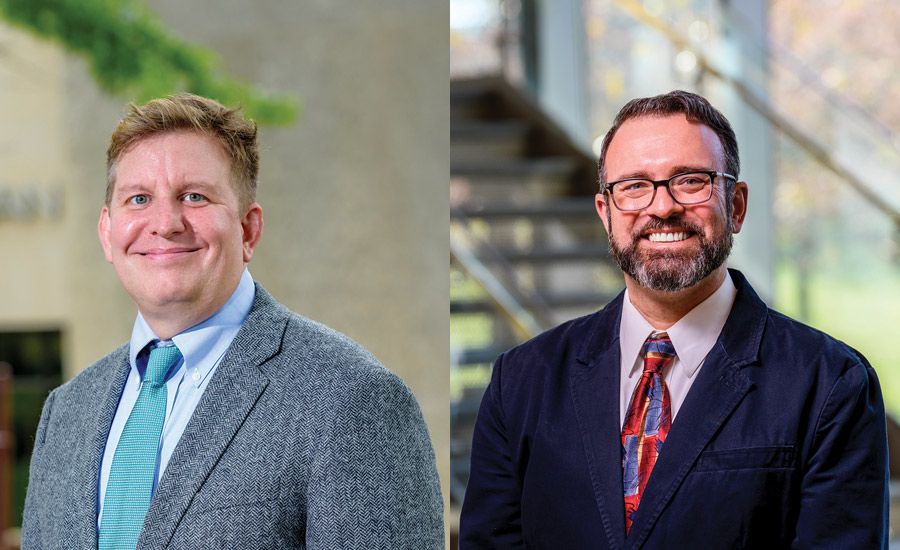
Experienced educator and department head Richard House, PhD, is the new associate dean for professional development, organizing programs supporting fellow faculty members in bringing innovations to their classrooms. He also supervises programs highlighting endowed faculty for their teaching expertise and scholarly research while providing opportunities for professors to work with students on undergraduate research activities in STEM areas.
House, a member of the faculty since 2001, has succeeded Ella Ingram, PhD, who has returned to the biology and biomedical engineering faculty. He served as head of the Department of Humanities, Social Sciences, and the Arts (HSSA) since 2017.
Meanwhile, literary scholar Corey Taylor, PhD, has replaced House as head of HSSA department. He has been a member of the faculty since 2007 and associate department head since 2020, and has taught a variety of English courses, especially in American literature and technical and professional communication. His areas of teaching and research expertise include 20th-century American literature, African American literature, literary adaptations of blues and jazz, and modernism.
FACULTY NEWSMAKERS
Julia Williams Chosen for ASEE Hall of Fame
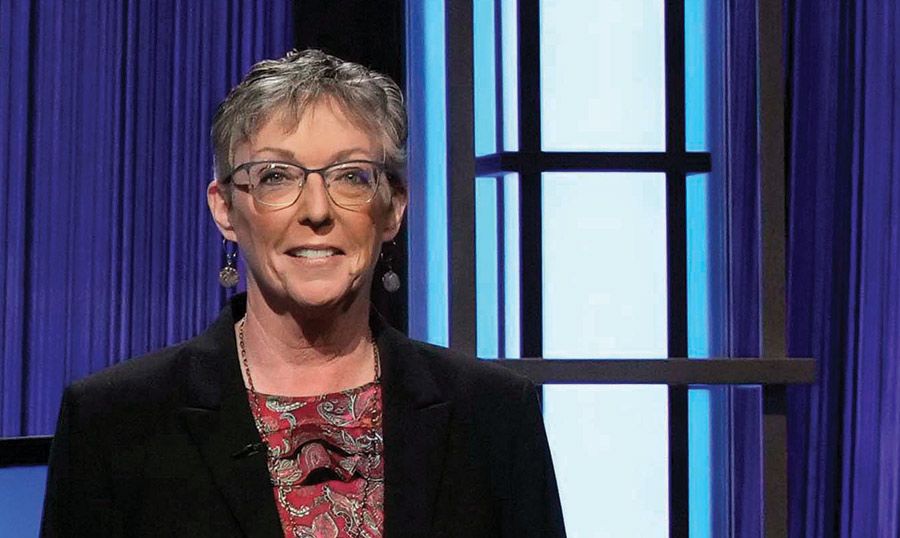
Professor Julia Williams, PhD, has been selected to the American Society of Engineering Education’s Hall of Fame for her contributions to enhance engineering and engineering technology education. She will be recognized as part of the organization’s Annual Conference next June in Portland, Oregon.
Williams is an authority in the field of technical communication and has spent over two decades advancing engineering education through her English teaching, research, and leadership in academic change initiatives.
In June 2023, she published “Making Changes in STEM Education: The Change Maker’s Toolkit” and has spent the past two years building connections between engineering professional societies and the Kern Entrepreneurial Engineering Network (KEEN) to create value for engineers in industry and education.
Carlotta Berry Cited as STEM Educator, Advocate
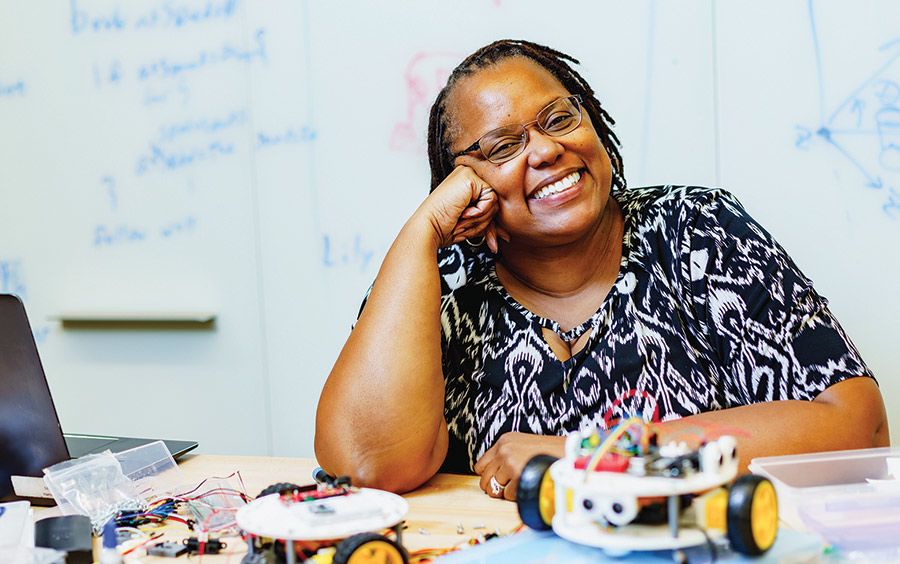
Carlotta Berry, PhD, Lawrence J. Giacoletto endowed chair and professor of electrical and computer engineering, received the Institute of Electrical and Electronic Engineers’ 2023 Undergraduate Teaching Award and AnitaB.org group’s 2023 Educational Innovation Abie Award. These honors recognize educators for developing innovative teaching practices and having a passion for increasing diversity in engineering.
As an Open Source Hardware Association Trailblazer Fellow, Berry has utilized robotics and human-robot interaction research to bring STEM to diverse populations. She has built several organizations that reach out to women and marginalized and minoritized populations and encourage them to pursue STEM degrees.
OTHER ACHIEVEMENTS BY ROSE-HULMAN FACULTY:
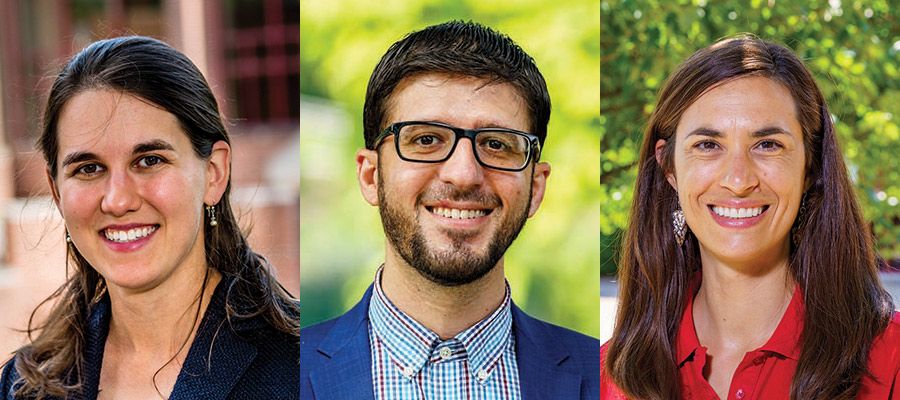
Fifteen first- and second-year students have started exploring their research interests in a variety of engineering, science and mathematics topics as inaugural members of the new Rose Research Fellows program for the 2023-24 academic year, led by Irene Reizman, PhD, the Alfred R. Schmidt Endowed Chair for Excellence in Teaching and associate professor of chemical engineering.
As 2023 Engineering Unleashed Fellows Adel Alhalawani, PhD, and Michelle Marincel Payne, PhD, are creating classroom and laboratory experiences that are instilling today’s engineering students with an entrepreneurial mindset. Alhalawani, assistant professor of biology and biomedical engineering, is piloting a Design Your Rose Life training workshop at Rose-Hulman, while Marincel Payne, associate professor of civil and environmental engineering, will expand upon efforts to use storytelling to promote learning and connection in her classes.
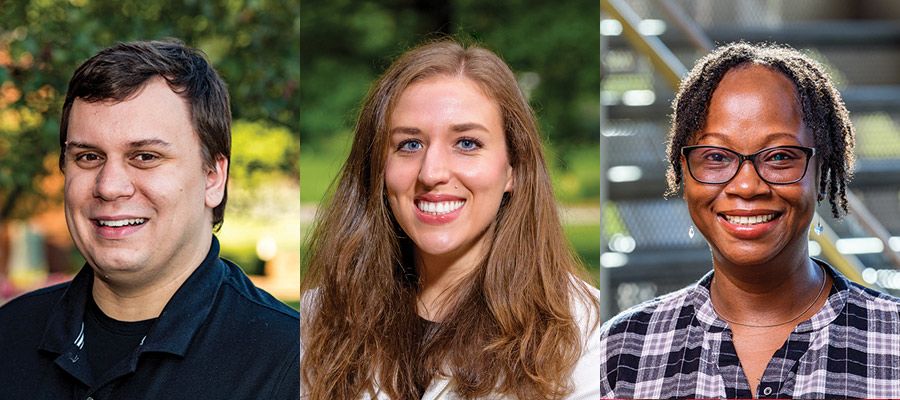
Associate Professor of Chemical Engineering Daniel Anastasio, PhD, has received two national scholastic honors for distinguished contributions to teaching and advances to undergraduate STEM education: the ASEE Chemical Engineering Division’s Raymond W. Fahien Award, for outstanding teaching effectiveness and educational scholarship, and American Institute of Chemical Engineers’ David Himmelblau Award for outstanding innovations in computer-based chemical engineering education.
Emma Dosmar (BE, 2011), associate professor of biomedical engineering, has received a grant supporting her research efforts as part of an educational sabbatical in Germany this academic year. She is a visiting researcher at Eberhard Karls University of Tübingen’s eye clinic, working on a project relating to ocular drug delivery. Follow Dosmar’s international adventures on Instagram at @picksabroad.
Mathematical scholar and senior lecturer Lucy Muthoni, PhD, from Kenya is spending the 2023-24 academic year as the Institute’s Visiting Fulbright Scholar-in-Residence. She will lecture on a variety of mathematical topics and mentor students, especially those interested in entrepreneurship. Her visit is being supervised by Associate Mathematics Professor Wayne Tarrant, PhD.

These are among the campus pole banners.
These are among the campus pole banners.

This 36-foot tall sign greets food court visitors at Indianapolis’ Fashion Mall.
This 36-foot tall sign greets food court visitors at Indianapolis’ Fashion Mall.
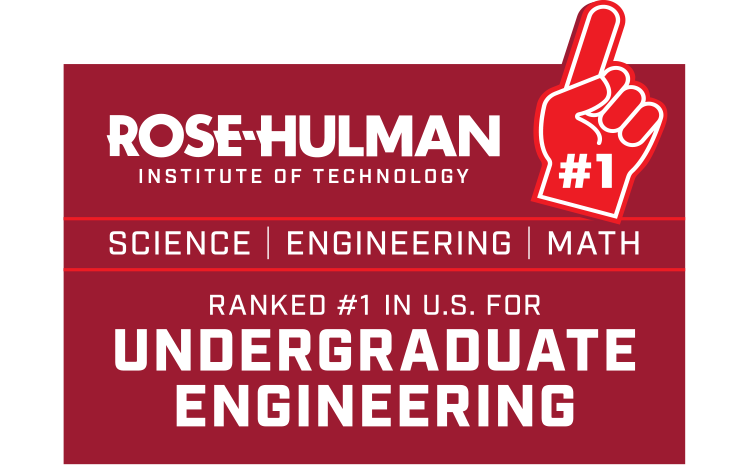
Billboard that can be viewed by travelers along Interstate 70 near Terre Haute.
Billboard that can be viewed by travelers along Interstate 70 near Terre Haute.
SPREADING THE GOOD NEWS
Marketing Campaign Showcases that ’Together, We Are … Rose-Hulman’
Alumni shouldn’t be surprised whenever digital advertisements for Rose-Hulman pop up on their electronic devices. It’s all part of a comprehensive brand awareness initiative that’s increasing the Institute’s name recognition throughout the world.
Started in 2022, the campaign has featured a series of digital ads, billboards and signage, special-interest emails, social media blitzes, videos, and a new podcast (see sidebar on Page 23) that highlight the college’s close-knit campus community, challenging academic rigor, and caring and quality faculty and staff. It also accentuates the strong career placement, quality laboratories and student life facilities, outstanding return on investment, and successful alumni.

These are among the campus pole banners.
“Rose-Hulman has a great story to tell and we’re taking advantage of a cross section of new and traditional marketing concepts to introduce Rose to new audiences, along with re-introducing the college to others who may be familiar with the college, but haven’t heard what’s been happening on campus lately,” says Santhana Naidu, vice president for communications and marketing.
Features of the marketing effort include:
‘Together, We Are ...’ Slogans: Those elements that accentuate the campus community—innovation, creativity, student life, academics, and athletics—have been brought together with the “Together, We Are” tagline on campus signage, billboards, advertisements, and publications. “It captures the sense of community that ‘We’re all in this together,’” Naidu says.
Digital Ads: Special 15- to 30-second video commercials are capturing the interest of prospective students and influencers and on their smart TVs, computers and mobile devices. Some of these ads have also been used to promote the annual Rose Giving Day and Homecoming.
Social Media (@rosehulman): Content and videos about Rose-Hulman are being highlighted frequently on Instagram, LinkedIn, TikTok, Facebook, X/Twitter, and YouTube.
Following ‘Life at Rose’ (@lifeatrose): Students provide interesting behind-the-scenes perspectives on Instagram about their campus activities, study abroad visits, and internship experiences.
Billboards/Commercial Signage: Interstate travelers passing through Indianapolis, Northwest Indiana, and Terre Haute can view large billboards touting Rose-Hulman’s prestigious national college rankings, consistently high job placement rates, and student/faculty/alumni achievements. You also can’t miss the Institute’s large signs at The Fashion Mall in Indianapolis.

This 36-foot tall sign greets food court visitors at Indianapolis’ Fashion Mall.
While most marketing efforts may take nearly five years to begin reaping benefits, Rose-Hulman’s campaign has already helped bring forth record numbers of interest and engagement

Billboard that can be viewed by travelers along Interstate 70 near Terre Haute.
New Podcast Provides Insight into STEM Success
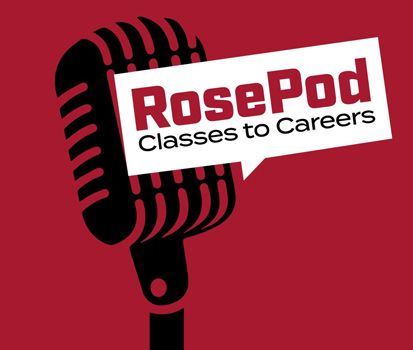
Rose-Hulman’s new RosePod: Classes to Careers podcast is a thought-provoking and inspiring avenue for prospective students that is guiding these future STEM leaders through the maze of undergraduate degree options—from careers to classes.
Check it out at Rose-hulman.edu/RosePod.
Hosted by students Reese Sieger and Isaac Towne, the podcast delves into such topics as choosing the right academic major, navigating the college application process, and uncovering opportunities within the world of STEM.
With interviews featuring forward-thinking educators, successful professionals, key industry insights, and practical advice, RosePod will be a one-stop shop for discovering how a STEM undergraduate degree can pave the path to a rewarding career.
Up to Any Challenge
Alumni Push the Limits, Have Fun Achieving Recreational Goals
Rose-Hulman graduates are known for overcoming obstacles in their careers and lives. That determination also propels some alumni to accomplish astonishing athletic feats that test their physical and mental endurance.
From ultra marathons to CrossFit championships, disc golf victories to 100,000-mile cycling odysseys, these alumni stories showcase the grit required to achieve the extraordinary.
When faced with grueling training, injuries, and self-doubt, these graduates persevered through sheer force of will. Their accounts reveal the personal struggles behind reaching once-unimaginable goals.
Pushing past perceived limitations, these alumni conquered trails, oceans, courses, and fields on their unique quests. Though their sports differ, a common mantra emerges: Refuse to quit and mind over matter. Learn more about how self-belief brought spectacular dreams within reach, one step at a time.
And proving that age doesn’t matter.
Challenges Keep Bryan Wong Fit
A foundation of athleticism laid as a Rose-Hulman football player has paved the way for CrossFit exploits that have earned Bryan Wong the revered title of Fittest Man on Earth in his age division. He discovered CrossFit in 2013 and was drawn to improving his overall physical skills.
CrossFit tests nearly all aspects of functional fitness—
a mixture of gymnastics, Olympic weightlifting, raw power, endurance, and more. Athletes demonstrate proficiency across various modalities in competitions worldwide.
“Competing challenges me to grow in ways I never thought possible,” remarks the 2009 mechanical engineering alumnus. “I’ve always been competitive and dedicated to fitness, but reaching this level has required tremendous work.”
CrossFit’s Fittest Man on Earth title in his age division came after a series of grueling physical tests. First, Wong placed in the top 10% among over 30,000 athletes at the CrossFit WorldWide Open. He moved on to finish in the top 30 competitors of a grueling three-day quarterfinal round, then duplicated that feat in the semifinal round to qualify for the CrossFit Games.
At age 36, Wong cites injury prevention and recovery as his biggest challenges. To prepare for competitions, he trains up to 4.5 hours daily, a regimen requiring immense discipline that fits around family responsibilities and working as a manufacturing engineer with Medtronic.
With tireless support from his wife, Wong continues achieving new heights as a CrossFit phenomenon, and remains grounded in his pursuit of excellence.
“If I can stay healthy, I’ll keep competing,” he states.
Shane Hutton in it for the Long Run
With the completion of each 50-mile ultramarathon, 1978 electrical engineering and computer science graduate Shane Hutton continues cementing his name in the grueling sport’s record books as the longest tenured American ultramarathon runner—the first to complete 50 years of ultramarathons—and fourth longest stretch in the world.
He says, “I enjoy running on trails and the challenge
of completing ultramarathons.”
Now 67, Hutton has endured wild weather, technical trails, evaded alligators, and pushed through pain
to achieve his personal dream.
Shane first heard of ultramarathons the day before
the 1969 JFK 50 miler in Maryland. Entering, at the age of 13, with no training, and lacking food and water, Shane finished wearing jeans and was fueled by a youthful grit. From this experience, he started to develop a passion for this race and 50-mile races in general.
In April 2019, Hutton commemorated 50 years by completing the Brazos Bend 50 Miler near Houston in a time of 11 hours and 15 minutes. Last year, he extended his milestone by completing a 50-mile race and and ended the year by completing another JFK 50-miler in November, while still recovering from shoulder surgery.
Hutton’s half-century-long quest conveys a simple yet powerful mantra: just keep running. The finish line remains far beyond the horizon.
As an electrical engineering/computer science graduate, Hutton likes the number 64, and that’s his longevity goal, if health allows. The current world record is 59 years.
Janae Chaney Tosses Disk Golf Ace
In May 2023, Janae Chaney surprised herself by winning her 40-plus age division at the Professional Disc Golf Association’s Tim Selinske U.S. Masters Championship by three strokes in a thrilling finish. The 2005 mechanical engineering alumna posted a +31-stroke score over four rounds of competition.
“It was a nail-biter that came down to the last round,” Chaney says. “I didn’t even realize I’d won until my competitor congratulated me.”
The title was the seventh of her PDGA career.
Disc golf utilizes flying discs instead of balls and clubs to complete each hole in the fewest throws. Players take aim from tee areas at elevated baskets as targets. Chaney’s background as a Rose-Hulman softball player gave gives her advantages in forehand throws and scrambling from rough areas.
Chaney took up disc golf just three years ago as the sport continued gaining popularity with over 9,800 courses now globally. She quickly advanced to competitive play on the PDGA pro circuit with practice, especially putting, and mental tenacity from being an engineer paving the way for her Masters victory.
“Staying focused, tweaking my form during the winter months and field practice are crucial,” she advises. She’ll continue optimizing her mechanics and strategy in future competitions.
When she’s not slinging discs, Chaney channels her passion as sustainability director for Cincinnati’s Rhinegeist Brewery. She manages energy, water/wastewater, and solid waste programs while leading employee culture and diversity, equity,
and inclusion initiatives.
Lynn Roberts Pedals Past 100,000-Mile Mark
In summer 2022, 1963 chemical engineering alumnus Lynn Roberts capped an impressive career fitness achievement—surpassing 100,000 miles cycling. He logged the milestone through dedicated riding with Louisville’s bicycle club for more than 20 years.
“I returned to cycling in 1990 after running took a toll on my joints,” Roberts explains. “Cycling gave me a new lease on enjoying endurance sports.”
Cycling’s blend of fitness, exploration, and social bonds has sustained Roberts through retirement from a career that pivoted from chemical engineering to business and accounting with Phillips Petroleum, specializing in project analysis.
Now his analytical skills help track mileage goals. As aging brought physical changes, Roberts adapted his training.
“Riding keeps me healthy,” says Roberts, who achieved the 100,000-mile personal barrier by logging 2,500-7,000 miles annually through occasional rides that span 25-120 miles. “I’ve reduced my annual miles, but cycling remains a treasured activity.” He relished the club’s weekly group rides for camaraderie and adventure.
Some of his most memorable journeys have been cycling overseas. “One beautiful day riding the oceanfront in Spain stands out,” Roberts recalls. “The climbs were hard, but the scenery was phenomenal.”
With the 100,000-mile milestone now under his belt, Roberts continues pedaling happily onward. “Every ride still feels like a new adventure,” he says.


High-Roller Steve Hill Transforming Sin City into Sports/Entertainment Mecca
As the Las Vegas Convention and Visitors Authority’s chief executive officer and president, 1981 mechanical engineering graduate Steve Hill has blended an engineer’s analytical skills, a leader’s charisma, and business savvy to transform Sin City into the sports and entertainment capital of the world.
That vision had international-renowned Formula 1 racers zooming down the city’s neon-coated Strip this fall. Super Bowl LVIII is approaching in February and the NCAA Men’s Basketball Final Four is set to tip off in 2028.
And, of course, there’s gambling too.
“Las Vegas is a city that’s most reliable on one industry, hospitality, with its resorts, casinos, and conventions. My goal has been to diversify as much as possible while showing the world that we’re also a premier destination for sophisticated entertainment, culture, dining, technology, and sports,” says Hill.
With responsibilities for operations of the Las Vegas Convention Center and chair of the Las Vegas Stadium Authority, Hill proclaims: “I have the best job in the world with the easiest product to sell. It’s a product where just mentioning ‘Las Vegas’ brings a smile and lights up everyone’s eyes. Formula 1 racing and the Super Bowl are the two biggest events we could possibly host, and the entire world is watching how we do it. If we get it right, it will lead to confidence and everything else we have planned. It’s key to our future.”
The Dayton, Ohio, native spent the first 30 years of his career away from the bright lights, working within the manufacturing industry. He moved to the Las Vegas area and made valuable business connections as founder and manager of Silver State Materials and senior vice president of CalPortland. Former Nevada Governor Brian Sandoval appointed Hill in 2011 to direct the Governor’s Office of Economic Development, where he lured numerous businesses to the state, including Tesla and Apple.
Seven years later, Hill became LVCVA’s leader and has helped navigate the city through the ravaging effects of COVID-19 on the hospitality industry. The convention center unveiled a $1 billion, 1.4 million-square-foot expansion in 2021 and a partnership with The Boring Company has brought an underground transportation system that allows guests to move around the 200-acre convention center campus. Hill is now actively involved in bringing a larger tunnel application—the Vegas Loop—to downtown Las Vegas, the Strip, and Allegiant Stadium.
For his part, Hill remarks, “I’ve always been a goal-oriented person who brings people together to accomplish big things. There are few if any engineers in leadership roles within the hospitality industry, but how an engineer critically looks at things and solves problems, skills harnessed through lots of hard work at Rose-Hulman, are very important skills to have in this business.”

Steve Hill (ME, 1981) has brought professional sports, Formula 1 racing, and Super Bowl LVIII to Las Vegas as CEO/President of the desert city’s convention and visitors authority.
Steve Hill (ME, 1981) has brought professional sports, Formula 1 racing, and Super Bowl LVIII to Las Vegas as CEO/President of the desert city’s convention and visitors authority.

As chief engineer, Tyler Johnson is in charge of Sky Elements’ proprietary drone fleet that has done shows across the U.S.
As chief engineer, Tyler Johnson is in charge of Sky Elements’ proprietary drone fleet that has done shows across the U.S.
Tyler Johnson Blending Engineering, Art in Dazzling Drone Light Shows
Mechanical engineer Tyler Johnson has turned a pyrotechnic hobby into launching an illuminating career helping pioneer spectacular drone light shows that have filled the skies with record-setting displays that have brought dazzling LED animations and visual art in the night sky to events across America.
That list would also include Rose-Hulman’s 2023 Homecoming.
The 2016 graduate is a co-founder and lead drone technology and operations engineer with Sky Elements, a Fort Worth, Texas-area company that’s rapidly ascended—like its fleets of choreographed drones—to become the premier U.S. provider of drone light shows. As chief engineer, Johnson spearheads their proprietary drone fleet, advanced show programming, and operations to bring clients’ visions to life.

“We blend aerospace engineering and creative artistry to produce an extraordinary new medium that’s redefining live entertainment,” he says.
Some of Sky Elements’ most elaborate drone show productions include:
• More than 10,000 drones deployed across 11 states choreographed into advanced animations for July 4th shows. One of the shows broke a Guinness World Record for the largest aerial sentence by spelling out “Happy Independence Day.”
• A 400-drone light spectacle for the Grammy Awards, with a colossal spinning award visible across the Los Angeles skyline.
• 824 drones at Los Angeles’ Dodger Stadium that recreated Kobe Bryant’s legendary basketball career highlights.
• A towering 200-foot tall luminous horse and disco ball for Beyoncé’s Houston Astros homecoming.
“We’re constantly pushing the boundaries of what’s creatively possible with drone show technology,” says Johnson, adding that custom animations integrate client logos, colors, QR codes, and themes creatively.
These remarkable productions demonstrate Sky Elements’ pioneering innovation that’s shaping the future of entertainment. At the core is their state-of-the-art proprietary drone fleet, custom engineered in-house by Johnson’s team. The specialized quadcopter drones are equipped with ultra-bright, full color, and individually programmable LED lights to create stunningly vivid aerial displays viewable for miles.
“The aircraft utilize an array of technologies including GPS guidance, radar altimeters, inertial motion sensors, and our advanced flight control software to autonomously navigate within designated 3D ‘geofences’ keeping them safely distanced from the audience,” Johnson explains.
For complete show control, a powerful ground-based computer system keeps track of up to 500 drones simultaneously with precision.
“It synchronizes the drones’ movements down to millisecond-level timing accuracy while coordinating the commands for the LED lighting and animations for the entire fleet in perfect unison,” describes Johnson.
Programming the intricate shows represents an immensely complex undertaking. “Our proprietary animation software allows us to choreograph dynamic designs, 3D effects, and animations often requiring over 16,000 lines of code for a 10-minute performance,” says Johnson.
For Johnson, pioneering this new medium has been deeply rewarding, allowing him to merge imagination with his love of robotics and engineering in service of creating joy and wonder. That pathway started at Rose-Hulman, where he earned a minor in robotics and designed a drone to assist in a senior-year capstone project.
With roots in fireworks displays, Sky Elements aims to complement traditional pyrotechnic shows while providing a more flexible, sustainable, and safety-focused solution. Improvements in battery technology could extend the current limits of each show. The company also sees tremendous potential for integrating drone shows with augmented and virtual reality.
“We’ve only begun scratching the surface,” says Johnson. “I envision drone shows becoming more and more immersive, using technologies like VR goggles to surround viewers and take them on a journey.”

Anything is possible as Sky Elements’ drone shows have helped make community and corporate events special.
Anything is possible as Sky Elements’ drone shows have helped make community and corporate events special.
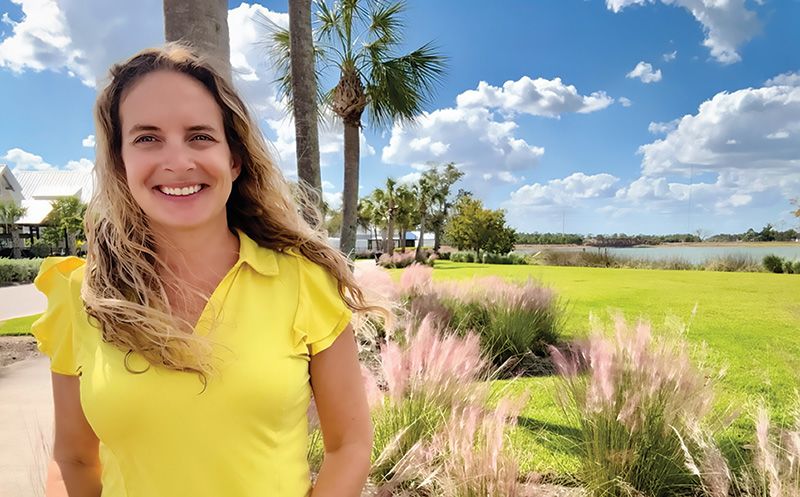
Amy Wicks Paving Sustainable Pathways Defending Florida’s Gulf Coast Communities
Amy Wicks is living a sustainable engineer’s dream as the architect of innovative, groundbreaking ecological practices that’s inspiring future city planning to withstand catastrophic weather disasters.
The 2004 civil engineering alumna had a lead role in the development of greenspaces and a sustainable stormwater collection system that’s accentuating life for residents of America’s first solar-powered town, Babcock Ranch, located 12 minutes northeast of Fort Myers, Florida. Behind Wicks’ work, the town withstood the wrath of Hurricane Ian in September 2022 and is ready for the next storm in Florida’s annual six month-long hurricane season.
Starting with a blank canvass consisting of approximately 18,000 acres of former logging and agricultural land, Wicks designed a series of bio-swales, and rain gardens that connect to detention ponds and create wetlands simulating Florida’s natural swamps.
“(Babcock Ranch) gave me a platform to be creative,” says Wicks, who has worked on the community project since 2006. “My whole career has been an adaptation to this new concept—I don’t know anything other than constantly changing, constantly evolving, and looking for new ideas for how to do things.”
Wicks’ sustainable plans helped Babcock Ranch come away nearly unscathed when Hurricane Ian brought 21 inches of rain, 150 mph sustained winds, and storm surges up to 18 feet to the area as the community, where she also lives with her husband and three children, was in the direct path of the storm’s eye. In fact, it was the only housing development in the region that didn’t suffer flooding or electrical outages and had available drinking water throughout the harrowing period when the Fort Myers region was left devastated in the wake of the fierce Category 4 hurricane.
“It was 10 of the most stressful hours of my career,” Wicks recalls. “Because I live at Babcock, I kept looking out my window thinking ‘When am I going to see what I forgot?’ Years of planning and lots of hard work were really put to the test. We had prepared for the worst case. It was a relief more than anything the next morning that everything worked as had been planned.”
Wicks and other members of Babcock Ranch’s planning team consulted maps from the 1940s, before the land was developed, to examine the natural water flows during periods of high rainfall. The community’s houses, golf courses, forest trails, and bicycle paths were situated around strategically placed lakes and other surface water features that absorb excess rainfall, and react with the land both utilizing the natural environment and mimicking it where manmade features exist.
Redundancies were built into the system to make sure if one aspect is affected—possibly a downed tree—water is then averted to another retention pond or marsh area. Nearby is an 870-acre solar farm with nearly 700,000 solar panels generating 150 megawatts of reliable energy.
Now, Wicks’ consulting company is pursuing similar projects that advance sustainable development, and she has been more vocal in her advocacy of implementing design strategies to minimize destruction in the wake of climate change.
“Babcock Ranch showcased what could be done. I want more of these projects. They’re important to society in general,” said Wicks, who earned a master’s degree in water resources planning and management with a focus on sustainability. “As an engineer you want to grow and innovate. (After Hurricane Ian) there was almost a sense of loss because nothing had gone wrong, so I couldn’t make it better for the next time. Now, I have to make sure we’re more prepared for the next time ... My (career) focus has been bringing the civil and environmental environments together so that they coexist in nature. I love exploring beyond where the level of the current understanding of everything is.”
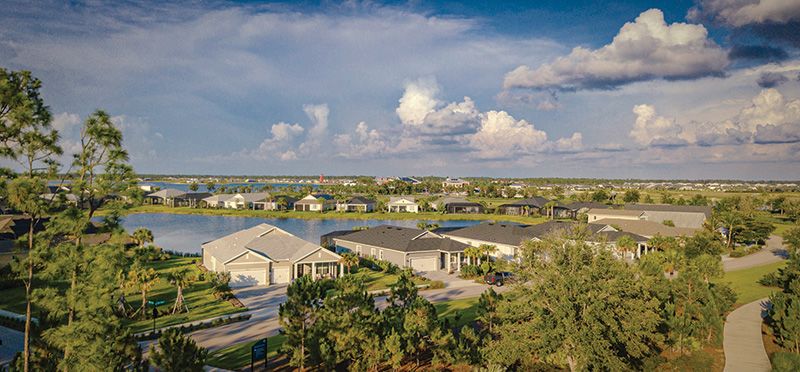
Babcock Ranch’s development team consulted with maps from the 1940s to determine the appropriate features for the planned community near Fort Myers, Florida.
Babcock Ranch’s development team consulted with maps from the 1940s to determine the appropriate features for the planned community near Fort Myers, Florida.
CALL OF DUTY
Michael Radigan Taking 3D Printing to New Heights
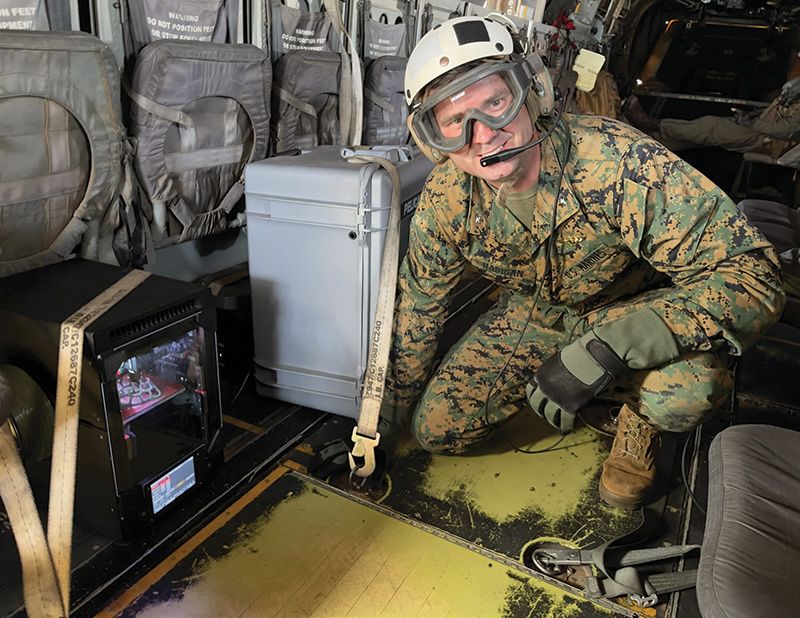
Technology is soaring to new heights through innovative in-flight 3D printing techniques being pioneered for the U.S. military by a group that includes 2005 mechanical engineering alumnus Lt. Col. Michael Radigan.
As a Naval Postgraduate School liaison from the Marine Innovation Unit, Radigan is helping accelerate the adoption of advanced manufacturing capabilities like 3D printing to increase readiness in battlefield environments. These efforts spearheaded the first successful demonstration of in-flight 3D printing to simulate a rapid response for injured military personnel. The June 2023 demonstration created a medical wrist cast that was printed mid-flight aboard a Marine Corps MV-22 Osprey aircraft.
“Opening the door for mobile on-demand manufacturing from the air could be a game-changing capability for expeditionary operations,” he says.
Radigan’s involvement in inflight 3D printing builds on over two decades of military experience as an AH-1Z Cobra pilot, Weapons and Tactics Instructor, and additive manufacturing expert across defense agencies. “I love bringing together diverse, cross-functional teams and overcoming challenges to turn innovative ideas into operational realities that support our warfighters wherever and whenever necessary,” he states.
Beyond on-demand medical devices, 3D printers on aircraft, ships, and ground vehicles could produce spare parts, tools, shelters, and other critical equipment for troops in the field. “The ability to rapidly design and manufacture exactly what is needed, on location, could provide an enormous strategic advantage,” he explains.
Radigan believes 3D printing can enable new logistical and operational concepts, like forward operating bases with land, air, and sea-based manufacturing facilities.
“Logistics, maintenance, and medical support could all be radically transformed, right down to the tactical edge, by making additive manufacturing universally available,” he remarks.“Resupplying remote outposts using traditional methods can be challenging and costly. 3D printing will bolster the existing supply system for contested environment. A single aircraft carrying an array of printers can have the productivity of a small factory, delivered right to the point of need. The operational effects could be profound.”
After being a reservist with the Marine Innovation Unit, Radigan returned to active military service earlier this year. He’s now pushing teams to think creatively about expeditionary applications because, as he says, “We’re just scratching the surface on the capabilities that will come from mobile production at scale in a variety of platforms. I’m excited to see what’s possible as we continue to optimize and expand this capability going forward.”
Yvette Tyler Engineers Devices to Explore the Final Frontier
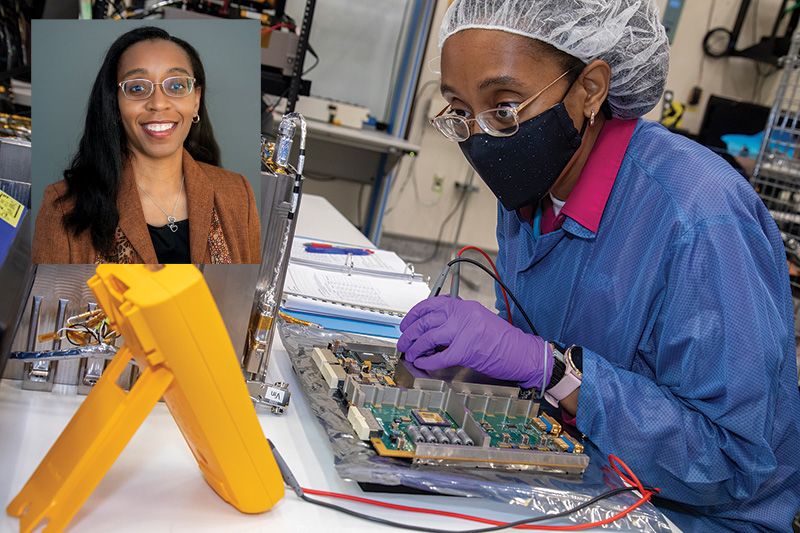
Southwest Research Institute Staff Engineer Yvette Tyler (EE, 2002) performs integration and testing on the electronics box for Europa Clipper’s mass spectrometer, set to be launched to Jupiter in October 2024.
Southwest Research Institute Staff Engineer Yvette Tyler (EE, 2002) performs integration and testing on the electronics box for Europa Clipper’s mass spectrometer, set to be launched to Jupiter in October 2024.
Can life be sustained on Jupiter?
That’s what NASA is investigating with its Europa Clipper device, set to launch in October 2024 to explore Jupiter’s icy moon, Europa, and consider whether it could harbor conditions suitable for life
on the planet.
This is just one of the many projects that Yvette Tyler, a 2002 electrical engineering alumna, has contributed to as a staff engineer with the Space Systems Division of Southwest Research Institute (SwRI) in San Antonio, Texas.
Tyler has been working for the company in various roles for the past 21 years, joining SwRI after graduation. Her career began as a test engineer and later progressed to being the lead engineer or avionics boxes. She also has worked on several projects, performing system engineering work related to design architecture, integration, verification, validation, and analysis.
Over the last several years, Tyler has led all facets for the design and development, as well as integration and testing, of the electronics box on the Europa Clipper mission known as the MAss SPectrometer for Planetary EXploration (MASPEX) instrument. The mass spectrometer will analyze gases in Europa’s faint atmosphere and possible plumes. It will also study the chemistry of the moon’s suspected subsurface ocean, how ocean and surface exchange material, and how radiation alters compounds on the moon’s surface.
“I was responsible for making sure all the electronic boards within the box communicated and operated with each other and supported the instrument,” says Tyler. “I was also responsible for overseeing all the testing activities and final integration and test of the box
before delivery to (NASA’s) Jet Propulsion Laboratory.”
Tyler’s focus has shifted to working on a miniature fast neutron detector for the moon lander project. This is the third generation of a series of Radiation Assessment Detectors (RAD) on which she has worked. The first one was for the Curiosity Rover, the largest and most capable rover sent to Mars as part of NASA’s Mars Science Laboratory mission. The second became part of the International Space Station. Tyler’s current project is a portion of what was sent to the space station and will be included in the moon lander.
Tyler, a first-generation college student, believes her Rose-Hulman education has led to her successful engineering career.
“When I got to SwRI, my supervisors and leaders were pleased with all my lab experience at Rose,” she states. “Those years really taught me how to learn, which has helped the on-the-job training at SwRI.”
Four Standouts Added to Athletic Hall of Fame
The Athletic Hall of Fame roster increased this fall with the addition of four record-setting student-athletes from the Classes of 2011 and 2013 who earned national, regional, and conference honors in five different sports. These honorees were:

Paul Bouagnon (BE, 2011) was the Heartland Collegiate Athletic Conference’s Indoor and Outdoor Track Athlete of the Year (2011), a nine-time HCAC track champion, and a first-team all-conference soccer player (2010). He was part of three school-record setting relay teams and a NCAA Division III national qualifying 4-x-400 relay team. In soccer, Bouagnon scored 12 goals and had six assists and contributed to the first Rose-Hulman team to qualify for the NCAA tournament (2008).
He is a global space industry business development manager with National Instruments.

Creasy Clauser (BE, 2013) was the HCAC Indoor Track Athlete of the Year (2012) and a 10-event league champion who graduated with 10 school records (six indoors/four outdoors). She went on to earn a master’s degree in biomedical engineering from IUPUI before joining Cook Medical’s research and development staff, managing vascular research projects.

Kyle Kovach (CE, 2013) earned the Ruel Fox Burns Blanket as the top graduating male athlete (2013) after setting school football records for career rushing yards (3,631) and all-purpose yards (6,134), while ranking second in history for rushing touchdowns (39) and total touchdowns (47). He earned third-team Little All-America honors along with being a two-time all-North Region selection. Kovach is a project manager with RoadSafe Traffic Systems after working with the Walsh Group in the Chicago area.

Anna (Lewer) Dorsey (BE, 2013) earned first-team all-HCAC honors during all four of her seasons on the volleyball court and was named the league’s Most Valuable Player in 2012. She anchored the first RHIT team to earn a conference championship and qualify for the Division III national tournament (2011). Dorsey also became the first Engineer to surpass 1,000 kills and 1,000 digs in school history, and still ranks among the program’s all-time best in kills, digs, and blocks. She is a regional sales manager with National Instruments.
See the entire Athletic Hall of Fame list at
www.rose-hulman.edu/hof.
Nellie Hohne Continues Service as Advisory Board President
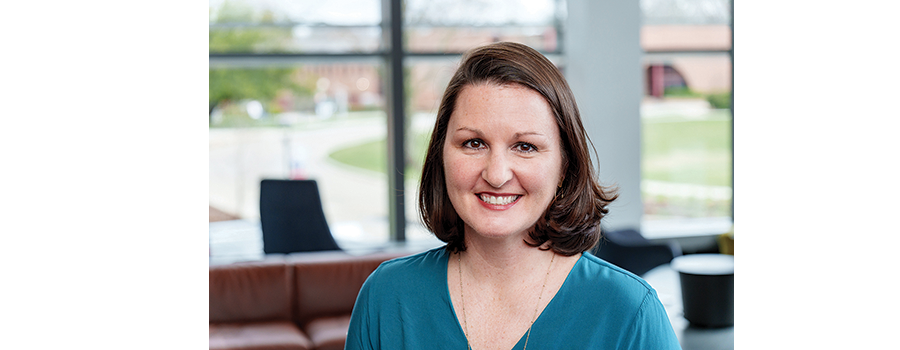
The sense of community that Nellie Hohne (ME, 1999) thoroughly enjoyed as a student is continuing as a proud and loyal alumna who has begun a two-year presidency of the Alumni Advisory Board. Hohne succeeds Kedar Murthy (CHE, 1984), who is now the group’s past president.
Hohne has been an AAB member for nearly the past decade, serving as vice president (2021-23) and chair of the board’s awards committee.
She and her husband, Dan Hohne (CHE, 1999), have established the endowed Hohne-Magnanti Scholarship fund (named on behalf of their families) to help Rose-Hulman students realize their career goals while sharing the same experiences the couple enjoyed as campus leaders and dedicated students.
“The Alumni Advisory Board is a great way to stay involved with campus, help out the college and keep up to date on the changes that are continuously happening,” says Nellie, a former Chi Omega sorority chapter leader. “Dan and I truly enjoyed our time at Rose and try to get back as often as we can for Homecoming and other special events.
“Rose-Hulman gave us so much. The day that I walked across the stage and received my diploma is still one of the proudest moments of my life. I will never forget the experience that I had (at Rose) and want to give back and help in any way I can,” she continues. “We established the scholarship fund to honor the support our families provided us, while ensuring that other students have the same opportunities that we enjoyed. If we can help another student afford to attend Rose, we’re more than happy to do so.”
The Hohnes live in Newburgh, Indiana, where they are raising their two children to possibly follow in their parents’ pathways in science, technology, engineering, or mathematics. Both children have joined Nellie and Dan during campus trips and the oldest child, a high school junior, is just starting the college search process. A recent campus visit included a glimpse inside the Baur-Sames-Bogart (BSB) residence hall room that Nellie lived in during the 1995-96 school year as a member of the college’s inaugural incoming class of female first-year students.
“It was nice to see our artwork and signatures still on the BSB hallways, just as we (members of the Class of 1999) left them,” Nellie said. “Rose felt like home from the time I first visited campus (from Texas) to today when I return for alumni events. It’s a special place, with great people and strenuous academics, that I hope others can enjoy.”
OTHERS BEGIN AAB TERMS
Amanda Stapleton (ME, 2006) has started a two-year term as the Alumni Advisory Board’s vice president. Other officers include Dieter Schultz (CE, 2016), as co-chair of the Student Recruitment Committee; Gary Bullock (EE, 1975), chair of the Career Services Committee; and Mike Chaney (CHE, 1981), chair of the Awards Committee.
Meanwhile, beginning two-year AAB terms are:
— Amy Cary (CHE, 1998)
– R. Neil Irwin (CE, 1963)
– Andrew Novotny (ME, 2020)
– Bill Schott (MA, 1974)
– Casey Schroeppel (CHE, 2004)
– Jeffery Smiley (CE, 2008)
– Floyd Yager (MA, 1989)
Postcards
From the Road
The Office of Alumni Relations hosted events across the country that brought alumni together this summer and fall to get campus updates from President Robert A. Coons and other institute leaders. Alumni also exchanged shared campus experiences and had lots of fun times reconnecting. More activities are planned for 2024.
Check out upcoming events at
www.rose-hulman.edu/alumni.

Here are this issue’s problems, provided by Herb’s son, Mark Bailey (CHE, 1976):
WINTER PROBLEM 1
In multiplying two numbers, ‘a’ and ‘b’, Sam reversed the digits of the two digit number ‘a.’ His erroneous product was 161. What is the correct value of the product of ‘a’ and ‘b’?
WINTER PROBLEM 2
Julie walks around a track at exactly the same constant speed every day. The sides of the track are straight and the ends are semicircles. The width of the track is six meters. It takes her 36 seconds longer to walk around the outer edge of the track than the inside edge. What is Julie’s speed in meters/second?
WINTER BONUS PROBLEM
Find the length of the red band around the two circles:

SUMMER PROBLEM SOLUTIONS
Problem 1: 82 | Problem 2: 5.4 | Bonus Problem: 63
Send your solution to BaileyChallenge@rose-hulman.edu or to:
Dale Long, CM 14, Rose-Hulman Institute of Technology, 5500 Wabash Ave., Terre Haute, IN 47803. Alumni should include their class year.
Congratulations to the following solvers of the spring problems:
ALUMNI: T. Jones, 1949; P. Cella, 1958; D. Bailey, 1959; B. Perkins, 1960; R. Archer, 1961; L. Hartley, 1961; J. Ray, 1961; J. Tindall, 1961;
N. Hannum, 1962; R. Lovell, 1963; S. James, 1965; P. Lilienkamp, 1965; B. Radecki, 1965; P. Carter, 1966; R. Kevorkian, 1966; R. Dutton, 1969;
D. Jordan, 1971; R. LaCosse, 1971; W. Pelz, 1971; S. Sample, 1971; G. Houghton, 1972; C. Martens, 1972; Randy Collins, 1973; R. Kominiarek, 1973; M. Marinko, 1973; J. Walter, 1973; T. Rathz, 1974; R. Herber, 1975; B. Hunt, 1976; J. Schroeder, 1976; R. Arney, 1978; T. Greer, 1978; D. Hoffman, 1978; R. Priem, 1979; J. Slupesky, 1979; J. Koechling, 1980; J. Farrell, 1981; S. Nolan, 1981; M. Taylor, 1982; D. Batta, 1983; D. Churilla, 1983; J. Farrell, 1983; S. Hall, 1983; J. Marum, 1983; C. Wilcox, 1985; J. Byerly, 1986; C. Hastings, 1986; J. Short, 1986; D. Johnson, 1987; M. Lancaster, 1987; M. Nigrovic, 1987; B. Seidl, 1987; J. Jachim, 1989; J. Harrell, 1990; B. Burger, 1991; R. Hochstetler, 1991; C. Schlimm, 1991; K. Koziol, 1992; R. Antonini, 1993; W. Haas, 1993; M. Pilcher, 1998; J. Mathison, 1999; E. Behrens, 2000; M. Burke, 2000; V. Fong, 2001; B. Hirsch, 2004; C. Krepps, 2004; J. Somann, 2004; V. Roczniak, 2006; R. Solotke, 2006; T. Homan, 2007; M. Rooney, 2011; B. Lackey, 2013; R. Oberlitner, 2020; and
J. Ansari, 2023
FRIENDS/STUDENT: J. Castle, T. Cutaia, G. Gstattenbauer, E. Haggerty, R. LeMay, J. Marks, T. Martin, L. Metcalfe, M. Russell, J. Slawski, B. Toftner,
J. Walsh, J. Walter, and E. Wern
The summer issue’s problems provided by mathematics professors Timothy All, Sylvia Carlisle, and John McSweeney proved to be quite a challenge, especially the bonus problem that had a small percentage of correct solvers.
Maybe, as Sherley Sample (ME, 1971) suggested, watching the “Ted Lasso” television series helped unlock clues to answer the problem about soccer’s English Premier League divisions.
“This crop of problems were real toughies. I have to say that I struggled,” says George Houghton (PH, 1972), who met the challenge with three correct solutions.

Robert Lovell (MA, 1963) also enjoyed this summer’s challenges. He emphasized problem-solving in a 50-year career as a high school math teacher, receiving Indiana’s Presidential Award for Excellence in Mathematics and Science Teaching in 1983.
“I have enjoyed the Bailey Challenges and share them with a Cal Tech friend,” he remarks.
Lovell, among Rose Polytechnic Institute’s first class of math alumni, attended the 60th reunion of the Class of 1963 during this year’s Homecoming.

Bill Perkins (CE, 1960) has become a regular Challenge solver after retiring as a professor of information systems and decision sciences with Indiana University’s Kelley School of Business.
“I keep doing the problems simply because I enjoy being logically challenged,” he states. “The hardest problems for me are the geometry problems, with lots of triangles and angles in a figure, as well as logic problems, with many facets
to the problem, such as this summer’s bonus problem.”

Roger LaCosse (ME, 1971) had been a longtime casual Challenge solver and didn’t begin submitting answers for review until several years ago. “I enjoy working puzzles,” he says. “Some (of the problems) are very straightforward, like the aquarium problem, and some are very subtle and complex,
like the (bonus) soccer problem.” LaCosse enjoyed a 35-year career with BFGoodrich that took him throughout the world.
CLASS NOTES
60s
Craig H. Weerts (ME, 1968) is the proud father of Jennifer Weerts Rumsey, who is the new chairperson of Cummins, Inc.’s Board of Directors, along with being the company’s president and chief executive officer.
William W. Myers (MA, 1969) published an article
on Medium.com about Rose-Hulman’s impact on a lifetime of personal and professional changes.
70s
Bill L. McNiece (EE/MA, 1973), M.D., serves as president of the Marion County Historical Society in Indianapolis, where he is a physician and practicing anesthesiologist.
Peter A. VandeMotter (EE, 1977) has received the Albert Nelson Marquis Lifetime Achievement Award from the Marquis Who’s Who organization. He is a senior electrical engineer with SpaanTech in Chicago.
80s
David Wachenschwanz (PH, 1982) has been promoted to director of development with SmartOrg., where he has had leadership roles since 2018.
Terry F. Schuster (CE, 1983) is the energy storage
sales director with Fluence in Chicago. He formerly was in sales and business operations with Schneider Electric, Siemens, and Johnson Controls.

Donald W. Lincoln (PH/MA, 1986) has authored “Einstein’s Unfinished Dream: Practical Progress Towards a Theory of Everything” (Oxford University Press), his latest book about particle physics.
Dennis D. Dobbs (CE, 1987) has retired as vice president of gas engineering and supply with CMS Energy and its principal subsidiary Consumers Energy. He spent 20 years with the company.
Ken W. Roberts (ME, 1988) is now president of
Atlas Roofing Corporation after a 30-year career
with Masco Corporation, most recently as president of Delta Faucet.
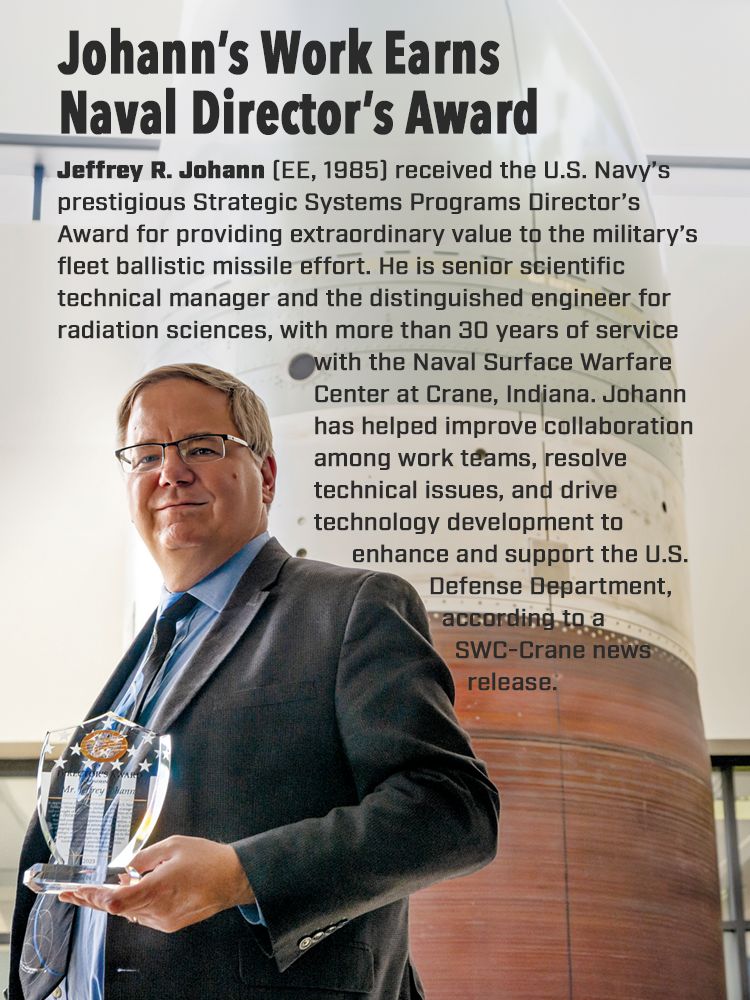
90s
Trevor D. Arnold (CHE, 1990) has retired as chief intellectual property counsel with Arthrex, Inc., a medical device company. His 30-year legal career spanned several law firms and in-house IP counsel positions.
Eric S. Cooper (ME, 1990) has been promoted to director of technical services/manufacturing science with Eli Lilly and Company, where he has worked since 2002.
Daniel J. Keown (BSCHE, 1991/MSEMGT, 2011) has been promoted to vice president with Steel Dynamics and general manager of the company’s flat roll steel division, based in Columbus, Mississippi. He has worked in a variety of roles since joining the company in 1998.
Phil D. Poor (CHE, 1992) is a senior engineering advisor with Eli Lilly and Company’s Indianapolis operations.
Leslie F. Donaldson (CS, 1994) is a senior software developer with i3 Verticals.
Gregory A. Meyne (ME, 1994) is senior director of automation with enVista, helping warehouse and distribution clients optimize their facilities.
Agnes P. Berzsenyi (MSME, 1995) is a member of Seno Medical Instruments, Inc.’s board of directors. She spent more than 27 years with General Electric Company.
Jonathan E. Rich (ME, 1995) is director of vehicle closure systems with General Motors Company,
where he had a variety of roles since 1997.
Wiley S. Abner (ME, 1996) is vice president of engineering and quality at Metal Powder Products.
He has had a variety of leadership roles since joining the company in 2018.
Steven M. Goetz (EE, 1996) is the chief technology officer with Motif Neurotech, a clinical-stage company developing minimally invasive bioelectronics for mental health. He has more than 160 patents from 26 years with Medtronic, leaving as vice president of technology and platform innovation.
Jerome O. Williams (ME, 1996), director of roofing operations with Owens Corning, helped the company be recognized as a finalist for the National Association of Manufacturers’ 2023 Manufacturing Leadership Award.
Craig T. Donze (CE, 1997), as engineering manager
with Walbec Group Inc., led a resurfacing project of
Road America’s road course in Wisconsin which hosts a variety of motorsports events annually.
Barry C. Portman (ME, 1997) is chief executive
officer with BCP Resources, which has acquired
Chord Energy Corporation’s assets spanning
16 oil fields throughout West Texas’ Permian Basin.
James R. Kanicky (CHE, 1997) is chief executive
officer/president with the PureTech Scientific after serving as business manager of the chemical supplier’s glycolic acid division. He has more than 20 years of industrial/specialty chemical experience.
Rimas J. Guzulaitis (BSEE, 1998/MSEMGT, 2003)
is vice president of enterprise integration and transformation with V2X, a global government
services provider. He formerly was special projects
vice president with Raytheon subsidiary RTX.
Nathan J. Jenniges (EE, 1998) has been promoted to senior vice president/general manager of Blackberry’s cybersecurity products. He leads more than 500 engineers, project managers, designers, and operations teams throughout the world.
Jassem Saleh Busaibe (CS/ECON, 1999) is chief executive officer with Aldar Investment, a division of Aldar Properties in Abu Dhabi, United Arab Emirates.
Col. Andrew J. Emery
(CPE, 1999) has retired from the U.S. Space Force after more than 24 years of active military service. He was a deputy program executive officer for space sensing within the Space Systems Command and served as a program manager, engineer, and space operator in a variety of other space mission areas.
Morgan A. Hawker (CE, 1999) is now a senior project manager with Prime Engineering, Inc., in Louisville. She formerly was a project management consultant.
Mikael R. Nielsen (ECON/MA, 1999) is director of leadership giving for Mercy For Animals, a global organization that’s striving to end industrial animal agriculture.
J.P. Williams (ME, 1999) earned brown belt ranking in Brazilian Jiu Jitsu from the Renato Tavares Association.
00s
Alyssa A. (Riley) Hill (CHE, 2000), MD, is a pediatric nephrologist and director/physician advisor of clinical documentation/revenue integrity with Nationwide Children’s Hospital in Toledo, Ohio, her hometown.
Mary Kokosa (ME, 2000) is now director of global
on-highway and electrification product management with Allison Transmission. This is her latest management position with the company.
Bradley C. Nord (ME, 2000) is the lead mechanical design engineer with BorgWarner Inc.’s automotive division.
Robin (Harvey) Pruss (ME/AO, 2001) has been
promoted to senior staff opto-mechanical engineer with Northrop Grumman Corporation, where she has had a variety of roles since graduation.
Bradley Berron (CHE, 2002), PhD, is research director of the University of Kentucky’s James B. Beam Institute, the largest teaching distillery in the world. It offers a certificate program in distillation, wine, and brewing.
Meryl L. Dillon (ME, 2002) is the global marketing manager for Hollister Incorporated’s continence care division in Chicago.
Peter J. Gunderson
(CHE, 2002) is vice president for manufacturing with WATT Fuel Cell Corporation, helping launch commercial production of the company’s natural gas-powered solid oxide fuel cell systems. He formerly was engineering director of Thailand-based Magnecomp Precision Technology.
Matthew A. Price (ME, 2002) is now the head
of facilities engineering and asset management
with Rolls-Royce in London, England.
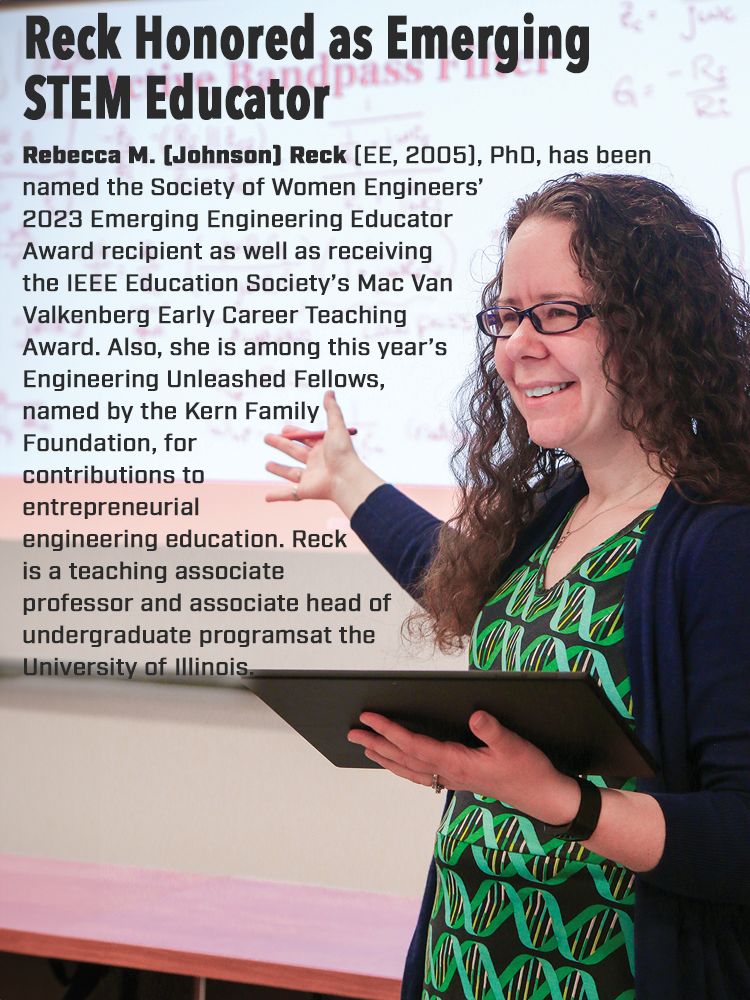
Krista S. Williams (ME, 2002) is the chief executive officer with Carlile, Alaska’s leading trucking and logistics company. She formerly was chief operating officer with Saltchuk Logistics, Carlile’s parent company which she joined in 2018.
Jason J. Meyer (CE, 2003), JD, was appointed to the executive committee of the American Council of Engineering Companies of Minnesota’s board of directors. This is the business and policy advocate for the state’s consulting engineering firms. He is a client service manager with Stanley Consultants in Minneapolis.
Alla (Genkina) Weinberg (CS, 2003), PhD, chief executive officer with Spoke and Wheel, is a culture designer and work relationship coach who works with business leaders globally to create safe, trust-based workplace cultures.
Andy M. Orlowski (CPE, 2004) is director of field applications engineers with Dwyer/Omega, where he has worked since graduation.
Scott R. Small (BSME, 2005/MSBE, 2007) is the interim director of digital data science with Novo Nordisk in Oxford, England.
Ming S. Cheung (ME, 2006) is director of national accounts with SKF Group. He formerly was a senior
sales engineer with Timken Company.
Jeremy D. Vickery
(CS, 2006) was featured in Technical.ly’s list of those engineers who have pioneered technology solutions to foster diversity and inclusion within Baltimore’s tech ecosystem. He is a senior software engineer, specializing in research and development projects, with T. Rowe Price.
Matthew W. Wittstein (BE, 2006), PhD, received an Excellence in Service/Leadership Award from Elon University (North Carolina), where he is an assistant professor of exercise science.
Amy S. Knue (BE, 2007) is vice president of mobile equipment services for TRIMEDX, where she has had a variety of leadership roles for more than 10 years.
Nic Schmidt (ME, 2007) is now commanding the
U.S. Space Force’s 17th test and evaluation squadron. This continues his U.S. Air Force career.
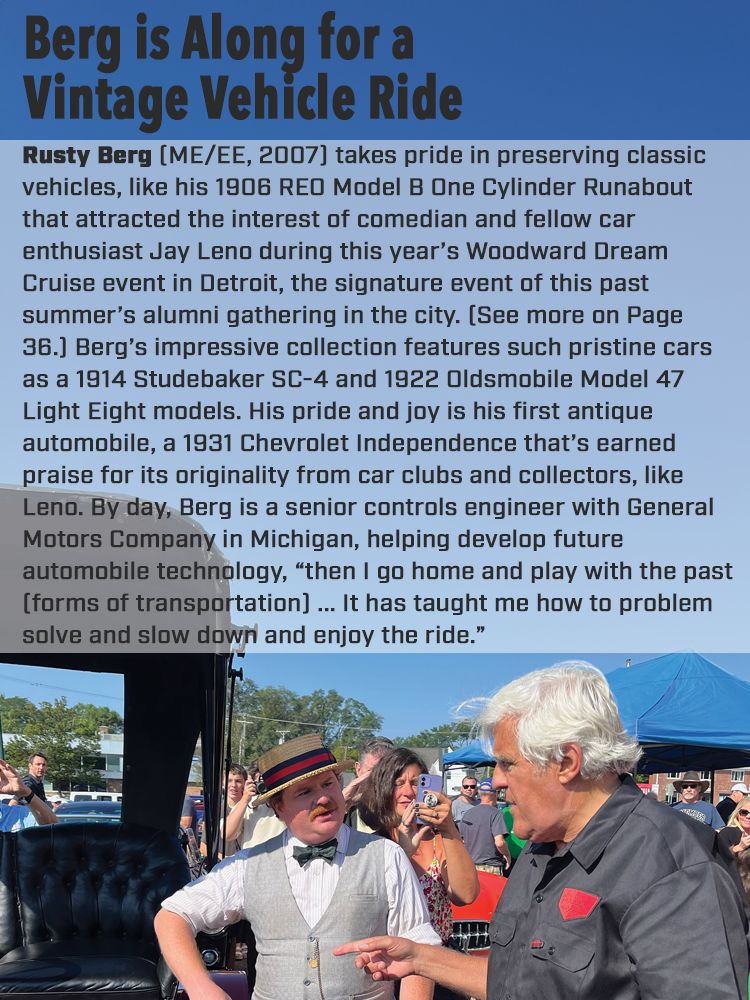
Eric M. Lucas (BE, 2007) was named one of this
year’s best and brightest executive MBA students attending Washington University’s Olin School of Business. He also is vice president for technology
with Ulrich Medical USA.
David P. Bander (AB, 2008), managing director
with the Kirkland Performance Center (Washington), was honored among eastern Washington’s 40 Under 40, chosen by 425 Business.
Thomas S. Reives (BSME, 2008/MSEMGT, 2010) has been promoted to senior director of Eli Lilly and Company’s Indianapolis active pharmaceutical ingredient manufacturing division. He has had a variety of operational leadership roles with the company since 2012.
Danny B. Teixeira (MSEMGT, 2008) is the vice president/general manager of thermoforming solutions with Rohrer Corporation. He formerly was vice president of operations with IDEX’s North American fire and safety business.
Xiaofeng Tao (CS/SE, 2008) is now a principal
software engineer with Microsoft Corporation,
where he has worked since 2013.
10s
Kristin E. (Greer) Flaker (BE, 2010) is director
of nursing with the Springfield (Ohio) Regional
Outpatient Surgery Center. She has been a registered nurse since 2012.
Tim J. Tepe (ME, 2010) is director of development with Roebling Development Company. He formerly had leadership roles with Sam’s Club and Kroger Company.
Amber K. (Knust) Lee (ME, 2011) is a design
lead with Eli Lilly and Company, where she has
worked since 2021.
Stephen C. Owen (CE, 2011) has been promoted to marine engineering senior project manager with Marine Solutions, Inc., where he has worked since 2017.
Jane E. Canada (CE, 2012) is a senior engineer for the city and county of Denver. She formerly was a senior transportation engineer in WSP’s Indianapolis office.
Caleb D. Nickels (CE, 2013) is the field operations manager of solar and energy storage systems with
MasTec Clean Energy & Infrastructure. He formerly
was manager of field engineering with Infrastructure and Energy Alternatives, Inc.
Nick A. Birch (ME, 2014) is helping grow tech talent with United Airlines. He formerly was a vice president with the nonprofit Eleven Fifty Academy in Indianapolis.
Lauren Gutgesell (CHEM, 2014) has been promoted
to a senior scientist with 10x Genomics, where he
has worked since 2021.
George E. Green (CE, 2015) is vice president with ARCO National Construction Company in St. Louis,
where he has worked since 2016.
Gene S. Kum (CE, 2016) is a civil structural engineer with NASA’s Jet Propulsion Laboratory. He had been a structural engineer with Buro Happold.
Madison A. (Thompson) Murphy (BE, 2017) has earned an associate degree in biblical studies from Ethnos360 Bible Institute.
Christopher Wood (ME, 2017) is a staff aerodynamicist with Tesla, where he has worked since graduation.
Ehsan Ordouie (MSOE, 2018), PhD, was lead author of a study at the University of Central Florida that has developed new technology to make data transfer over optical fiber communication faster and more efficient.
Tucker D. Pletcher (CHE, 2018) has been promoted to manager of Sun Chemical Corporation’s environmental, health, and safety systems operations.
Anna K. Braun (CHE/CHEM, 2019), PhD, co-authored an article for the Joule scholastic journal resulting from research conducted at the Colorado School of Mines that could make III-V solar cells more affordable and efficient. She is now a research scientist with SRI International.
Jonathan P. Jones (CHE, 2019) has received a patent for stacked-plate distillation column technology developed as a physical chemistry and instrumentation scientist with Johns Hopkins University’s Applied Physics Laboratory.
Richard Kong (CHE, 2019) has been promoted to senior corporate process engineer in North American Lighting, Inc.’s plastics and molding division.
Aaron J. Prins (ME, 2019) is an automation engineering manager with Sam’s Club.
Lt. Col. Linnell G. Williams (ME, 2019) is now a
flight commander with the U.S. Space Force.
20s
Jamari J. Morrison (SE, 2022) was named to Forbes’ inaugural 30 Under 30 list honoring people bringing innovation to Seattle’s business community. He is co-founder of Pongo, a startup using AI to build search engines for businesses.
Alexa R. (Kovacs) Myers (MA/ECON, 2022) was an honoree in Indianapolis’ Tech 25 of the Year program, recognizing those excelling at using technology to help their employers achieve strategic goals. She is a data science manager with Resultant.
Teaching Trio Now in
Front of Campus Classes
Three former classmates, lab partners, and roommates have returned to Rose-Hulman to begin their teaching careers.
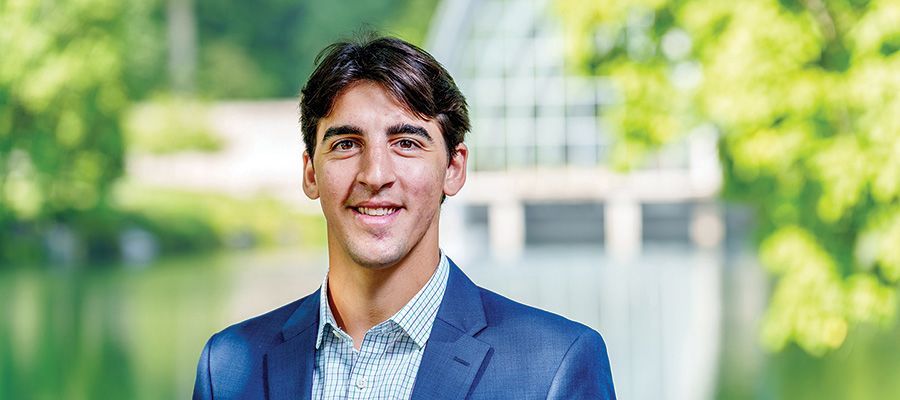
Georges Adam (ME/EP, 2017), PhD, is a visiting assistant professor of mechanical engineering after being a postdoctoral researcher in Purdue University’s Multi-Scale Robotics and Automation Lab. He performed research in microrobotics.

Nathan C. Brooks (EE, 2016), PhD, is an assistant professor of electrical and computer engineering. He had been a graduate research assistant at the University of California, Berkeley, where his focus was on power electronics.

Ian G. Ludden (CPE/MA, 2016), PhD, is an assistant professor of computer science and software engineering after being an instructor and earning outstanding teaching assistant honors at the University of Illinois. His thesis was on graph partitioning.
WEDDINGS
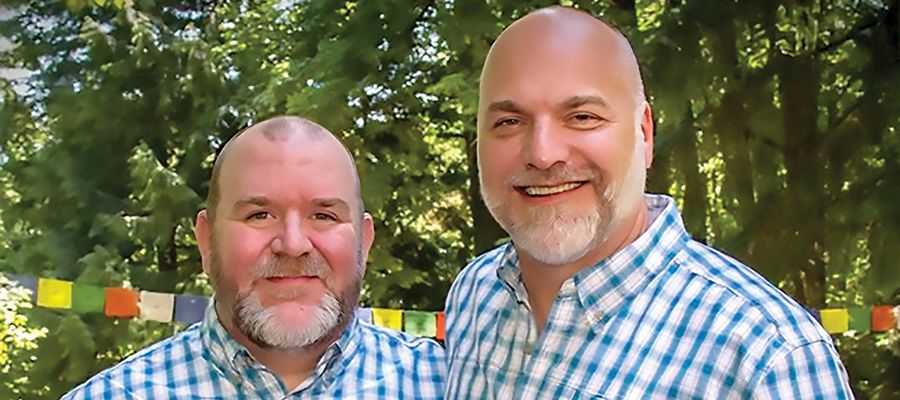
Chris S. Mandeville (ECON, 1988) and husband Jack were married June 24, 2017, in Portland, Oregon. They are now living in Lafayette, Oregon, where Chris is a business systems analyst with the Oregon Public Employees Retirement System.
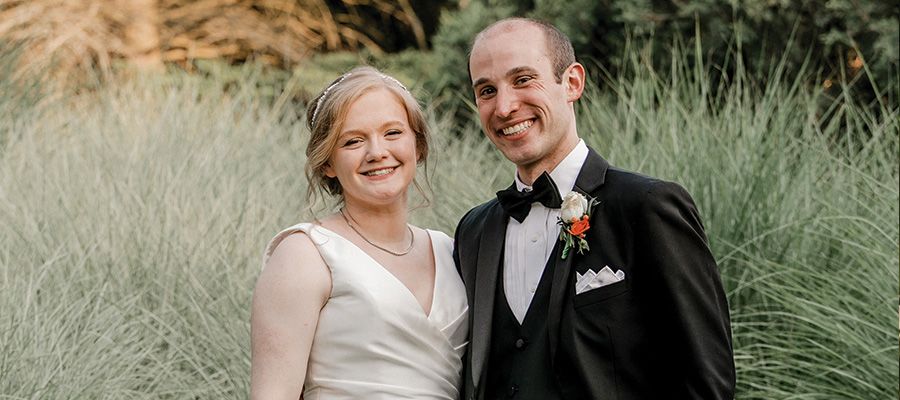
Rachael E. Ilic (CHE, 2015) married Danny Sperling on June 17, 2023, in Aurora, Ohio. The couples lives in the Cleveland area where Rachael is a senior chemist with Sherwin-Williams’ Research & Development Department.
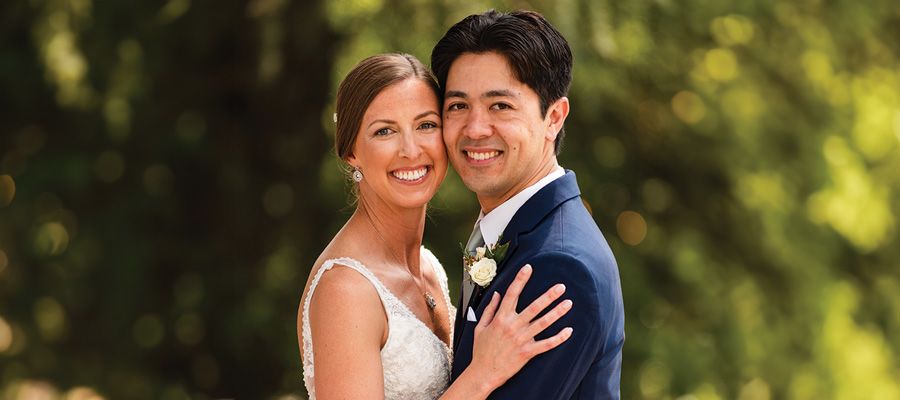
Jamie B. Myers (CHE, 2005) married Henrique K. F. Noguchi on June 17, 2023, in Greenville, South Carolina, with several alumni in attendance. A second wedding ceremony is planned on December 16, 2023, in Henrique’s hometown of Sao Paulo, Brazil. The couple lives in Greer, South Carolina, where Jamie is a principal engineer with Milliken & Company.

Tucker D. Pletcher (CHE, 2018) and Savhana Ciula were married on August 14, 2021, in Nappanee, Indiana. Groomsmen were Wesley D. Umbower (CHE, 1978) and Daniel B. Moore (CHE, 2018).
ROSEBUDS
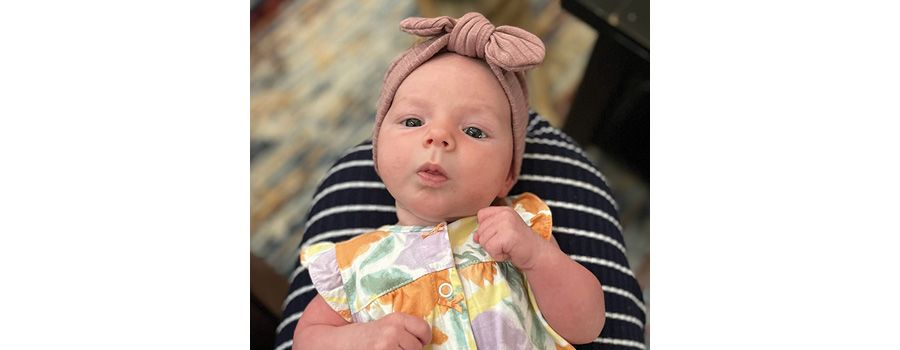
Alix (McLaughlin) Gadbois and husband, Parker, had a daughter, Penelope, on July 18, 2023, in Carmel, Indiana. She is the granddaughter of Scott McLaughlin (ME 1981), who owns McLaughlin & Associates Thermal Spray.

Caryl M. Hornberger (CPE, 2001) and wife, Ania, welcomed their third child, daughter Rozalia, on June 10, 2023. The family resides in Kendallville, Indiana. Caryl owns his own software company, The Jaxel Corporation.
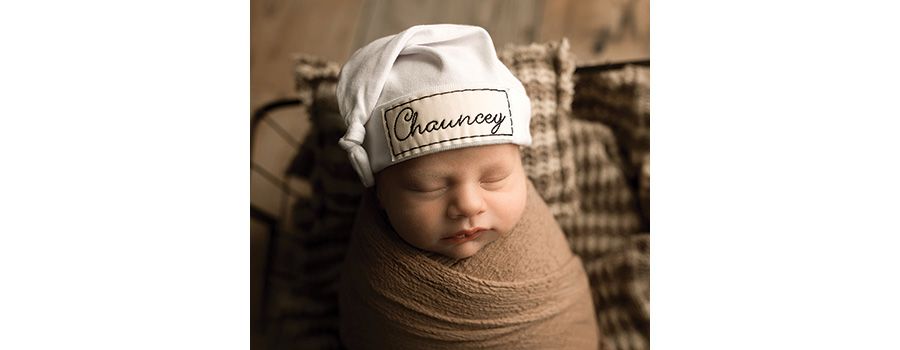
Kyle A. Rhodes (SE/PH, 2010) and wife, Maggie, had their first child, son Chauncey, on June 26, 2023, in Terre Haute. He is a business process analyst in Rose-Hulman’s Office of Student Affairs.

Cameron B. Twarek (ME, 2011) and wife, Allison, had a son, Peter, on March 19, 2023. The family lives in Pittsburgh, where Cameron is a senior engineer with the Bechtel Marine Propulsion Corporation’s Naval Nuclear Laboratory.

Heather Demor (ME, 2012) and husband, Jordan Oja (BE, 2012), had their second child, John Oja, on July 17, 2023, in Akron, Ohio. Heather is a mechanical engineer with Michael Baker International and Jordan is a senior design engineer with MuReva, a startup biotech company. John’s uncle and godfather, Ben Demor (CHE, CHEM, 2017), is a resin
chemist with Akzo Nobel.

Ally M. (Nelson) Eaton (ME, 2013) and husband, Jeremy L. Eaton (ME, 2013) welcomed their second daughter, Emery, on March 23, 2023. Ally is a task manager with the Naval Surface Warfare Center at Crane, Indiana, while Jeremy is a senior supplier quality engineering with Tesla.
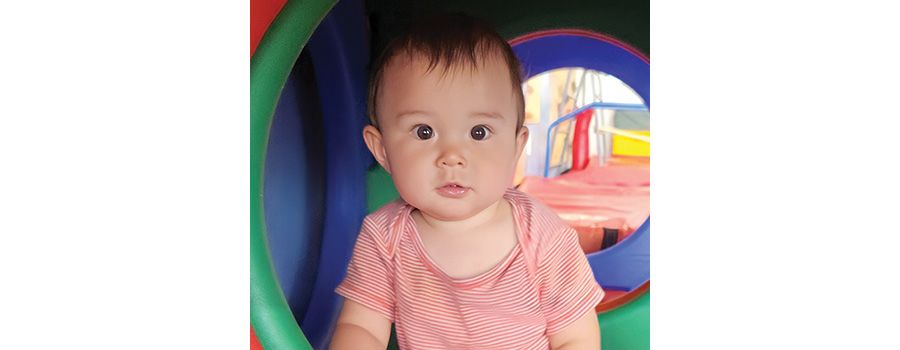
Frank Roetker (SE/CS, 2015) and wife, Vivian, had their first child, Ash, on September 16, 2022. He is a software engineer with Microsoft. The family resides in Kirkland, Washington.

Joy L. (Atzinger) Bosse (CE, 2017) and husband, Jordan A. Bosse (CE 2017), welcomed their first child, son Maddux, on February 3, 2023. The family lives in McCordsville, Indiana. Joy is a project engineer with United Consulting and Jordan is a project engineer with American Structurepoint.

Tucker D. Pletcher (CHE, 2018) and wife, Savhana, had their first son, Evan Michel, on January 15, 2023, in South Bend, Indiana. Tucker is the EHS systems manager with Sun Chemical Corporation in Valparaiso, Indiana.

Travis W. Alexis (EE, 2020) and wife, Emily, had their first child, daughter Rylan, on May 27, 2023. The family lives in Greenwood, Indiana, where Travis is a senior automation engineer with Eli Lilly & Company.
IN MEMORIAM

Boesenberg Introduced the World to Computing
Technology trailblazer, Rose-Hulman trustee, and former Fightin’ Engineer football player Charles “Chuck” M. Boesenberg (ME, 1970), 74, died June 7, 2023, in Saratoga, California. He started his career by selling computers for IBM before going on to lead the sales team with Data General Corporation, one of the world’s first minicomputer firms, and becoming Senior Vice President of Apple Inc.’s U.S. sales and marketing division. Later, Boesenberg was President of MIPS Computer, Chief Executive Officer with Central Point Software, and president/CEO/chairman with NetIQ Corporation, Magellan, and Integrated Systems. Additionally, he served on the board of directors for Rose-Hulman along with such companies as Ancestry, Boingo Wireless, Callidus Software, Macromedia, Maxtor, Silicon Graphics, Symantec, and Websense.
ALUMNI
G. Ronald Runyan (CE, 1955), 91, died October 29, 2023, in Pekin, Illinois. He retired after a 43-year career with Caterpillar Inc. as a chemical engineer.
Harvey A. Greene, J.D. (CE, 1957), 89, died July 27, 2023, in Carmel, Indiana. He retired as an administrative law judge with the Indiana Department of Revenue.
William D. McKee (ME, 1958), 91, died October 15, 2023, in Mesa, Arizona. He retired after nearly 30 years with Chrysler Corporation.
Robert R. Scholle (CE, 1958), 86, died October 16, 2023, in East Lansing, Michigan. He had a 31-year career as a civil engineer with the Michigan Department of Transportation.
H. James O’Donnell Jr. (EE, 1959), 88, died August 11, 2023, in Naperville, Illinois. He retired as an engineer with S&C Electric after spending 25 years with General Electric Company.
Flavian Reising Jr. (EE, 1959), 86, died September 17, 2023, in Louisville, Kentucky. He retired as a senior electrical engineer with GE Appliances, where he worked for 40 years.
Gary M. Reynolds (CHE 1963), 82, died October 25, 2023, in Cicero, Illinois. He had a lifelong career with Firestone Industrial Products, retiring as a leader of international sales.
Michael L. Scherer (EE, 1964), 81, died September 10, 2023, in Lake Wylie, South Carolina. He owned Technetics Corporation for 45 years before retirement.
David L. Hussung (CHE, 1965), 79, died July 9, 2023, in Floyds Knobs, Indiana. He retired after leading Hussung Mechanical Contractors to become one of the largest contractors in Kentucky.
Richard M. Reeves (BSEE, 1965/MSEE, 1966), 79, died July 19, 2023, in Casselberry, Florida. He worked with Confluent, Martin Marietta, Wright-Patterson Air Force Base, and
Naval Avionics.
David A. Skevington (EE, 1966), 79, died August 7, 2023, in Slidell, Louisiana. He retired after many years of service with the New Orleans Police Department.
Randall E. Drew (MA, 1968), 77, died July 23, 2023, in Waynesville, North Carolina. He spent 35 years as a computer analyst with Exelon Corporation.
John S. Newlin (ME, 1969), 76, died August 16, 2023, in Terre Haute. He worked with a variety of companies, including the family-owned Newlin-Johnson Company. Survivors include his father, John T. Newlin (CE, 1943).
Rex W. Mook (MA/ECON, 1974), 70, died July 28, 2023, in Salem, Virginia He spent 33 years as a salesman with
Unisys Corporation.
Robert L. Terkosky (CE, 1974), 70, died May 30, 2023, in Toulon, Florida He worked 40 years with FM Global’s risk management engineering team, opening the company’s Stockholm office.
Anthony G. Rafel (ME, 1975), 68, died July 15, 2021, in Glenview, Illinois.
Mark A. Brotherton (ME, 1978), 68, died August 8, 2023, in St. Mary’s, Ohio.
Russell E. Holcomb (ME, 1978), 67, died July 18, 2023, in Summerville, Georgia. His career included being part-owner of TaxWise and an Entrepreneur- In-Residence at Rose-Hulman.
Michael B. Dolan (ME, 1980), 65, died July 1, 2023, died in Dallas, Texas. He was a manufacturing engineer with
Texas Instruments Inc.
Jeffery L. Taylor (CS, 1984), 61, died November 3, 2023, in Rushville, Indiana. He worked with L3Harris.
Curtis D. Wehrley (CHE, 1985), 60, died September 20, 2023, in Indianapolis. He was a data scientist with General Mills Inc.
Kirk A. Klentz (EE, 1988), 57, died September 20, 2023, in Beavercreek, Ohio.
Allen D. Stucker (CHE, 1988), 57, died July 24, 2023, in Robinson, Illinois. He was an engineer with Marathon Petroleum Company for more than 30 years.
Kyla A. (Lutz) Collins, PhD (BE/MA, 2011), 34, died July 4, 2023, in Indianapolis. She was a research scientist with Eli Lilly and Company, where she was involved in researching diabetes and complications related to diabetes. Survivors include her husband, Benjamin D. Collins (CHE, 2010).
Connor G. Gerhart (CE, 2015), 31, died June 1, 2023, in Pacific Beach, California. He was an assistant project superintendent with Clark Construction.
FACULTY/STAFF/FRIENDS
Gary D. Harrison, 74, died July 31, 2023, in Rosedale, Indiana. He retired after being a locksmith with the Office of Facilities Operations.
Carol A. Redington, 64, died July 11, 2023, in Terre Haute. She was a longtime custodian in the apartment residence halls.
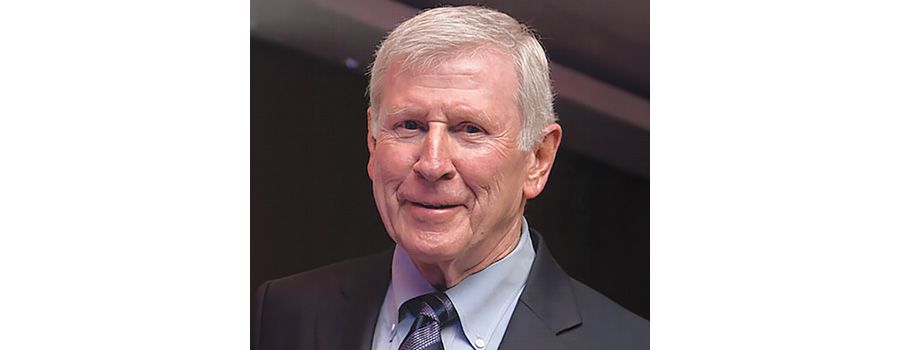
Scott Insured Institute’s Future as Devoted Trustee
Longtime Terre Haute business and community leader and devoted Rose-Hulman trustee Donald W. Scott, 87, died May 27, 2023, in his hometown. His relationship with Rose-Hulman included leading the Board of Trustees’ Executive Committee, supporting the successful Vision to be the Best fundraising campaign in the 1990s, and strengthening the institute’s ties with Terre Haute. His business career was primarily spent in the insurance business, being President of Sycamore Agency, Inc., and Chairman/Chief Executive Officer of ONB Insurance Group, Inc., where he retired in 2003. Scott later became a member of Lloyd’s of London and was involved in several successful business enterprises along with contributing to the Greater Terre Haute Chamber of Commerce, Alliance for Growth and Progress, and Terre Haute YMCA.
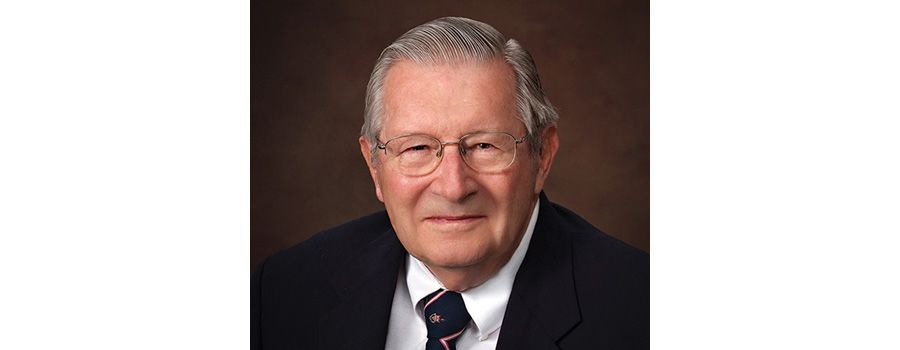
Royer Energized His Hometown Through Work & Service
Home was where the heart was for former Rose-Hulman trustee Robert L. Royer (EE, 1949), 95, who died March 5, 2023, in Louisville, Kentucky. He was proud to serve his hometown as President, Chief Executive Officer, and a Director with Louisville Gas and Electric Company, retiring in 1990 after a 40-year career. He also provided service to several community organizations, including the Louisville Education and Employment Partnership, Leadership Louisville, and Spirit of Louisville Foundation. He also was a guiding force with the Louisville Chamber of Commerce, Campaign for Greater Louisville, Kentucky Derby Museum, Louisville Industrial Foundation, Kentucky Science and Technology Council, and Kentucky Energy Research Board. He had a love of Boy Scouts and amateur radio since childhood.
Design Your Own
AI Generated R
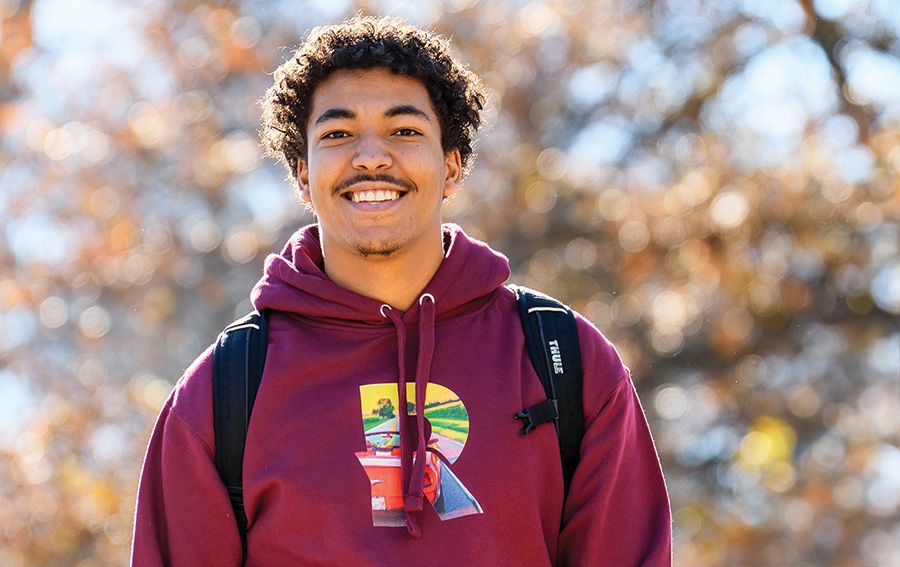
Show off your creativity and help Rose-Hulman students by having a one-of-a-kind Rose-Hulman T-shirt or hoodie.
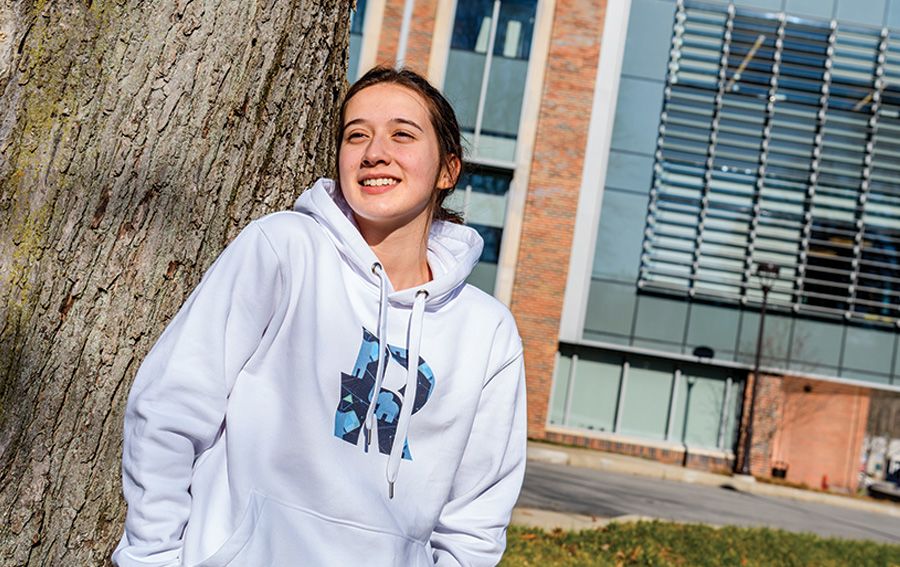
Proceeds from all sales go to Rose-Hulman’s Generative AI Fund, which supports creative student engineering projects. This would include competition teams, Team Rose Motorsports, Rose Rocketry, Robotics Teams, and other student projects.
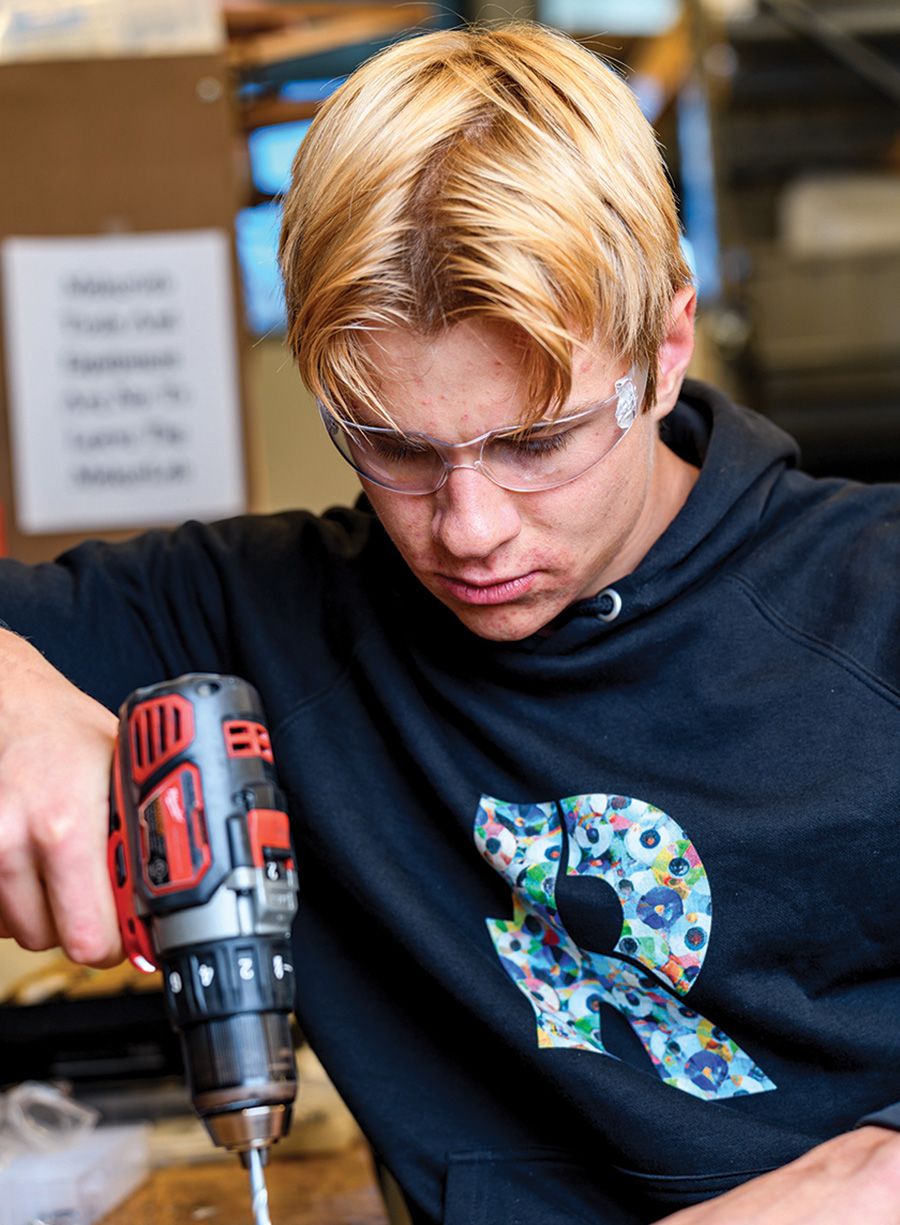
Place your orders at https://drophouse.rose-hulman.edu




